-
Posts
546 -
Joined
-
Days Won
6
Content Type
Profiles
Forums
Events
Blogs
Posts posted by windwithme
-
-
Intel has just launched the Ivy Bridge platform, and the price seems to be positioned in middle to high range of the desktop market.
The high-end Z77 Ivy Bridge chipset has also become the main objective for performance among all of the motherboard brand competitors.
While in recent years ECS has mainly focused on the OEM business, in the last few years, the company has been more active in launching its own brand of motherboard products.
ECS has launched four new products based on the ATX Z77, together with about four products based on the H77.
Currently, the ECS product line has a wider range of selections for the Ivy Bridge platform than before.

High-end motherboards often appear in colors such as black, red, green, orange and white, yet the ECS Z77 comes in a very rare color.
From the website information, it seems that the Z77H2-A2X and the Z77H2-AX both emphasize the use of gold as their color.
The other three ECS Z77 products are almost the same as earlier products with black PCBs that are supplemented by gray and white versions in the entry-level Z77H2-A2X,
which is ECS’s mid-level Z77 motherboard model, and the highest level product is the Z77H2-AX.
The ECS Z77H2-A2X
Besides the black PCB, the first thing you see is that other parts of the system almost all have a gold glitter.
Even the solid-state capacitors and inductors are gold, and this design really makes a unique impression in the hearts of users.
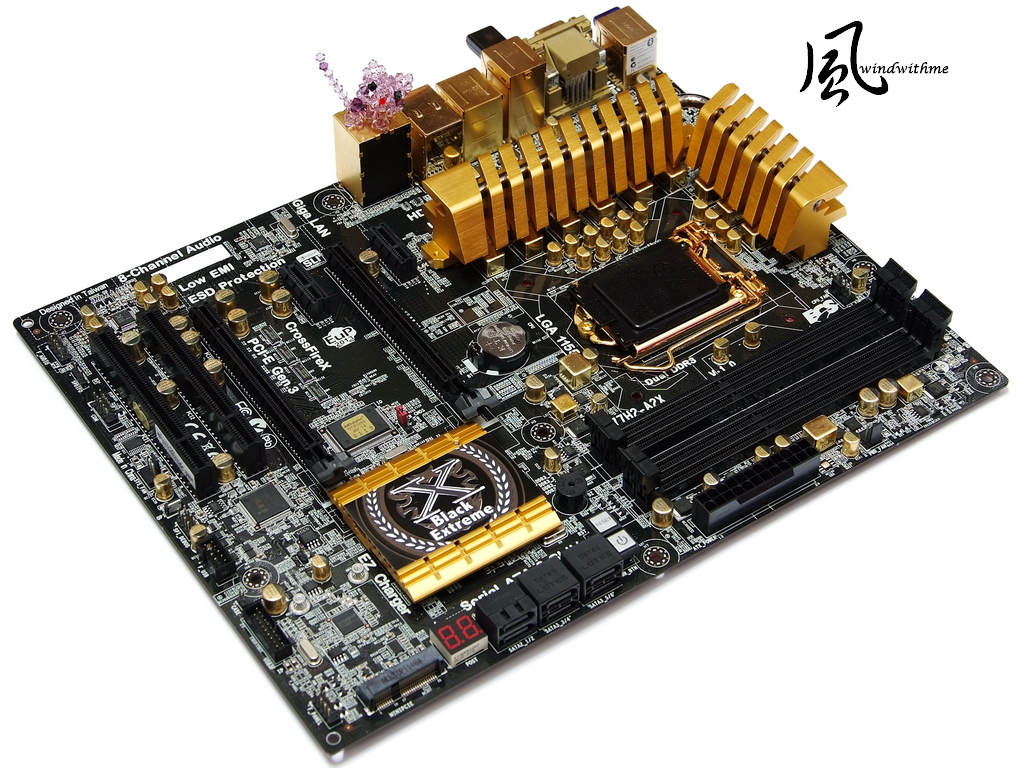
Gold 4Ever is the main appeal, including the golden quality, the golden stability, the golden heat dissipation and the golden appearance.
But it is unclear whether the company is promoting these standards, because in some situations, the user only has this impression after using the products for a long time.

Accessories Included
English user manual, quick-start manual, golden IO panel, driver software CD
SLI bridge, protective plastic cover for IO ports, mobile connect wireless.
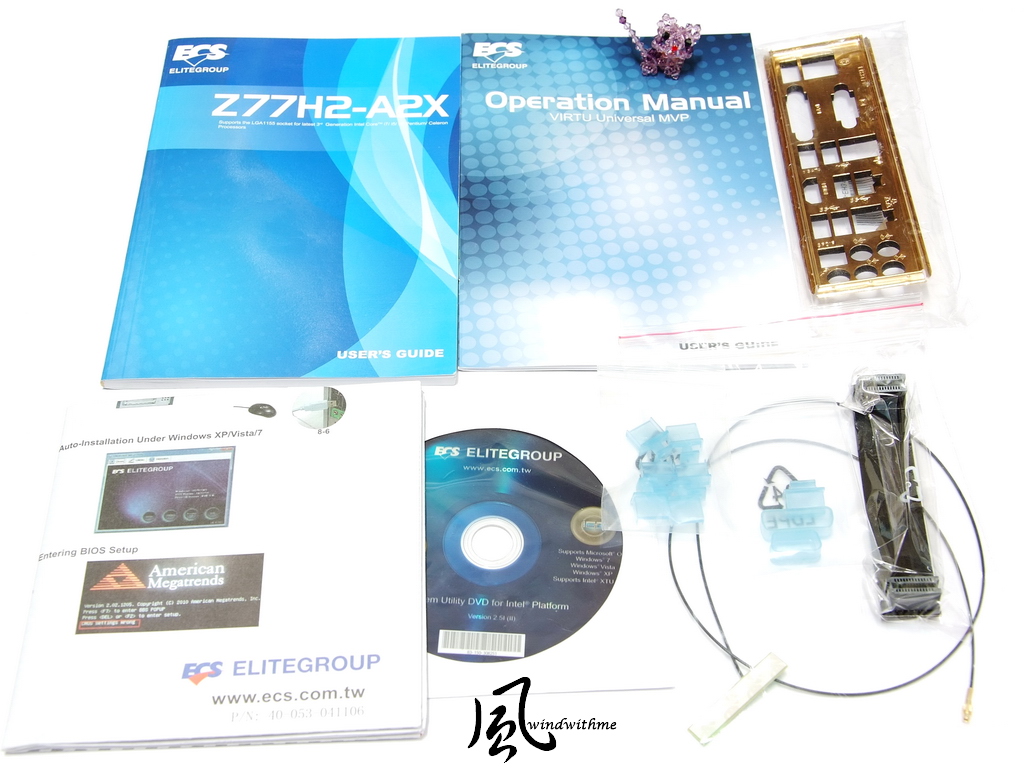
SATA Cable, Front USB 3.0 Panel
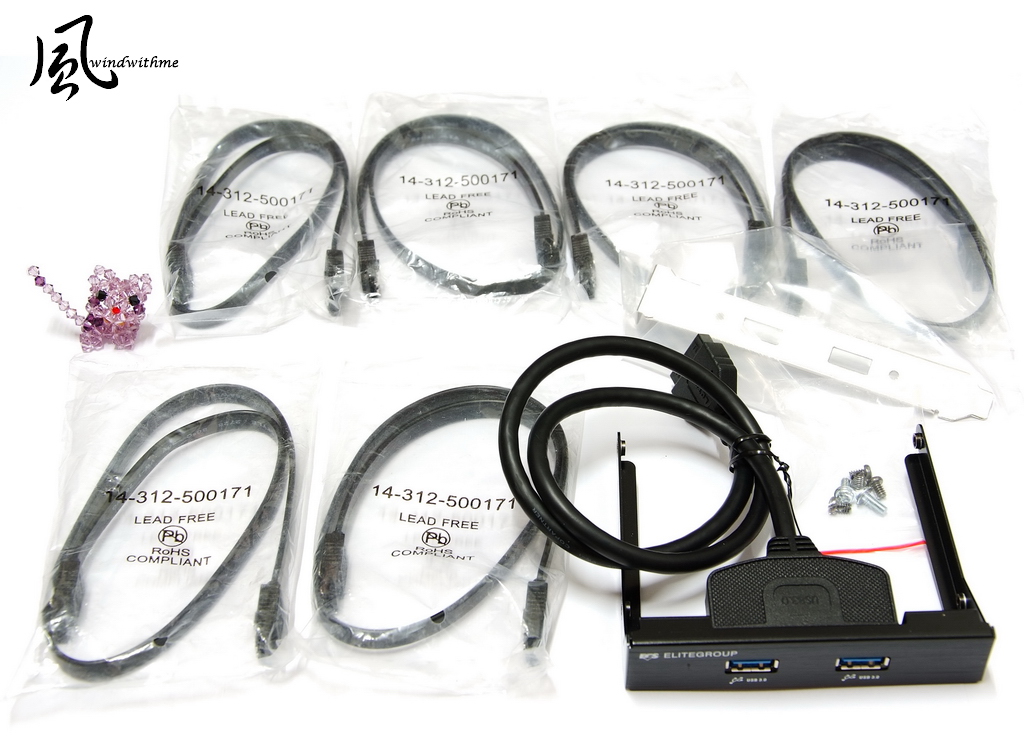
Lower Left of Motherboard
2 X PCI-E X16 Gen 3.0, supporting AMD CrossFireX / nVIDIA SLI technology
Two VGA bandwidth cards X8 + X8
2 X PCI-E X1
2 X PCI
The network chip is the Realtek RTL8111E.
The sound chip is the Realtek ALC892 with eight channels that supports HD Audio technology.
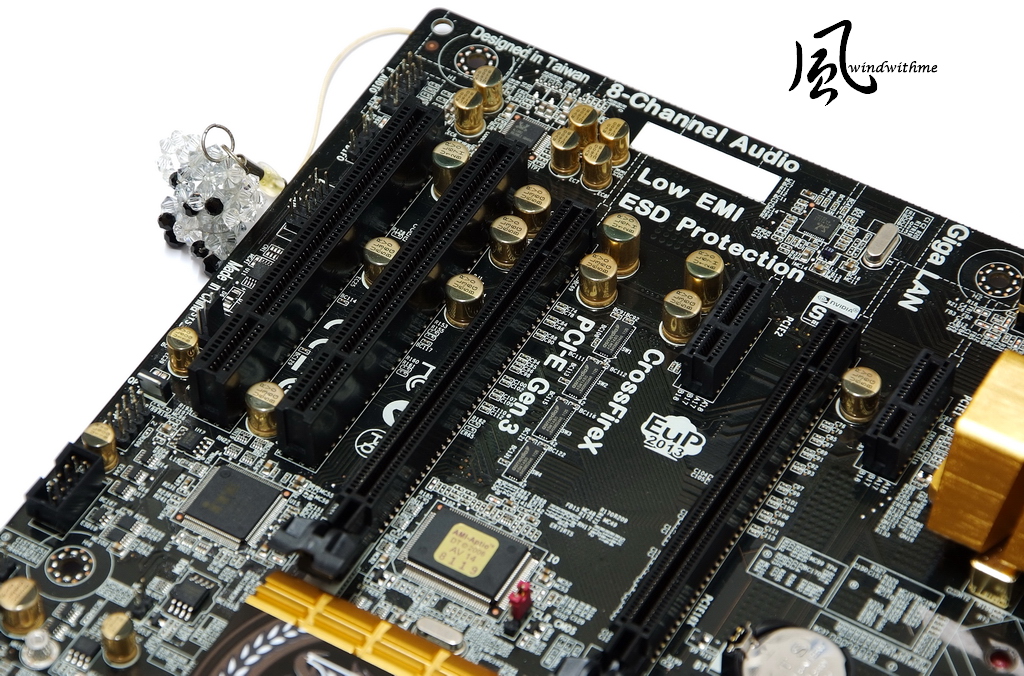
Bottom Right of Motherboard
2 X Black SATA ports, Z77 chipset provided, SATA3 specification
2 X Black SATA ports, Z77 chipset provided, SATA2 specification
Above can be combined to set up RAID 0, RAID 1, RAID 5 and RAID 10, with the top performance determined by the installed SATA devices
2 x Black SATA ports, ASM1061 chip provided, SATA3 specification, support for AHCI
1 x Mini PCI Express port, supporting Mini SATA and Mini PCI Express
Power / Reset button and debug LED lights. On the left, the black connector is the front USB 3.0 port
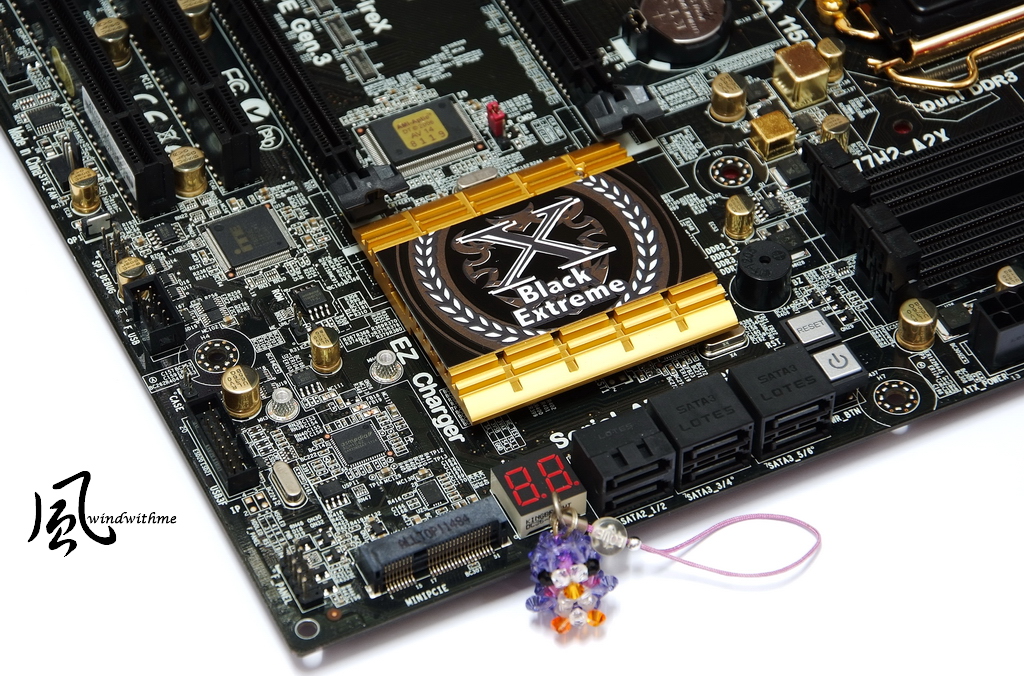
Upper Right of Motherboard
4 X DIMM DDR3 supporting 1600/1800/2133/2400/2600/2800 (OC), maximum capacity for DDR3 up to 32GB
Supporting Extreme Memory Profile technology. Below is the 24-pin power input.
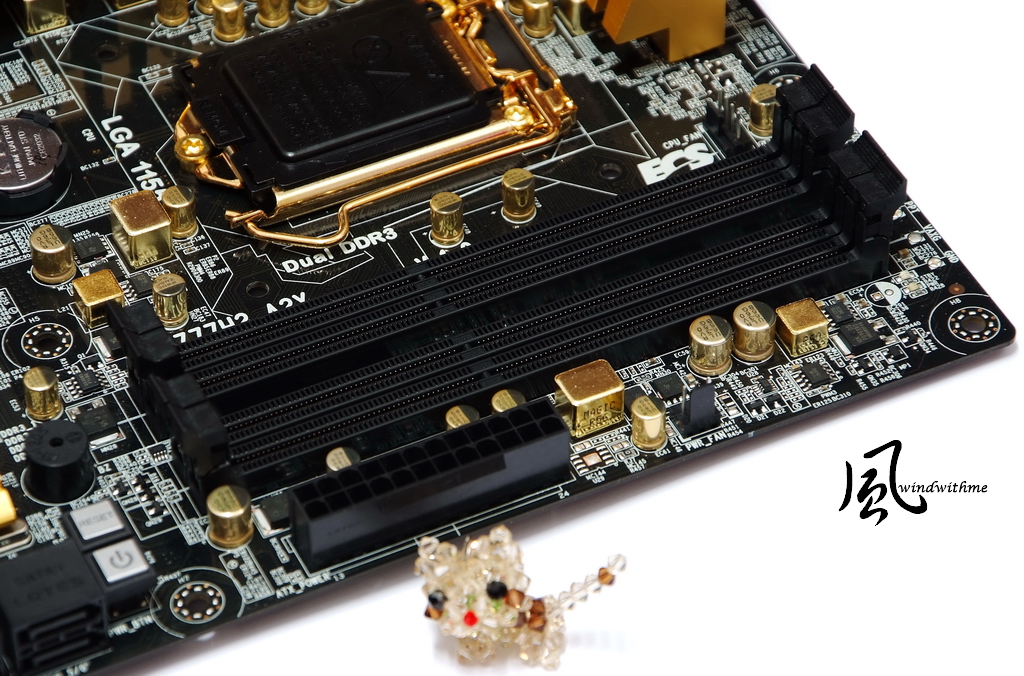
Beside the CPU, the power supply is designed with eight outputs, and in the upper portion, behind the cooling module is an 8-pin power input.
New LGA 1155 protective cover, making usage more convenient

IO
1 X Bluetooth Dongle
3 X USB 2.0 Ports (Red/Black)
1 X D-Sub / DVI-D/HDMI
1 X Wireless LAN Dongle
1 X eSATA3/USB 2.0 Ports (Red)
4 X USB 3.0 Ports (Blue)
1 X RJ-45 Ethernet Port
6 x Audio Jacks
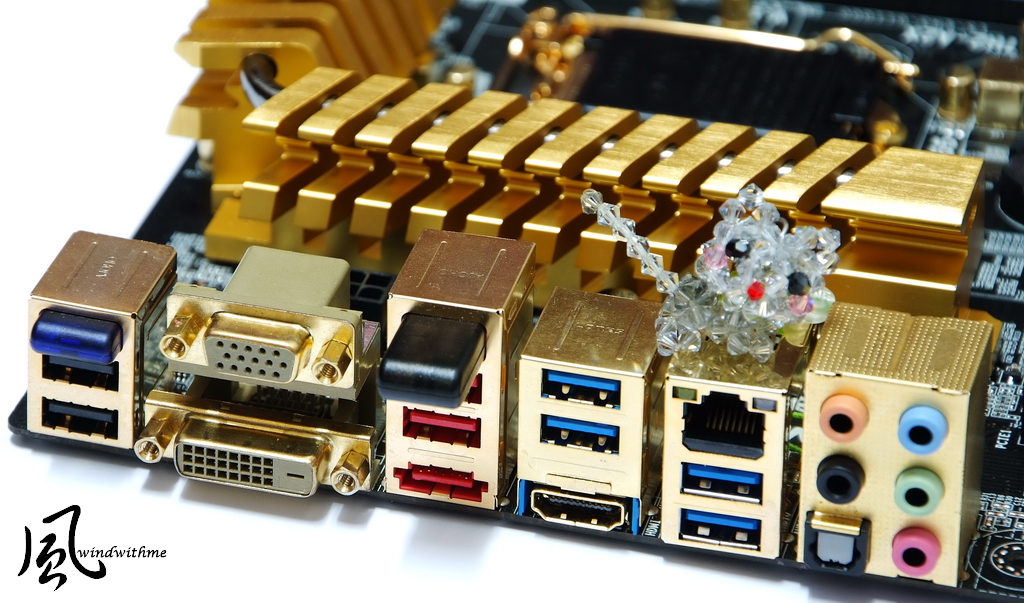
-
Vengeance 1500 has exclusive driver and software.
There are three modes and many details to fine tune the sound quality.
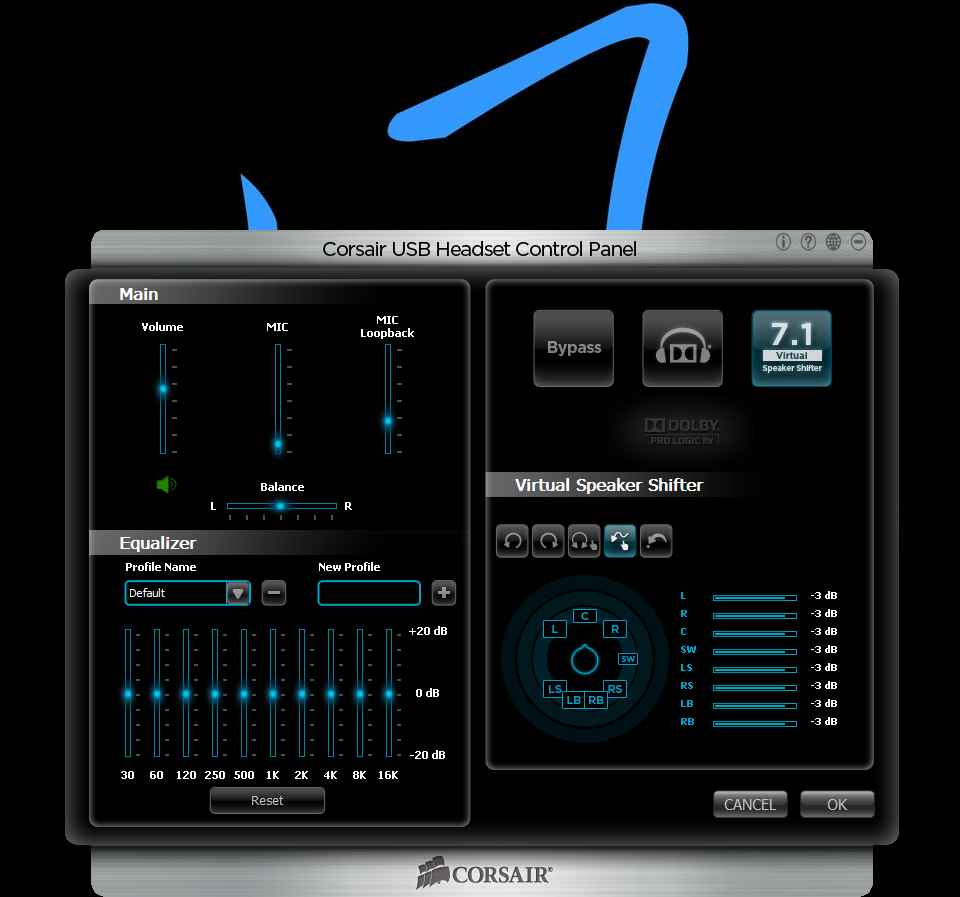
Vengeance 1500 position on Gaming segment, the bass is very good. It’s low but not stiff.
In game scene, you can hear all details. The position in sound files is also very clear.
When I use game profile, Vengeance 1500 is full of live feeling and sound-surround ambiance.
If you like listening music, it’s also very good level. Only mid-frequency needs to be improved.
Unfortunately, it use USB built-in audio chip. If the headset can work with Creative CA0132, I believe the sound quality will be much better.
3D Performance - SPARKLE GTX570 SLI
3DMark Vantage => P47338

StreetFighter IV Benchmark
1920 X 1080 => 397.73 FPS

FINAL FANTASY XIV
1920 X 1080 => 7591

Unigine Heaven Benchmark 3.0
1920 X 1080 => 115.5 FPS

GTX570 is former mid-high VGA, however its’ 3D performance is still good.
After enabling SLI, 3DMark Vantage performance improved a lot.
The other 3D benchmark software is also enhanced by SLI.
SLI 3D performance will be vary by different software. G1.SNIPER3 can support up to 4Way VGA to maximize the expandability.
Diablo3
1920 X 1080 special effect at highest => 163 FPS
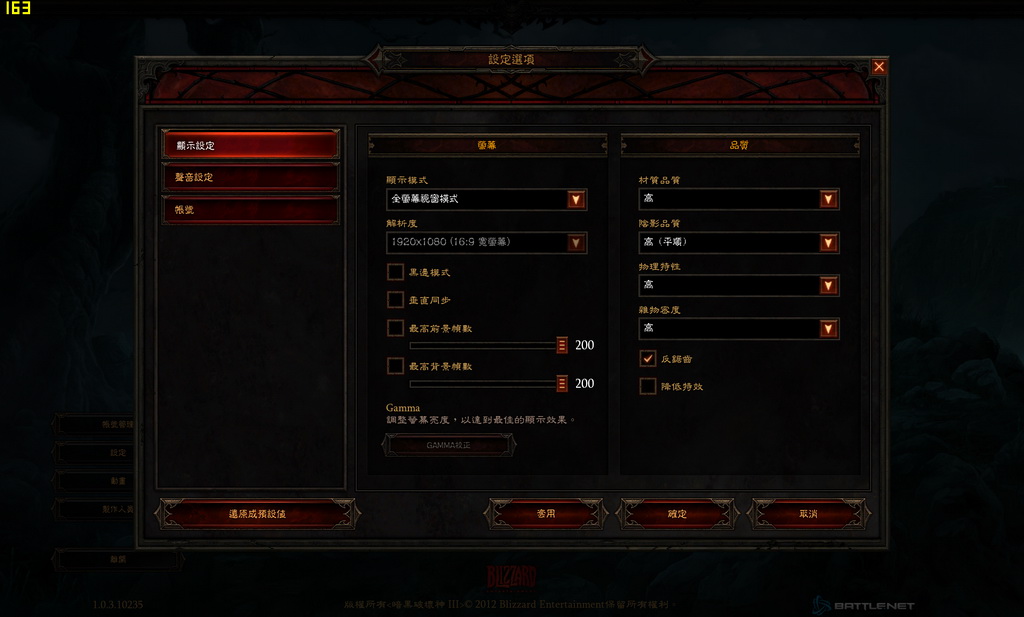
In Town => 171 FPS

Standard single person game is around 97 FPS
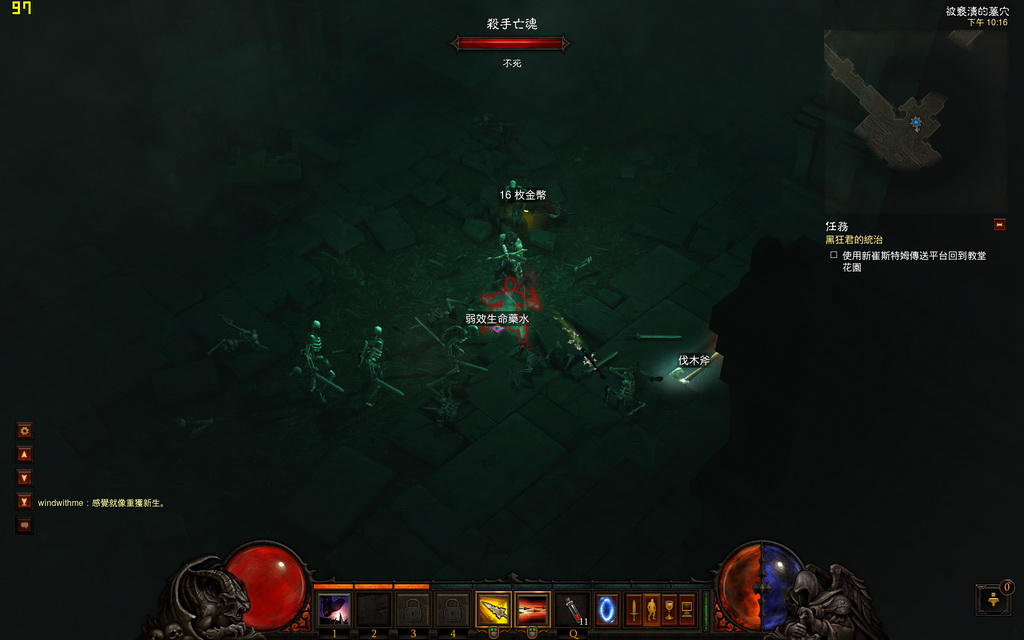
As easy to capture the screen, I set at window mode. The page shows 163 FPS.
If you use full screen, the page number will up to 210 FPS. The number is vary by resolution.
Diablo3 updated revision and some setup, it fix the 100FPS limitation issue.
This recent most popular game 3D requirement is not so high, AMD Redaon 7770 is capable to run already.
GIGABYTE G1.SNIPER3
Pros
1.G1-Killer packing is more delicateness than the other high end model. The heat sink is looking better than G1 X79.
2.Creative latest CA0132 audio chip with Japanese high end capacitors, new software and more supported technologies improve sound effect.
3.Dual LAN support by latest Killer E2200 network NPU and Intel LAN chip
4.Exclusive BT4.0 / Wi – Fi card to enhance application with all mobile devices.
5.Front control panel supports USB 3.0 and real time OC features. It also supports headset amplifier which is very rare.
6.Supports up to 4-Way AMD CrossFireX/nVIDIA SLI technology.
7.BIOS native support Xeon V2 CPU.
Cons
1.CPU voltage vibration during standby and full speed should be smaller.
2.4DIMM DDR3 OC should be same as 2DIMM DDR3
3. Audio or LAN can be daughter card

Performance ★★★★★★★★★☆ 90/100
Components ★★★★★★★★★☆ 88/100
Specification ★★★★★★★★★☆ 92/100
Appearance ★★★★★★★★★☆ 86/100
C/P Value ★★★★★★★☆☆☆ 72/100
Intel Ivy Bridge structure has been launched over 3 months.
New 22nm CPU has three advantages, higher performance, lower power consumption and better IGP 3D performance.
For the temperature, when OC to 4.8GHz, it’s 5 degrees higher than SNB which is needed to improve.
PCI Express Gen3, Intel Smart Connect / Quick Sync 2.0 and Lucid Universal MVP all brings more advantages to new platform.
However, Ivy Bridge CPU only has i5 and i7 currently. I do hope i3 and Pentium series can come faster.
It will complete the Intel CPU product line and have more choices for entry PC market.
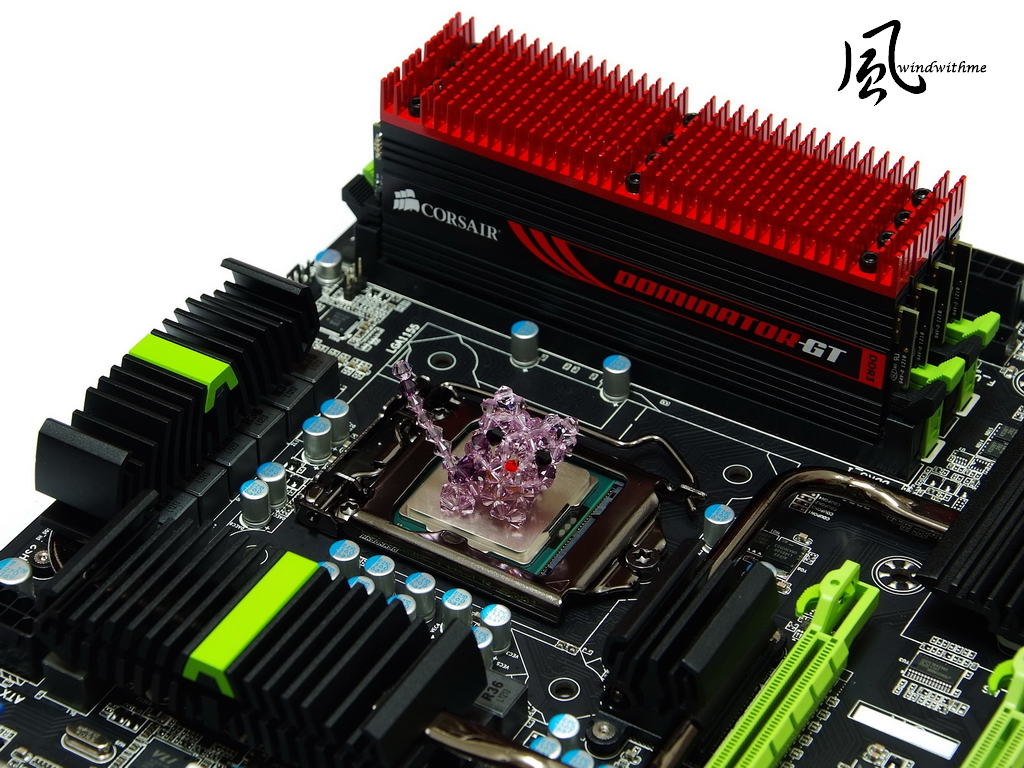
GIGABYTE G1.SNIPER3 is cheaper than former G1 models. This is Z77 benefit.
G1.Killer is still in high end MB position. It’s more suitable for higher requirement and budget users.
Last G1 X79 thermal module is not good looking. This time, G1 Z77 revision is much better looking and quality.
In high Loading mode, the temperature is around 50~55 degrees. It’s very good though.
Gaming design is even improved. Audio chip changes to Creative latest CA0132 quad-core audio processor.
LAN chip also improves from single Killer NPU to Killer E2200 plus Intel, dual LAN.
You can see many improvement and progress in G1 Z77. It fixes several G1 cons.
Of course, it’s still some minor points to make it perfect. I am glad to see better G1 in further chipset.
If you are looking for best built-in LAN and audio chips, also high end gaming specs, you can put GIGABYTE G1.SNIPER3 in your wish list:)
This article is also post in my log.
WIND3C, All comments are welcome.
-
Power Consumption Test
Enter to OS Desktop - 168W

CPU Full Speed by Linx - 268W

3770K OC to 4.8GHz and using GTX570 SLI both consume more power. When enter to OS desktop, it’s 168W already.
For former review, 3770K default with IGP HD4000 is only 34W. This is very good power consumption performance.
You can see when we OC 3770K to 4.8GHz, full speed only consume 100W more. It approves 22nm saving more power.
When we run this high end Gaming platform in 3D test software, the power consumption is 600W. Most is by VGA.
Former G1.Killer series use Creative CA20K2 audio chip. This time, G1.SNIPER3 changes to newer Creative CA0132.
It’s Creative Sound Core3D quad-core audio processor. It supports THX, CRYSTAL VOICE, and so on.
Using Nichicon MUSE ES series and MW series Bi-Polarized audio capacitors makes spec and components similar to high end audio card.
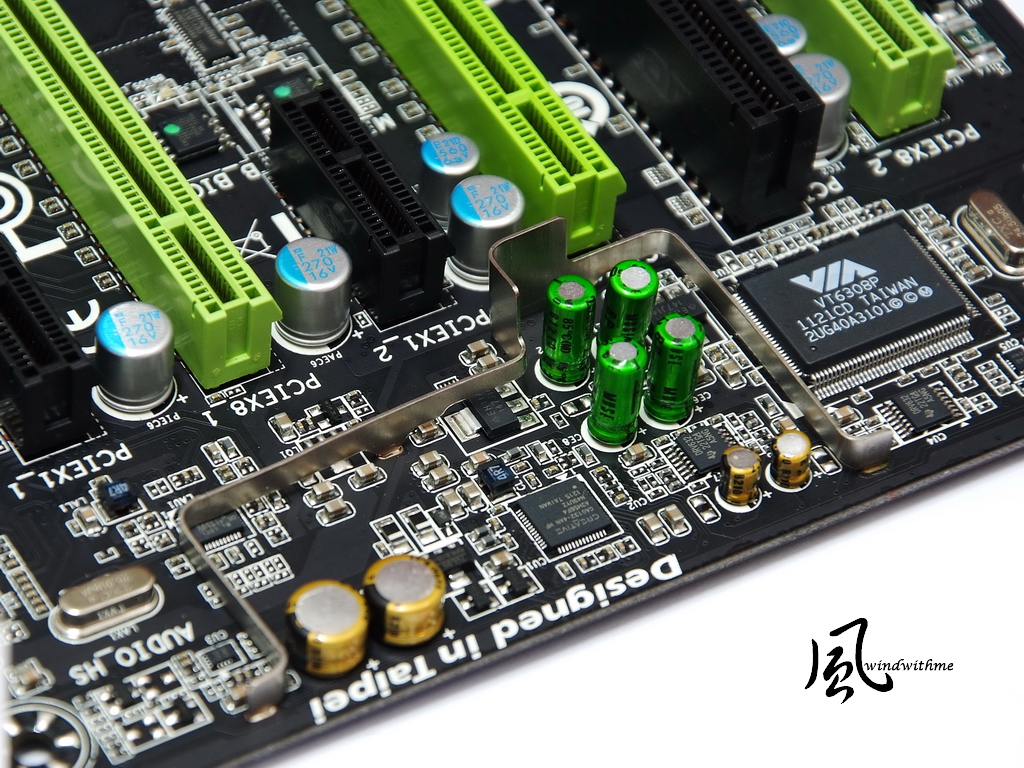
Let’s see the Creative CA0132 new interface.
The first screen emphasize the THX audio technology.

CRYSTAL VOICE setup page
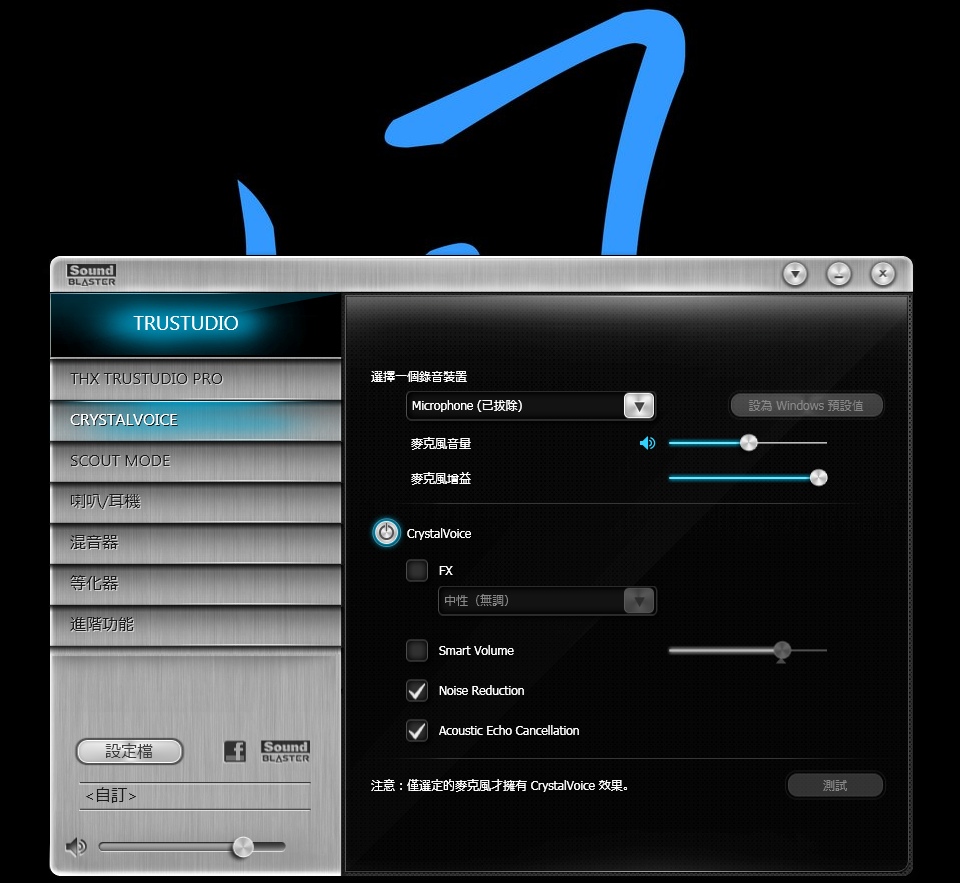
SCOUT MODE items are more for Gaming
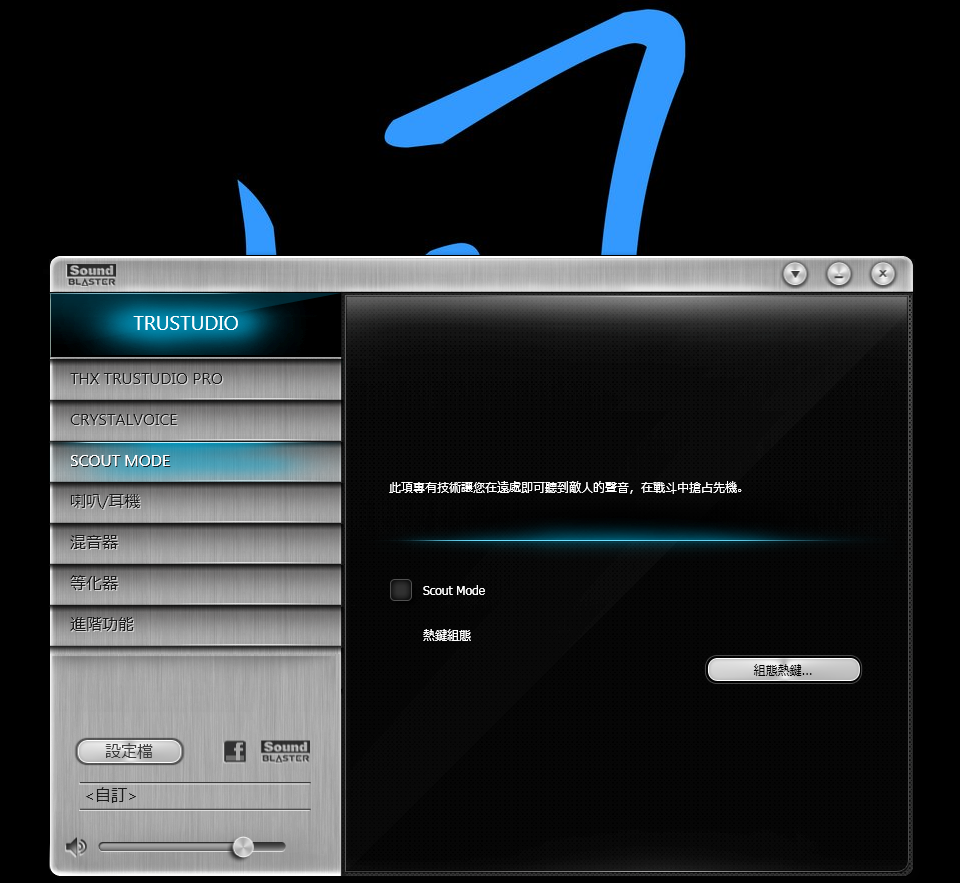
Speaker/Headset setup page. It supports 5.1 channels and some detail items.
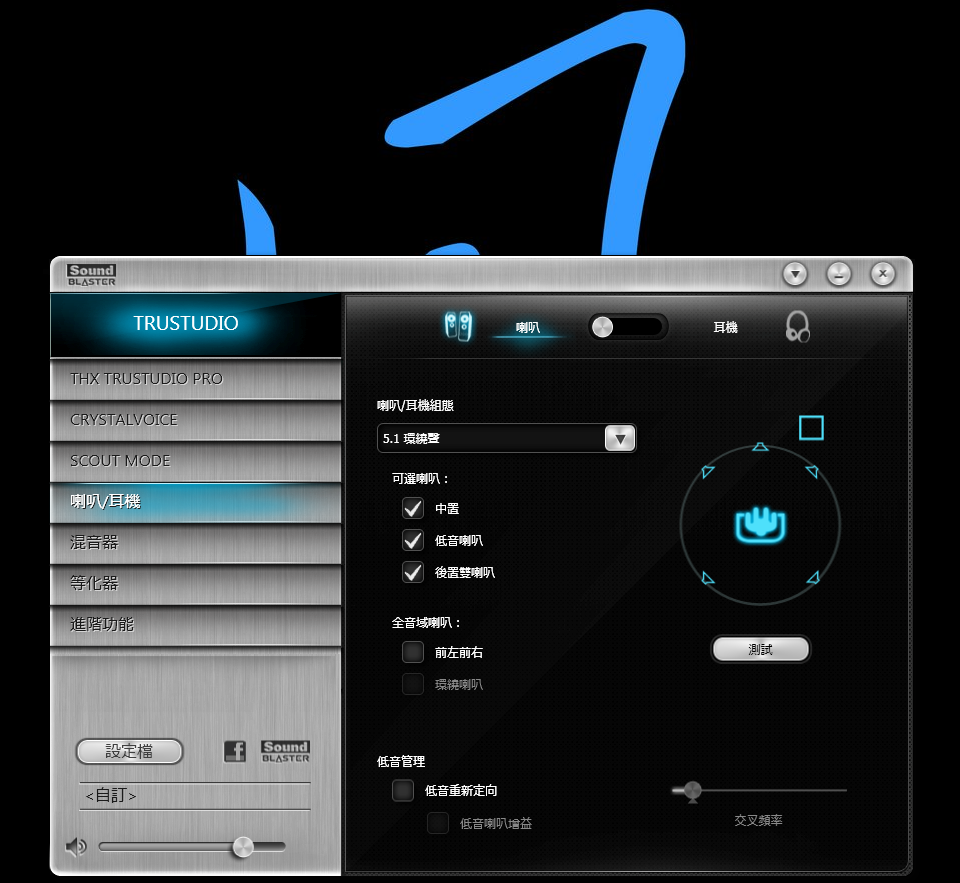
Every channel voice volume and REC control.

My 3.5mm headset only has SONY NOISE CANCEING level. The audio quality is not too high.
I still can use it to distinguish Creative CA0132 and Realtek ALC898 chips.
Creative CA0132 has more background detail. The low-frequency is stronger.
The high-frequency is not too shrill. The mid-frequency is gruff and deep.
Comparing to last CA20K2, mid-frequency and sound field are richer. The software also has more features and practical.
Realtek ALC898 voice is very monotonous. It has much less detail, also over shrill in high-frequency.
It’s high end Gaming platform, so I use gaming headset to test the audio.
I use CORSAIR Vengeance 1500 Dolby 7.1 USB Gaming Headset to experience.
CORSAIR launched several Gaming line up. Headset is one of it.
Let’s see the Vengeance 1500 packing first. It’s official 2 years warranty.
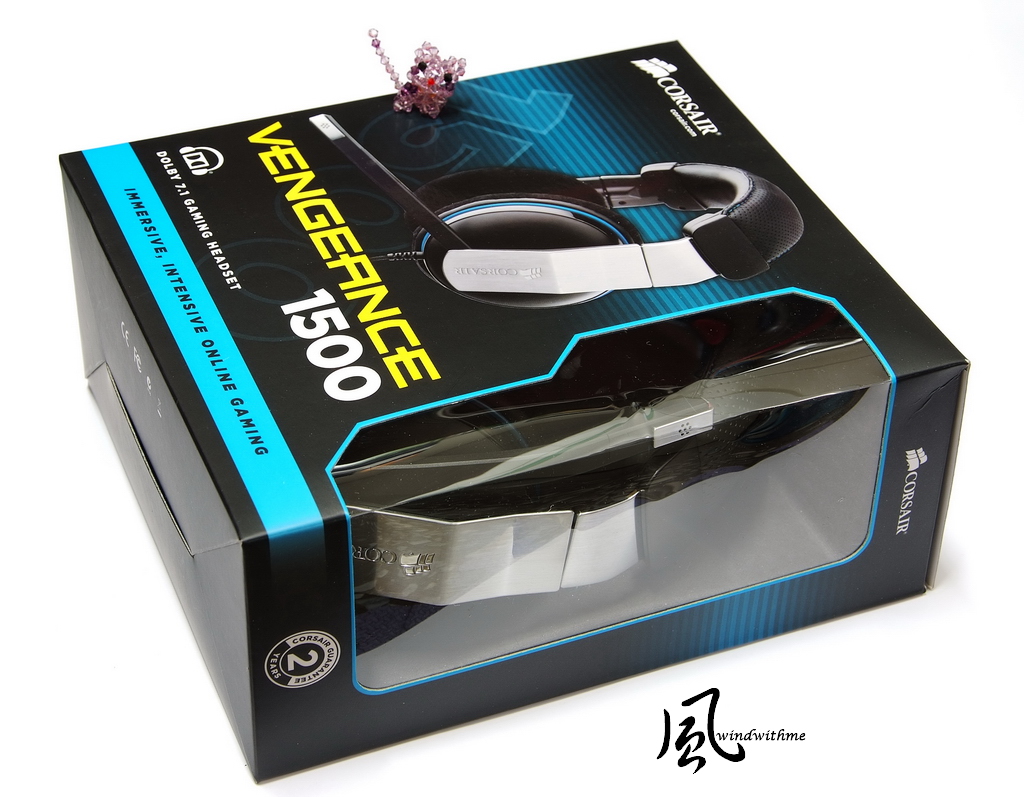
It’s surrounding design to enhance users comfort. I don’t feel any uncomfortable after use.
The controller can adjust the microphone on/off and volume. Both sides are silver color laminated cover with hair-line surface treatment.
Overall, the quality and texture is quite high end. If the cable can use gold plating, it will be even better.
It also provide microphone, you can talk with your partners in games.
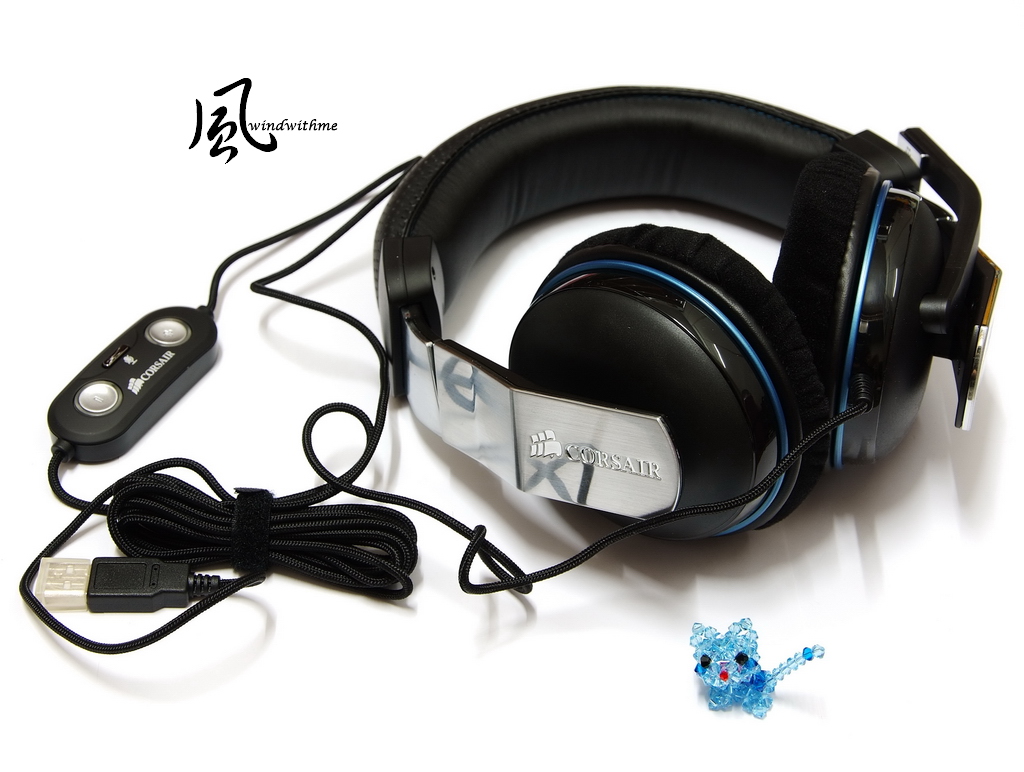
-
Test Configuration
CPU: Intel Core i7-3770K
MB: GIGABYTE G1.SNIPER3
DRAM: CORSAIR DOMINATOR-GT CMT16GX3M4X2133C9
VGA: Intel HD Graphics 4000 / SPARKLE GTX570 SLI
HD: SanDisk Extreme 240GB
POWER: CORSAIR AX650W
Cooler: CORSAIR Hydro Series H100
OS: Windows7 Ultimate 64bit

CPU 100.0 X 48 => 4801.62MHz(Disable Turbo Boost and C1E)
DDR3 2400.8 CL10 12-11-27 1T(Enable XMP mode)
Hyper PI 32M X8 => 11m 26.916s
CPUMARK 99 => 754

Nuclearus Multi Core => 35250
Fritz Chess Benchmark => 37.34/17924
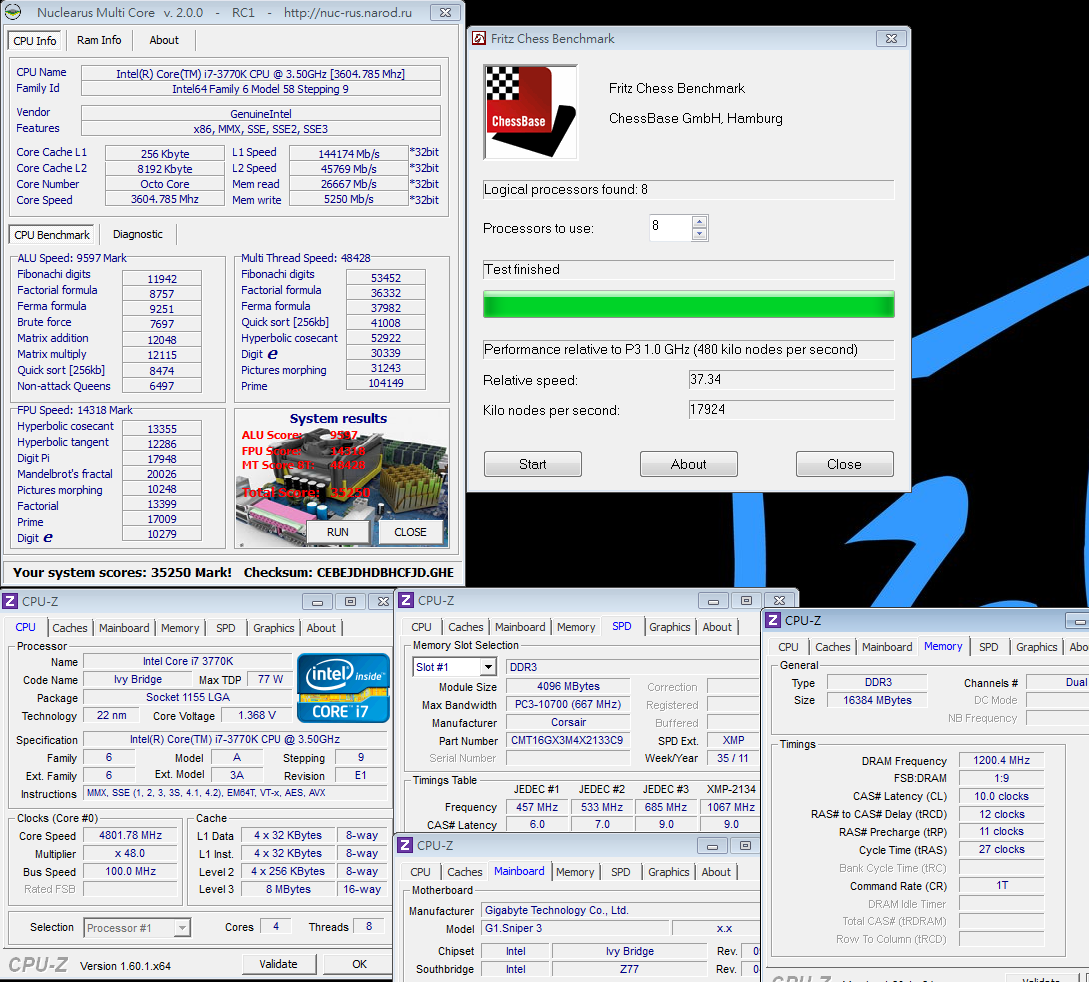
CrystalMark 2004R3 => 403997
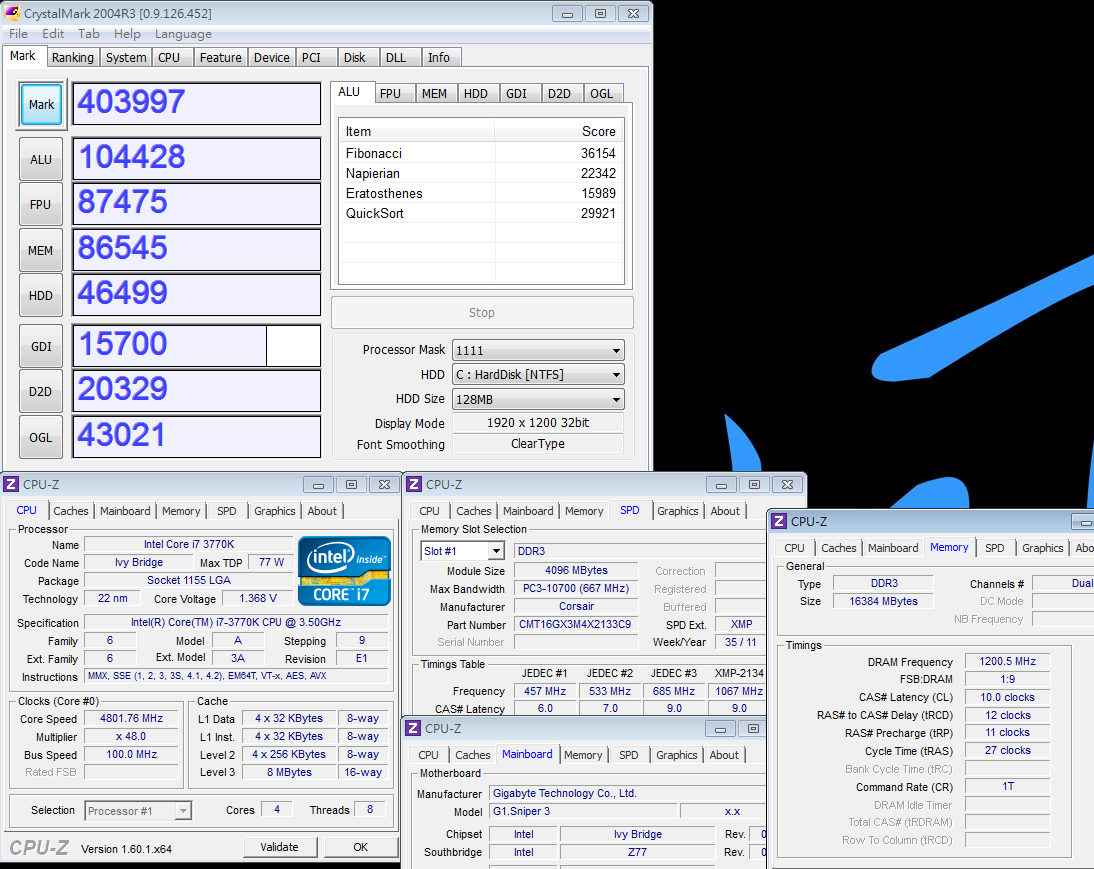
CINEBENCH R11.5
CPU => 9.58 pts
CPU(Single Core) => 2.04 pts

FRYRENDER
Running Time => 3m 52s

PCMark Vantage => 28723

3rd Core i7-3770K compares to windwithme shared 2nd Core i7-2700K.
With same frequency, 3770K single thread performance is 3~6% higher and 4C8T is 10~14% higher.
i7-3770K and i5-3570K performance have 30% difference at same clock. It’s similar to Sany Bridge.
I have shared four Ivy Bridge articles. I hope you can understand 4C8T CPU more.
DRAM Bandwidth Test
DDR3 2400.8 CL10 12-11-27 1T
ADIA64 Memory Read - 24018 MB/s
Sandra Memory Bandwidth - 27725 MB/s
MaXXMEM Memory-Copy - 29187MB/s
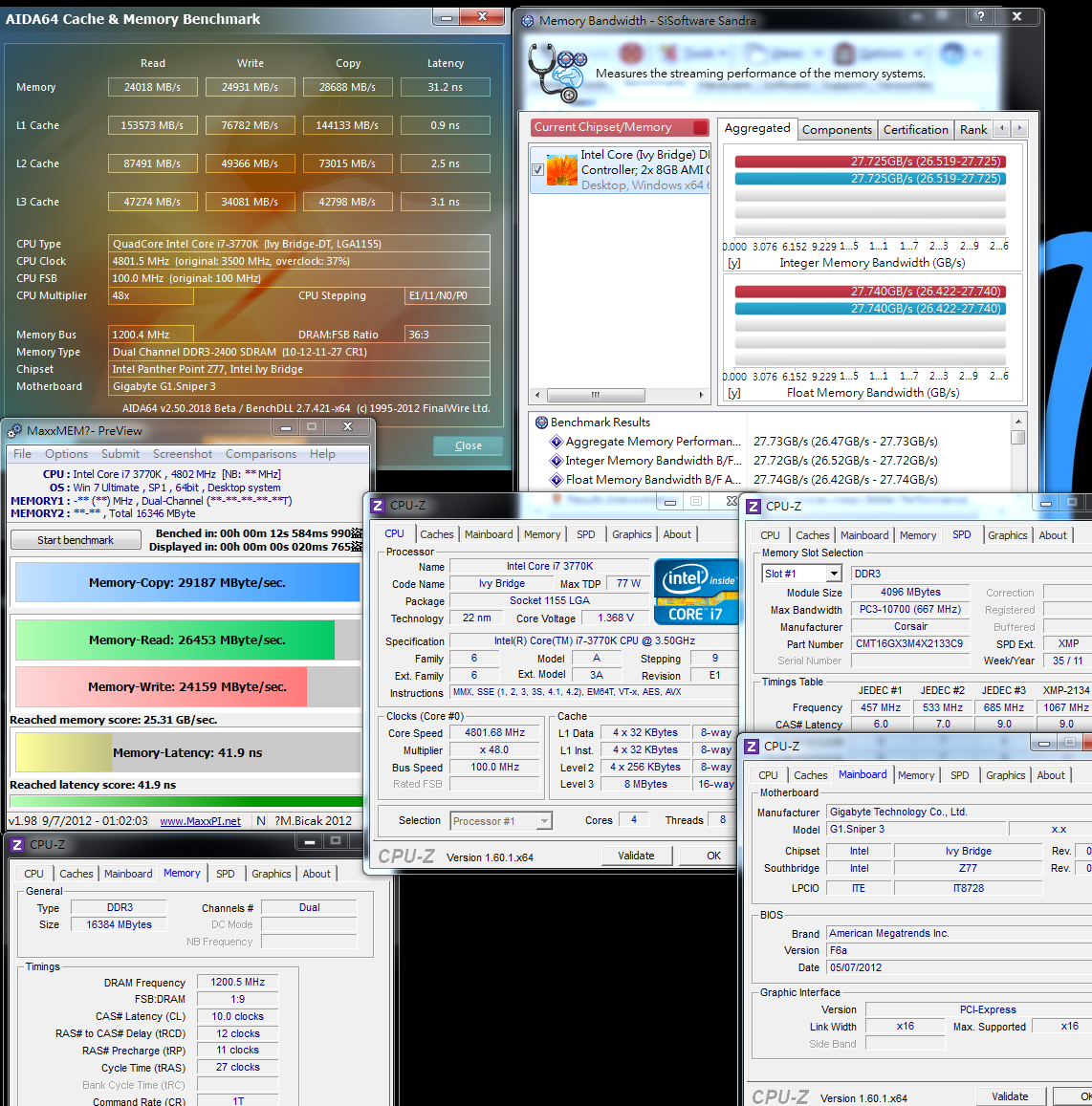
G1.SNIPER3 with CORSAIR DOMINATOR-GT DDR3 2133 can reach 2600 2T stabilize at 2DIMM installed.
4DIMM is DDR3 2400 1T stable. As Ivy Bridge structure, it’s standards above OC performance.
If you have better quality DDR3, you may reach DDR3 2666 above.
For users who look for higher DDR3 frequency, Z77 chipset and better OC MB are good combo for you.
Temperature Test (Room Temp. 29~31˚C)
Enter to OS Desktop - 41~53

CPU Full Speed by Linx - 82~88

I use market top water cooler, H100. When OC to 4.8GHz, the temperature is around 80~90.
One reason is summer room temperature will make full speed higher 5~10 degrees.
The other reason is Ivy Bridge temperature is higher 5 degrees than Sandy Bridge. You have to watch out the temperature after OC.
-
The PWM is all digital design. There are 17 phases divided into 12-phase CPU, 1-phase VTT, 2-phase DDR and 2-phase GPU.

IO
1 X PS2 KB/Mouse
1 X D-Sub / DVI-D / HDMI / DisplayPort
6 X USB 3.0/2.0(Blue)
2 X RJ-45 LAN
1 X S/PDIF optical output
5 X audio jacks
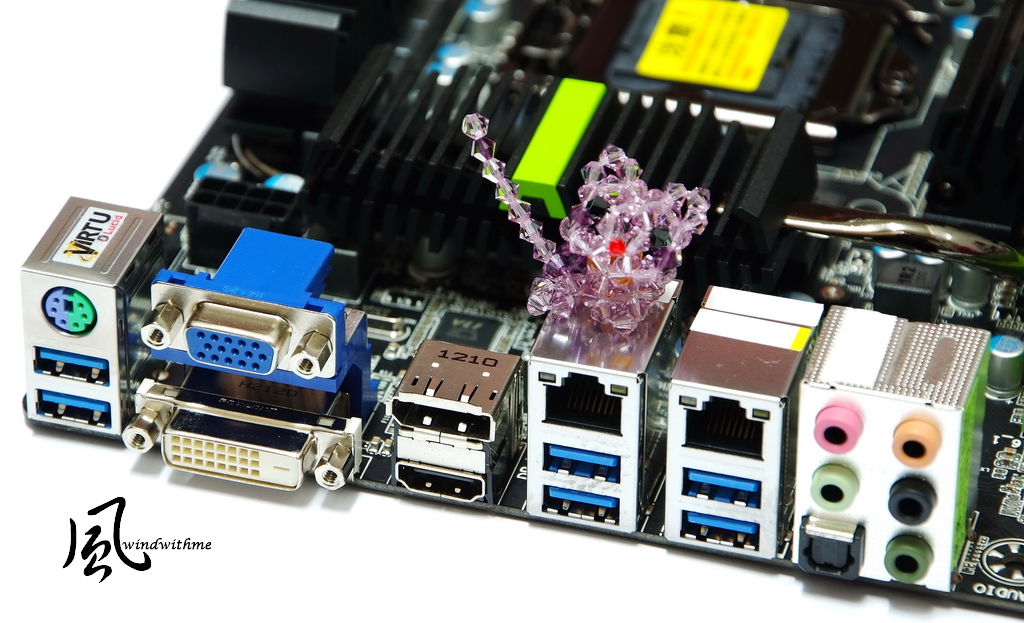
mSATA SSD slot for small capacity SSD users.
Bundling with Intel Smart Response technology, you can enhance your system performance. After installing mSATA, SATA2 5th port will not work.

Even though heat sink is still gun liked design, the military feeling is not as strong as former G1.
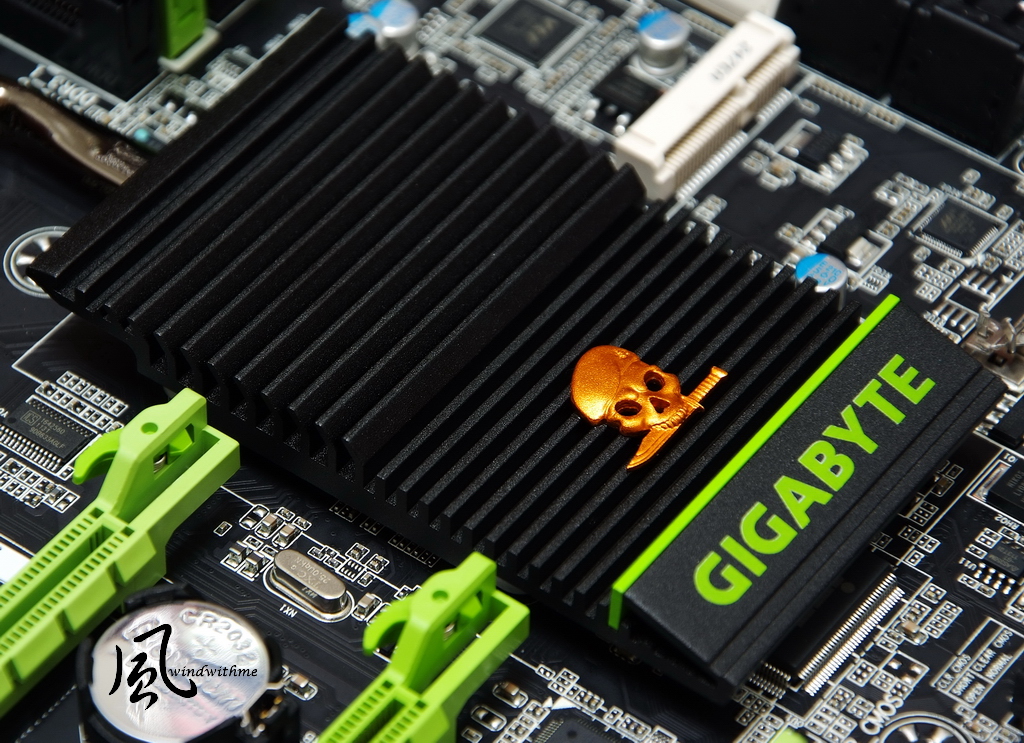
VRM heat sink new design provides more surface. The appearance is better than former design in my own opinion.
The matte processed design makes better texture. Also the radiating ability is better.

UEFI Interface and OC Setup
Intel Core i7-3770K default ratio is 35. I set it at 48, which means 4800MHz.
X.M.P. item enabled. This CORSAIR DDR3 will set at 2133 parameters.
System Memory Multiplier adjusted by DDR3 quality. In the picture, I set at 24, means DDR3 2600.

Advanced CPU Items
You can set individual CPU Core ratio here. You also can choose how many cores to work.
I used to disable C1E/C3C6 and EIST power saving features when OC.
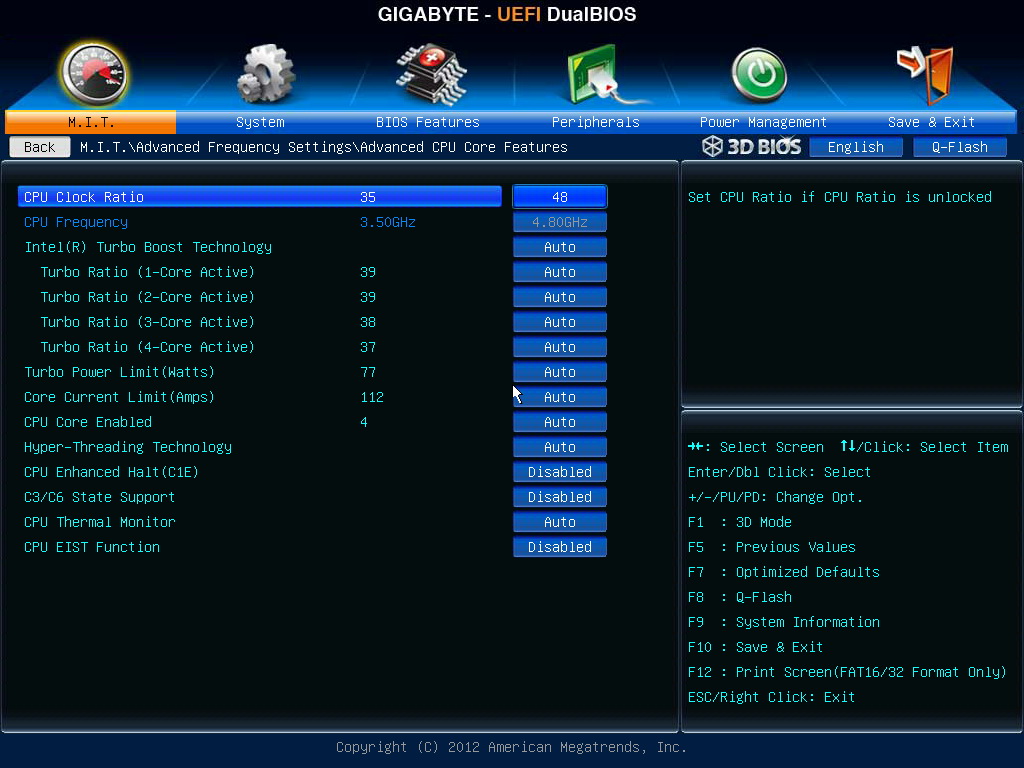
DDR3 2400 latency setting is CL10 12-11-27 1T.
Capacity is 4GB X 4 => 16GB

This 3770K, OC to 4.8GHz needs CPU Vcore to set at 1.380V.

DDR3 2400 1T needs DRAM Voltage to set at 1.600V.
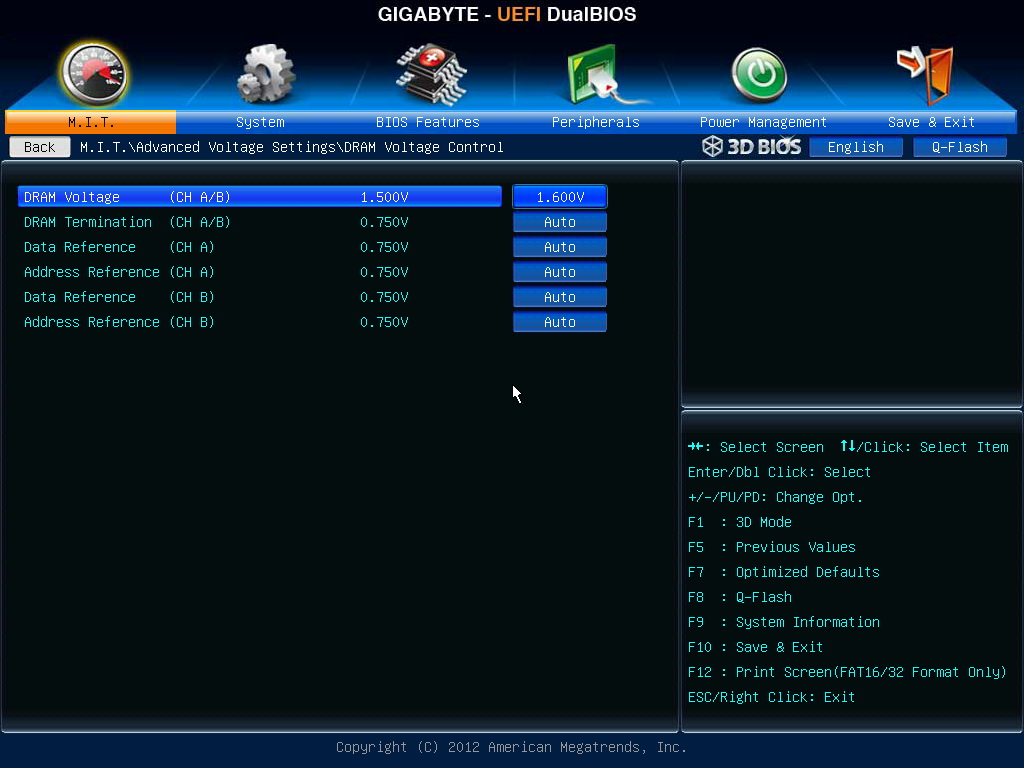
Ivy Bridge structure temperature is higher than former one when OC to 4.5GHz.
No matter 3770K or 3570K, there are some conditions to OC to 4.5~4.8GHz with Z77.
Besides CPU quality, you still need better CPU cooler. High end fan or ware cooler is better choice.
Memory Controller OC ability is much improved in Ivy Bridge. But you need better quality IC to reach 2133~2600.
-

In the last two years, DeskTop market has changed. OC market becomes smaller.
The main reason is mainstream CPU can afford most application requirements.
Also, only high end CPU and chipset structure can do more OC.
If you would like to have higher frequency or save video converting time, OC is still a good way.
Besides OC and performance, the other key selling point of high end PC is Gaming market.
You may hear about eSport. PC still has more advantage in high performance 3D field.
This review is Ivy Bridge most high end platform. It owns high performance OC and Gaming specs.
CPU is LGA 1155 3rd Gen. Intel Core i7-3770K
K series is unlocked. There are only two for Ivy Bridge, 3570K and 3770K.
Intel packing, 2nd and 3rd Core I series both use same product pictures.

Contents are CPU, original cooler, product manual, and Intel sticker.
Intel 4 Cores CPU all use cooper bottom cooler.
3770K frequency is 3.5GHz. It supports latest Turbo Boost 2.0 technology, max speed is 3.90GHz.
It’s physical 4-Core and Hyper-Threading technology supports 8 threads. It calls 4C8T.
22nm manufacturing, power consumption is 77W, L3 Cache has 8MB.
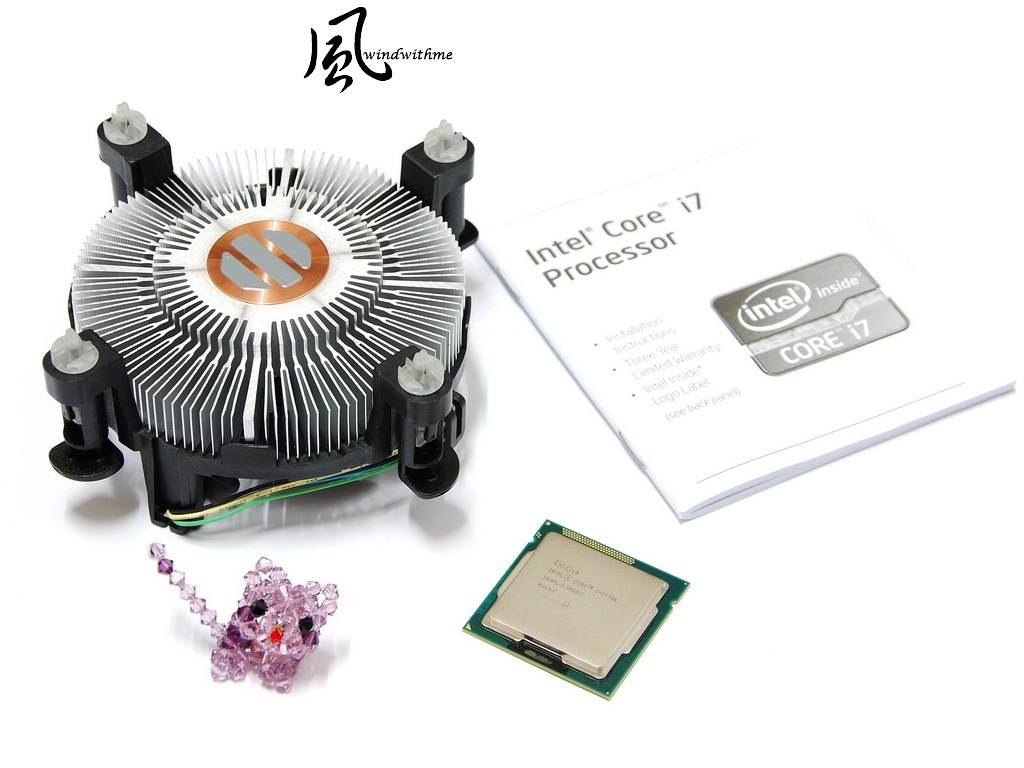
MB uses GIGABYTE last year new series - G1Killer. G1.SNIPER3 has special designs for gaming.
Since X58, Z68, X79 and current Z77, GIGABYTE all has G1 models. SNIPER is 3rd generation now.
G1 colors are different with the other brands black and red. It uses black and green as own style.
As some jungle war games, PCI-E and DDR3 green slots all fit the concept.
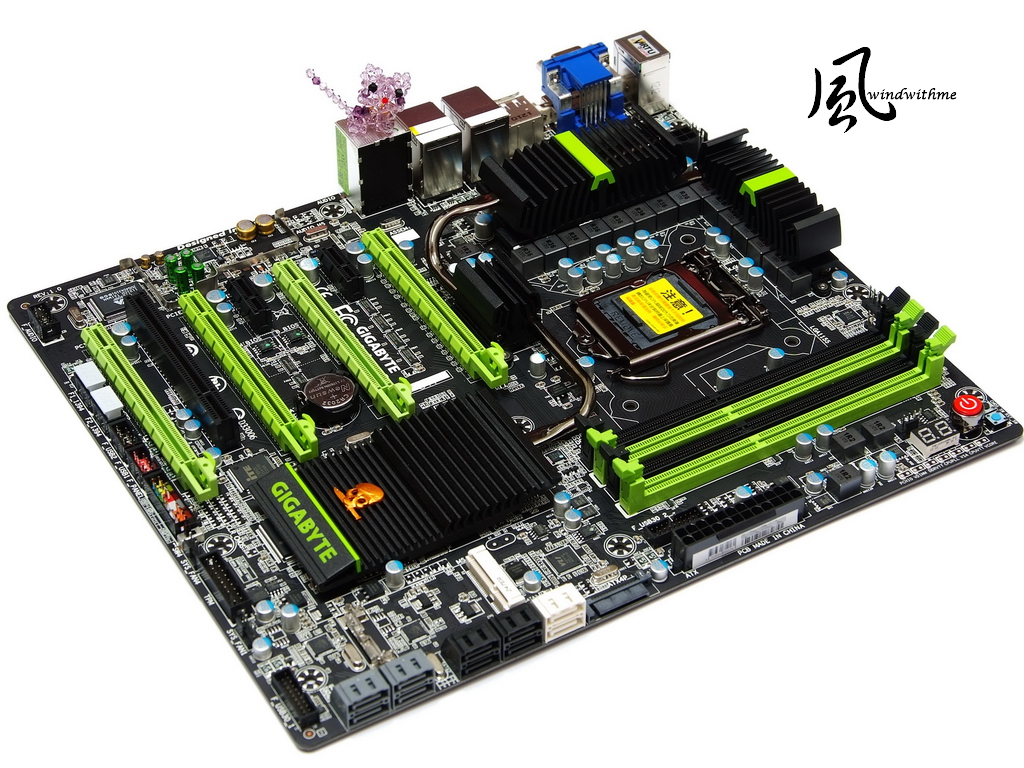
It’s E-ATX, 30.5cm x 26.4cm.
As long as it’s not diminished version ATX Case, standard ATX Case can support this form factor.
G1 is for Gaming market. GIGABYTE uses better level chips for audio and LAN.

Bundled Accessories
Product manual, software installation guide, drivers CD, IO panel, SLI / CrossFireX bride.
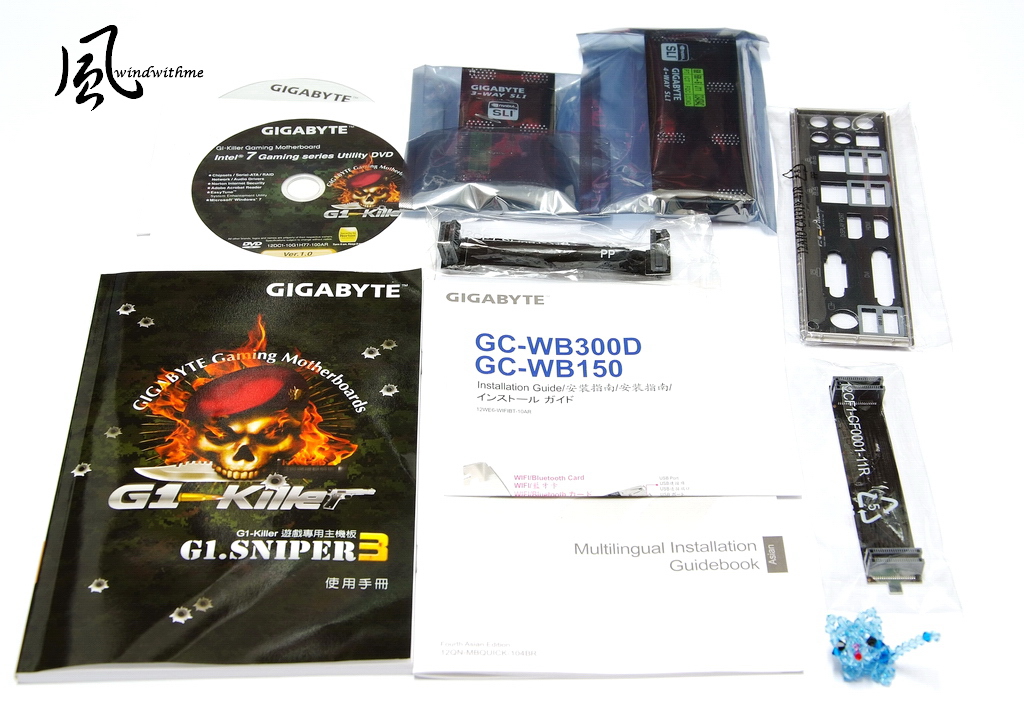
3.5” front control panel, BT 4.0/WiFi card and arena, SATA extended panel, SATA cables.

Lower-Left Corner
4 X PCI-E X16 support max 4-Way AMD CrossFireX/nVIDIA SLI technology.
Bandwidth is X16 + X8 + X16 + X8 or X8 + X8 + X8 + X8.
2 X PCI-E X1
1 X PCI
LAN are rare Qualcomm Atheros Killer E2200 Chip and Intel GbE LAN Chip.
It builds in Creative CA0132 audio chip supports 5.1 channels and High Definition Audio technology.
Design in Taipei
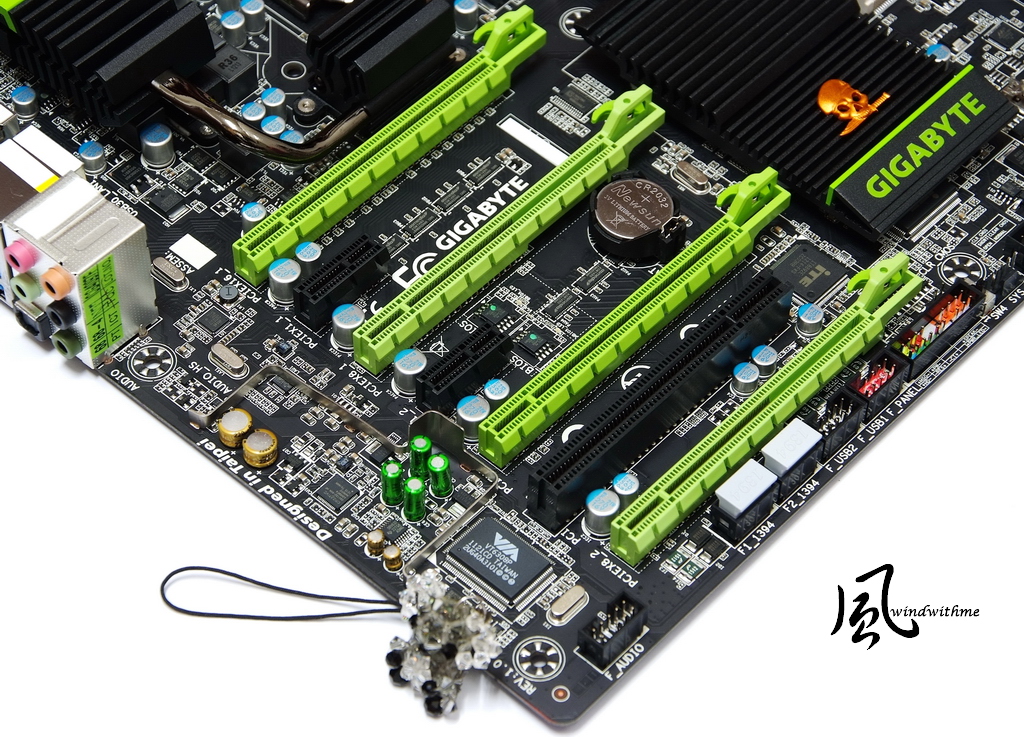
Lower-Right Corner
2 X White SATA, provided by Z77 chipset and support SATA3
4 X Black SATA provided by Z77 chipset and support SATA2
It supports hybrid RAID 0, RAID 1, RAID 5 and RAID 10. The performance is based on the installed SATA devices.
4 X Gray SATA provded by Marvell 88SE9172 and support SATA3. It also supports RAID 0 and RAID 1.
1 X mSATA
2 X 64 Mbit flash for Dual BIOS. 1 X front USB 3.0 and TPM module header.
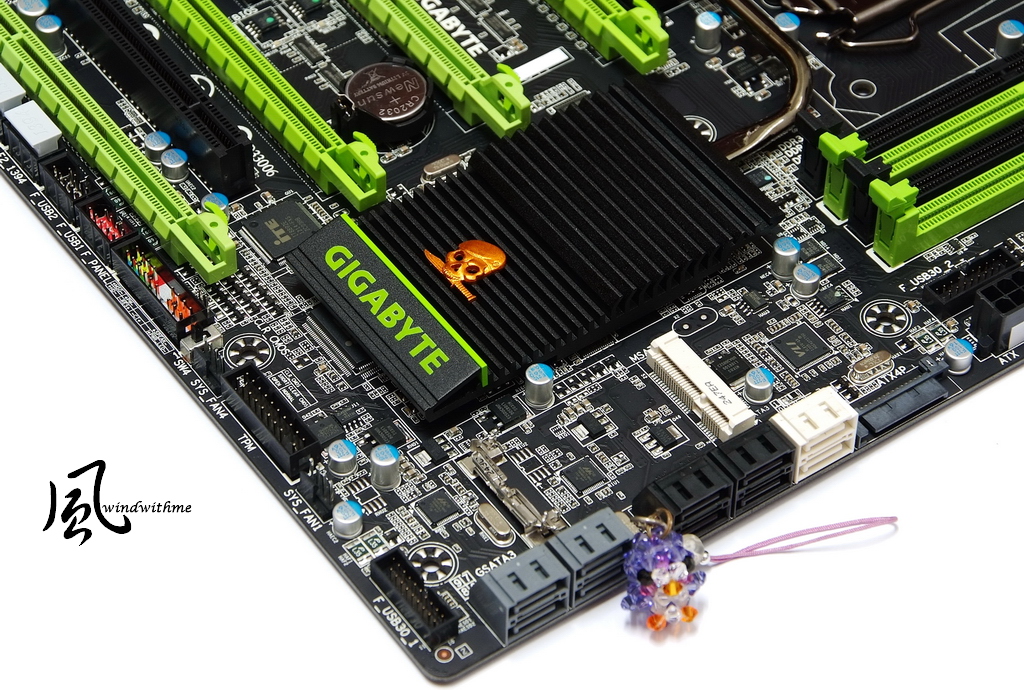
Upper-Right Corner
4 X DIMM DDR3 support 1066/1333/1600/2666(OC). DDR3 max capacity is 32GB.
It supports Extreme Memory Profile technology. Next is 24-PIN power connector.
Red is power button, black is Clear CMOS and blue is Restart. Right side has 7 contact points for hardware voltage measurement.
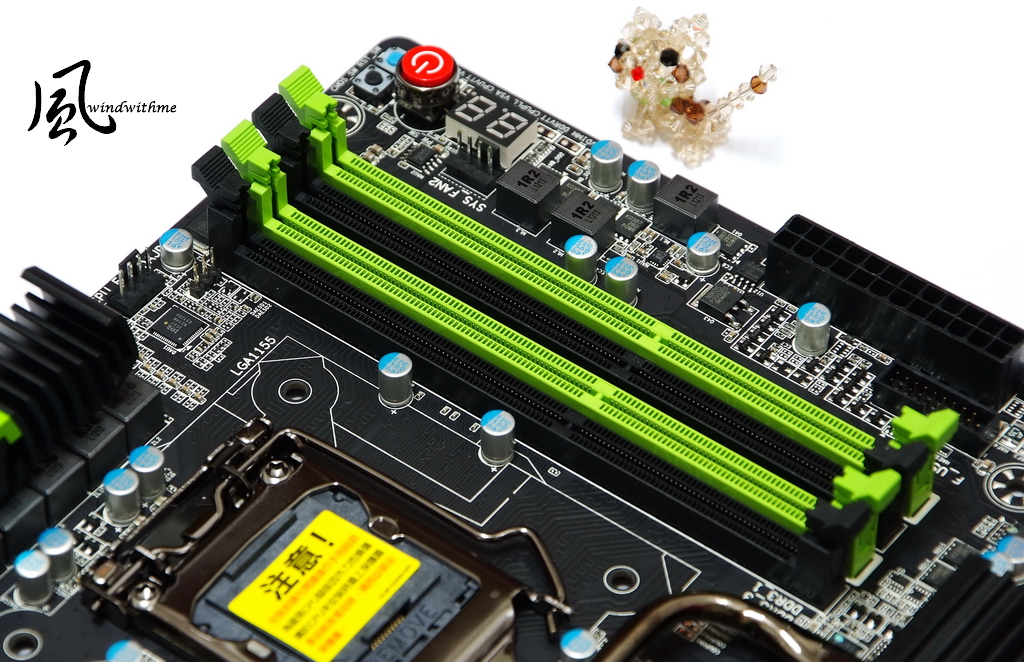
-
PCMark Vantage => 23602
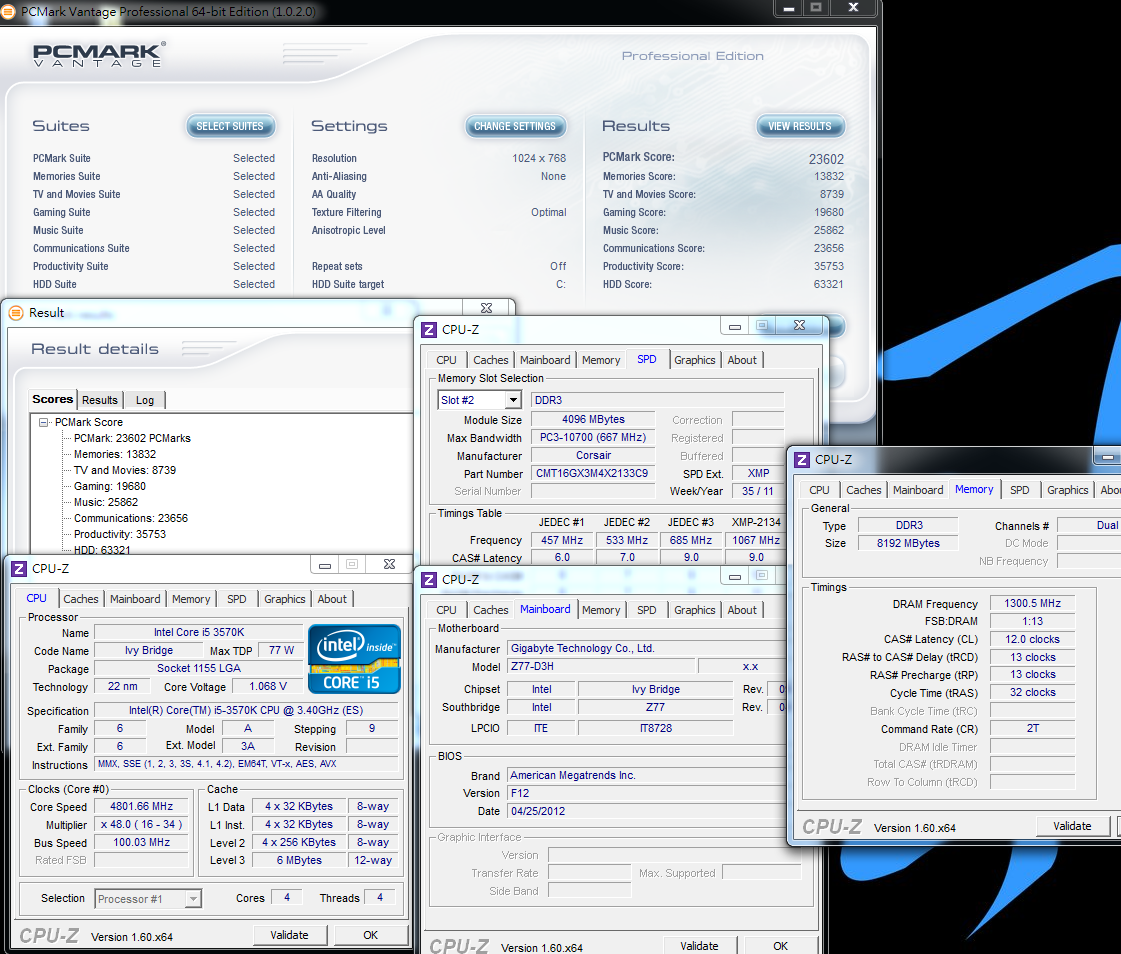
i5-3570K OC ability is similar to i7-3770K, but 3770K performance is 25% higher than 3570K as same frequency.
The CPU performance difference is caused by L3 cache and HT technology. However, the price gap is another key issue.
Ivy Bridge 3570K juxtapose with Sandy Bridge 2500K, the performance is 6% higher. It’s lower than 3770K got 6~14% higher than 2770K.
3570K is capable for most software. It’s most preferred CPU in mid-end market.
DRAM Bandwidth Test
DDR3 2600.8 CL12 13-13-32 2T
ADIA64 Memory Read - 23710 MB/s
Sandra Memory Bandwidth - 28905 MB/s
MaXXMEM Memory-Copy - 28308 MB/s

Ivy Bridge DDR3 bandwidth is close to Sandy Bridge.
The key difference is Ivy Bridge can upgrade DDR3 clock to 2~3 higher levels.
If DDR3 quality is good enough, you can run at 2600~2666 which is good enough for users demand for high clock.
Z77-D3H can reach DDR3 2600 easily. It will be better if the bandwidth is higher.
Temperature(Room is 32˚C)
Enter to OS Desktop - 38~45

CPU Full Speed by Linx - 79~90

Even though you have some ideas of Ivy Bridge temperature from my previous 3770K reviews.
This time, the room temperature is quite high. i5-3570K OC 4.8GHz numbers are higher of course.
I used to expect 3570K, without HT, can be lower. So far, it seems the same with 3770K.
If you want to OC 3570K / 3770K to 4.8GHz, cooling devices is the key factor.
Power Consumption
Enter to OS Desktop - 67W

CPU Full Speed by Linx - 163W
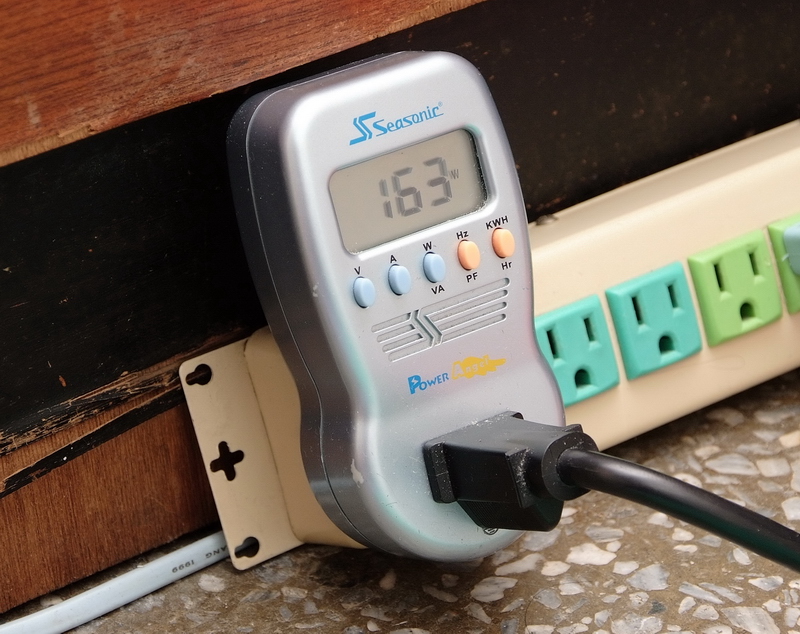
If only use IGP HD Graphics 4000, the power consumption is similar to 3770K in OS desktop.
As 4.8GHz, 3570K is 12W lower than 3770K which is not big difference.
These two CPU still owns Ivy Bridge 22nm advantage which is must power saving than former 32nm.
GIGABYTE Z77-D3H
Pros
1. Z77 series white color box and booting screen is improved.
2. Using UEFI BIOS technology and provide two interfaces for choice.
3. It’s standard ATX PCB and built-in my personal preferred Atheros LAN and VIA audio.
4. OC ability is excellent. CPU can run at 4.8GHz stable and DDR3 can reach 2600MHz as well.
5. Back IO panel provides 4 USB 3.0 ports and exclusive mSATA SSD slot.
Cons
1. DDR3 2600 bandwidth need to be improved
2. CPU-Z cannot detect the real voltage

Performance ★★★★★★★★★☆ 88/100
Components ★★★★★★★★☆☆ 77/100
Specification ★★★★★★★★☆☆ 83/100
Appearance ★★★★★★★★☆☆ 77/100
C/P Value ★★★★★★★★★☆ 92/100
This review is focus on Ivy Bridge mid-end OC platform, Z77 with Core i5-3570K.
3570K is following model of 2500. The temperature and power consumption are similar to 3770K.
OC range is also close to 3770K. If your cooling and CPU quality are good enough, 4.8GHz is easy to keep stable run.
However, in terms of price, 3570K is much lower than 3770K. If you are not heavy overclockers, 3570K is good option for you.

GIGABYTE Z77-D3H uses VIA VT2021 audio chip. I use Realtek ALC892 to compare with it by headset.
VT2021 medium frequency is better, especially in vocal. For high frequency and stress are similar.
If you are always listening music, you can consider to use VIA VT2021 to have better quality in medium frequency.
Z77-D3H price is a little bit higher than entry Z77 MB, but the spec make it have better C/P value.
The OC ability is close to high end Z77. LAN and audio chips are also better in my personal experience.
This time, even though Intel Z77 is most high end Ivy Bridge chipset, but the price is lower than the past as launching stage.
Maybe it’s the result of market and competition. Users can lower their budget to get latest platform.

This review is also post in my blog WIND3C. Any comments are welcome.
-
nVIDIA GTS450 => 25.8 fps
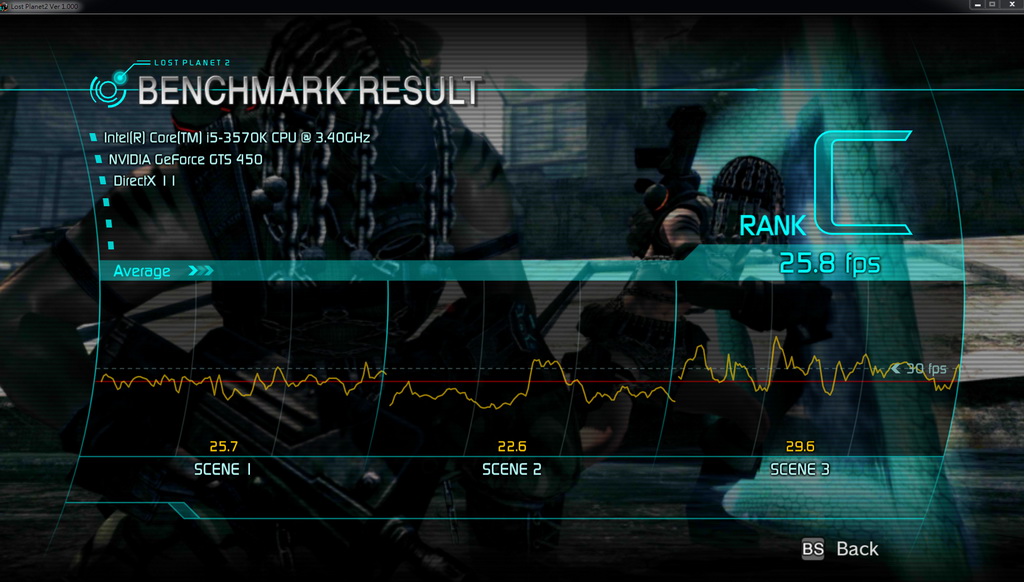
HD Graphics 4000 performance has 30%~50% improvement comparing to HD Graphics 3000.
The IGP 3D performance is similar to AMD A8-3850 Radeon HD6550D.
The performance is still a big gap with nVIDIA GTS450. However, it’s over GT430 / GT520 and close to GT440.
Most Z77 MBs support Lucid MVP technology. It will enhance HD Graphics 4000 performance for further 3D applications.
File converting performance test. The GPU still use Intel HD Graphics 4000 / nVIDIA GTS450
Output interface is DVI on GTS450 and switch GPU by software.
MediaEspresso is the video converter for comparing IGP and external VGA.
DVD File VTS_01_1.VOB, 1023MB and convert to MP4 file.
Intel HD Graphics 4000
Upper-Left is Virtu MVP features. Enable Intel Quick Sync Video(Better quality)

4 mins 12 secs
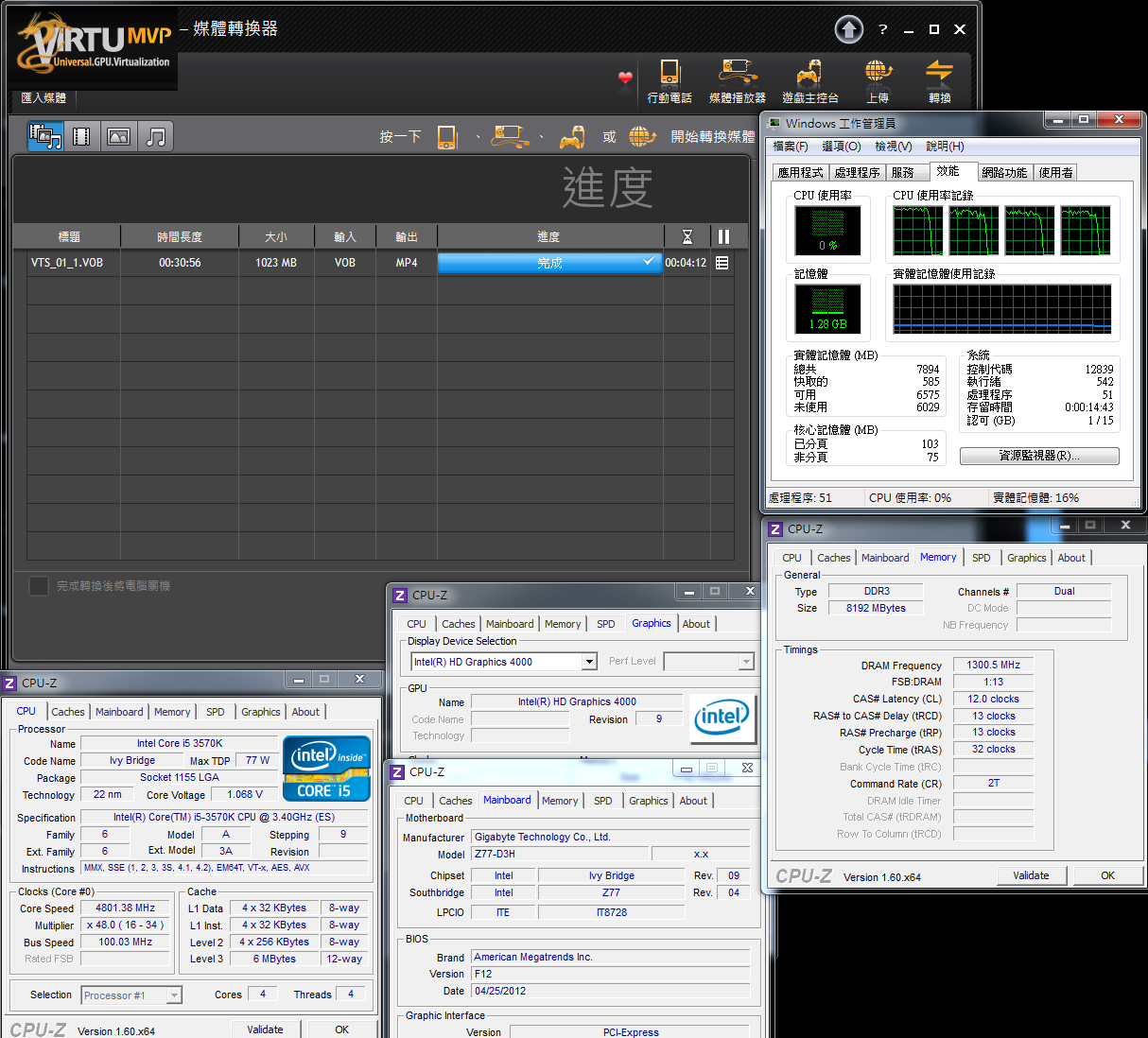
Galaxy GTS450
Lower-Left enable nVIDIA CUDA Technology

4 mins 52 secs

I used same video file to test. Intel Quick Sync Video is 40 seconds faster than nVIDIA CUDA.
Using Intel HD 4000 can save 16% time. For users who have high demand of video converting, you can save lot of time.
Also, Intel claimed Ivy Bridge for Intel Quick Sync Video is much faster than Sandy Bridge as well.
If I have time, I will use SNB to compare the real performance difference of Intel Quick Sync.
Z77-3DH CPU and system performance in OC condition.
CPU 100.3 X 46 => 4801.29MHz(Disable Turbo Boost and C1E)
DDR3 2600.8 CL12 13-13-32 2T(Enable XMP Mode)
Intel HD Graphics 4000 1150MHz
Hyper PI 32M X4 => 7m 27.658s
CPUMARK 99 => 757
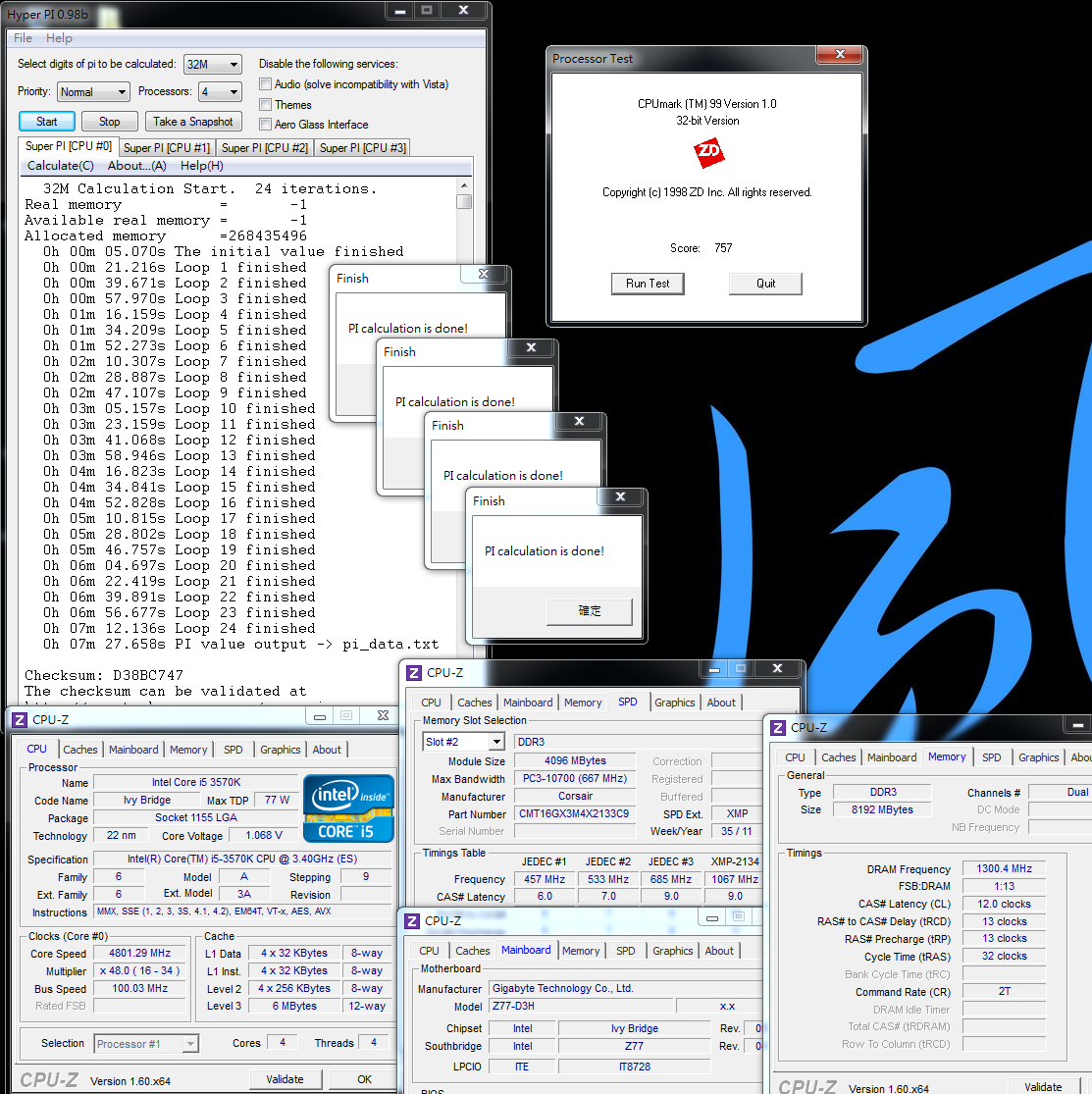
Nuclearus Multi Core => 29517
Fritz Chess Benchmark => 30.06/14430

CrystalMark 2004R3 => 367177

CINEBENCH R11.5
CPU => 7.98 pts
CPU(Single Core) => 2.04 pts

FRYRENDER
Running Time => 5m 38s
x264 FHD Benchmark => 23.8

-
Internal Graphics enable Lucid MVP technology.

PC Health Status

Ivy Bridge OC setting is much easy than the past. However, you need Z77 and K series CPU in advance.
If you don’t meet the criteria, the CPU frequency OC range will be very small.
Also, OC CPU clock will pull high PCI-E as well, you also need to consider the product life for long time usage.
Z77 with 3570K CPU, you just need to rise CPU clock, then fine tune by CPU quality and cooling devices.
Test Configuration
CPU: Intel Core i5-3570K
MB: GIGABYTE Z77-D3H
DRAM: CORSAIR DOMINATOR-GT CMT16GX3M4X2133C9
VGA: Intel HD Graphics 4000 / Galaxy GTS450 1G DDR5
HD: SanDisk Extreme 240GB
POWER: CORSAIR AX650W
Cooler: CORSAIR Hydro Series H100
OS: Windows7 Ultimate 64bit
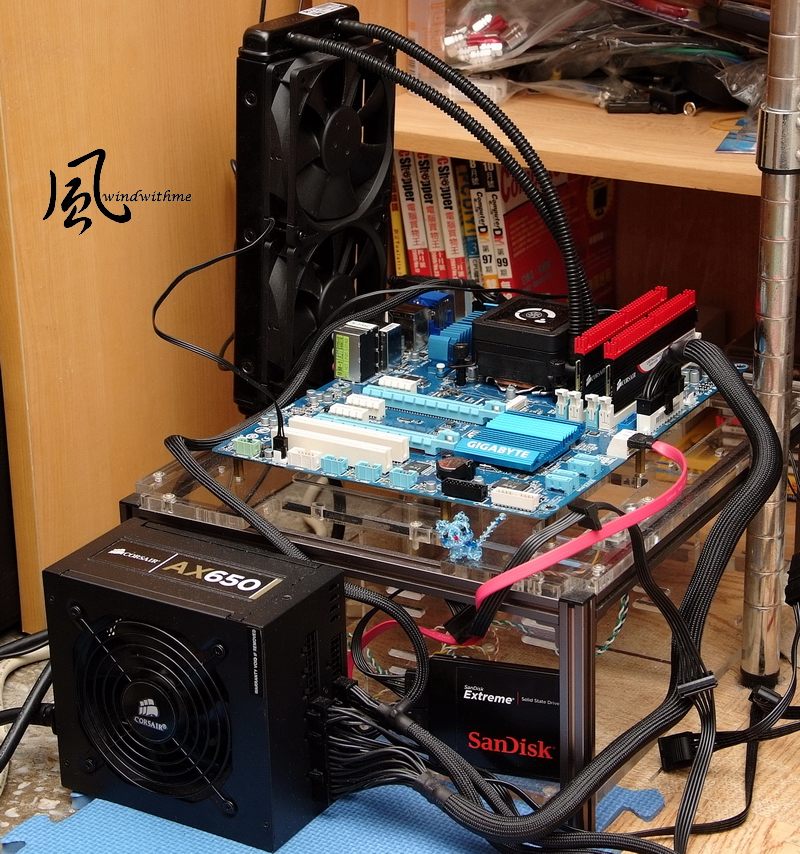
First of all, let’s compare Intel latest HD Graphics 4000 and nVIDIA GTS450 in default mode.
HD Graphics 4000
3DMark Vantage => P4689

nVIDIA GTS450
3DMark Vantage => P11447

StreetFighter IV Benchmark 1920 X 1080
HD Graphics 4000 => 53.11 FPS

nVIDIA GTS450 => 138.50 FPS

FINAL FANTASY XIV 1920 X 1080
HD Graphics 4000 => 864

nVIDIA GTS450 => 2140

LOST PLANET 2 DX11 1920 X 1080 TEST A
HD Graphics 4000 => 11.1 fps

-
mSATA SSD slot for small capacity mSATA SSD to enable Intel Smart Response.
Intel Smart Response can enhance system speed and this port is sharing with SATA2 5.
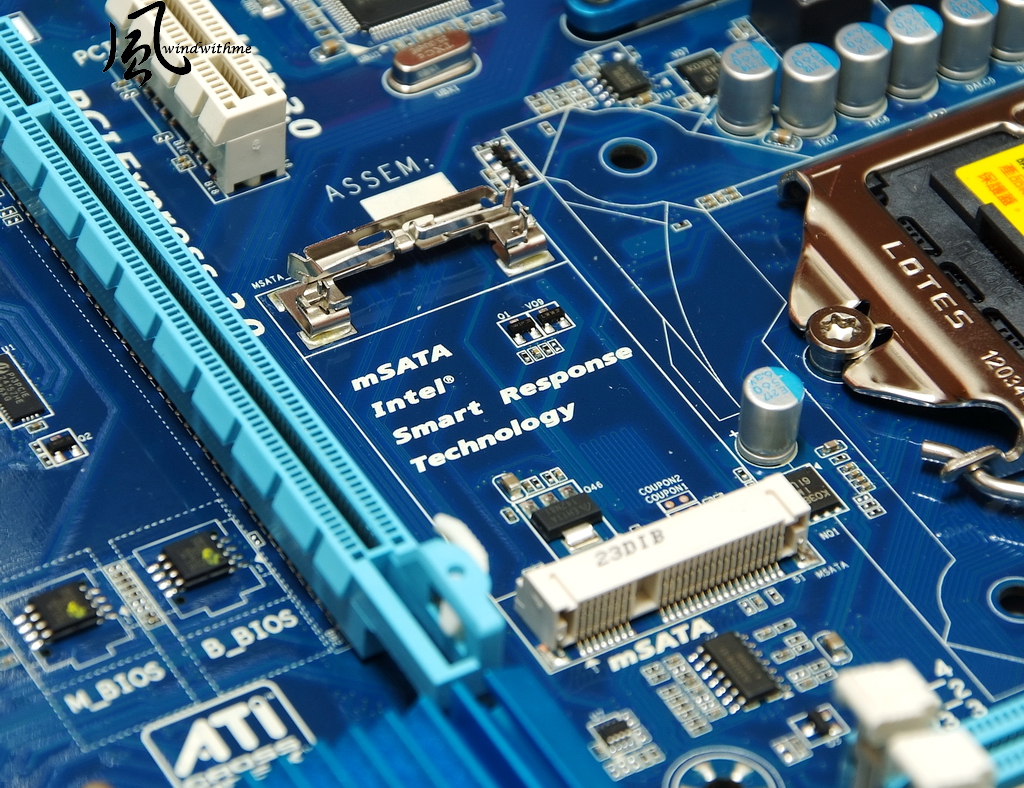
Blue heat-sink provides bigger cooling zone by special cut.
Besides gorgeous color, the light source will change the deep or light color.
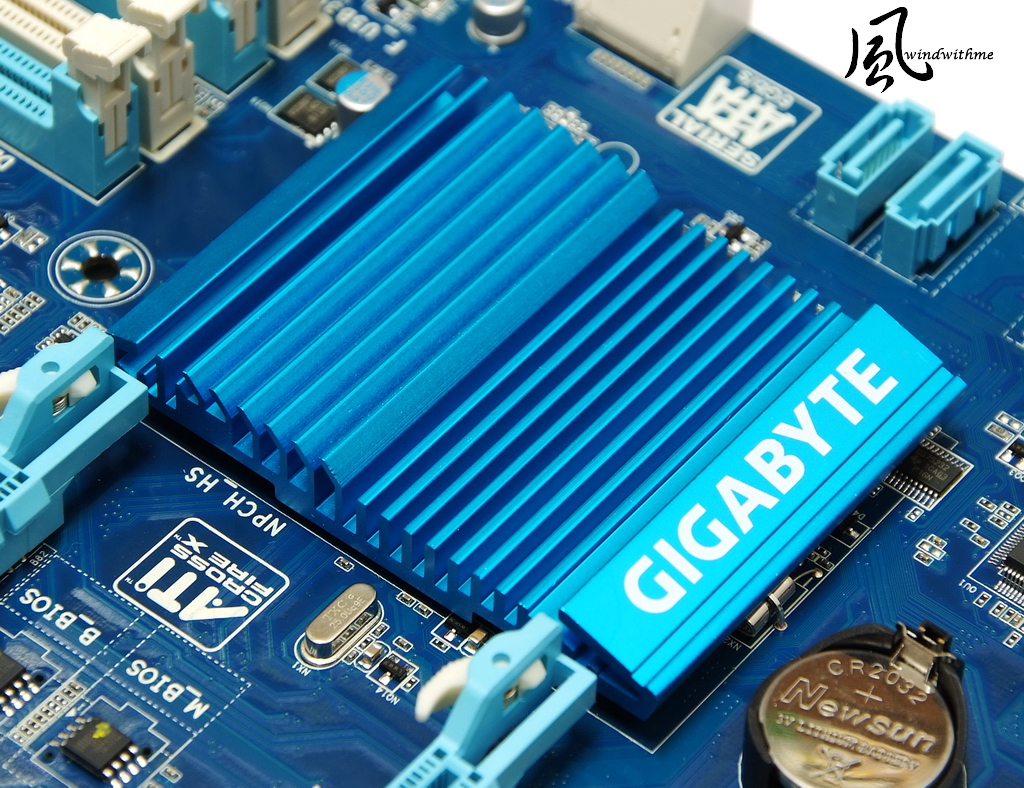
GIGABYTE changes Realtek chipset which is more compatible and faster update this time.
LAN chip is Atheros GbE. In NoteBook or AP field, Atheros connection capability has very good reputation.
Audio chip uses VIA VT2021. If you are studying audio card, you should be impressive at VIA Envy24.
VIA merged audio chip company years ago. Envy24 172X is the most famous product in audio card.
They have as cheap as 20USD, also some high end brands audio card which are 200~300USD.
I hope VIA VT2021 can adopt Envy24 tradition. I will share the audio experience later.
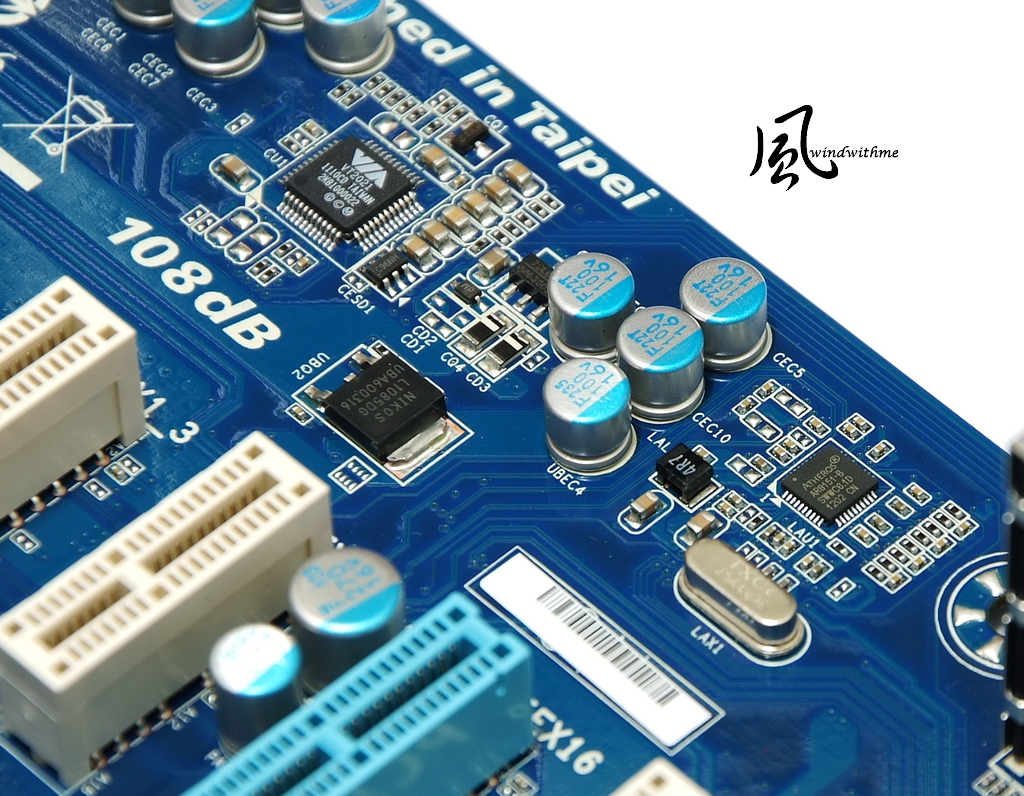
UEFI M.I.T. main page
You can easily see the hardware status in the bottom.

CPU Clock Ratio set to 48, which is 4800MHz.
Enable X.M.P., the DDR3 set to 2133 as its spec.
System Memory Multiplier adjust to 26 by DDR3 quality, which is DDR3 2600.

Advanced CPU Page
You can adjust individual CPU Core ratio. You also can choose how many cores to enable.
I am used to disable C1E/C3C6 and EIST, power saving features, when I am OC.

DDR3 Main Page.
X.M.P. items and clock can be set in previous page.
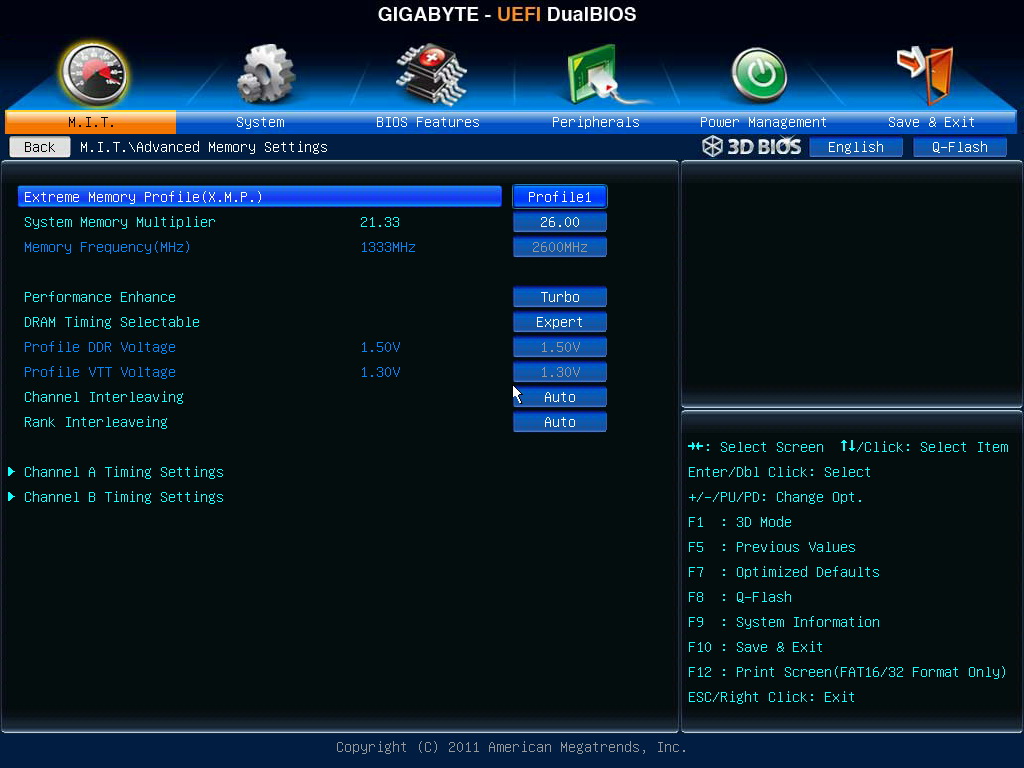
DDR3 2600 latency is CL12 13-13-32 2T

OC Voltage Items
CPU Vcore 0.800~1.900V
CPU Vtt 0.800~1.680V
My 3570K OC to 4.8GHz requiring 1.340V at CPU Vcore.

DRAM Voltage 1.200~2.400V
DDR3 2600 stable voltage is 1.660V
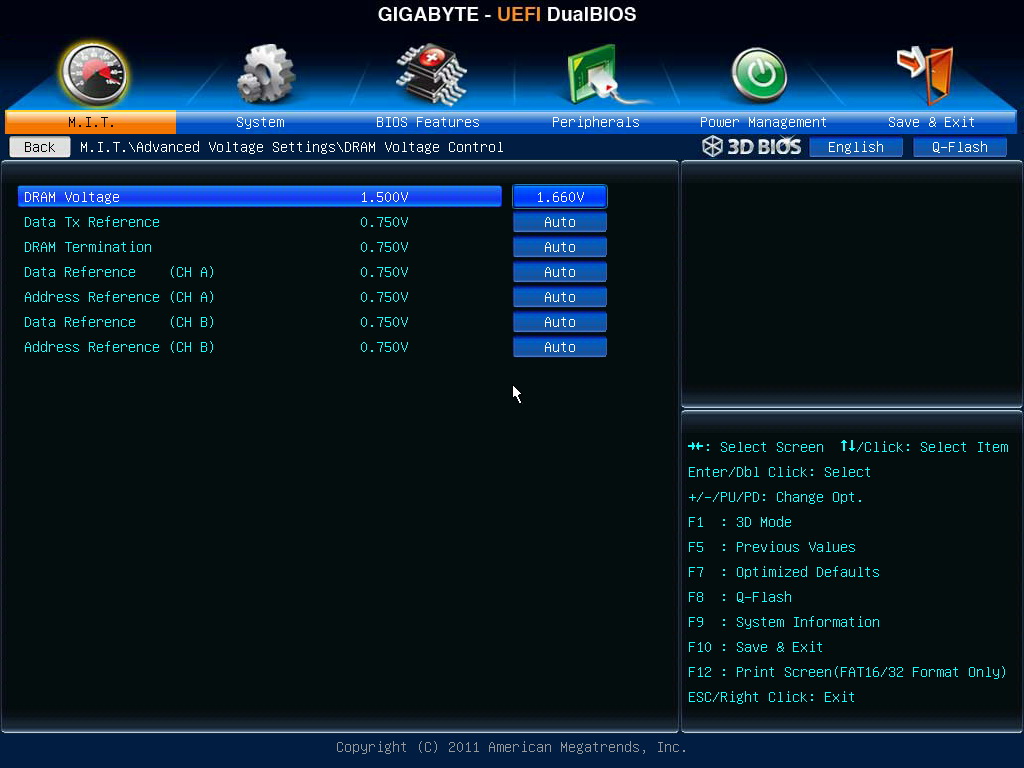
-
Do you remember the price of Intel previous popular chipset 865?
The entry model was cost 120~130USD.
After that, P35/P45/P55/P67 chipset entry MB price was even higher.
The entry model was 160~180USD.
Of course, the MB components and spec were getting better and more features.
Many friends were complaining the high price and miss the chipset 865 time.
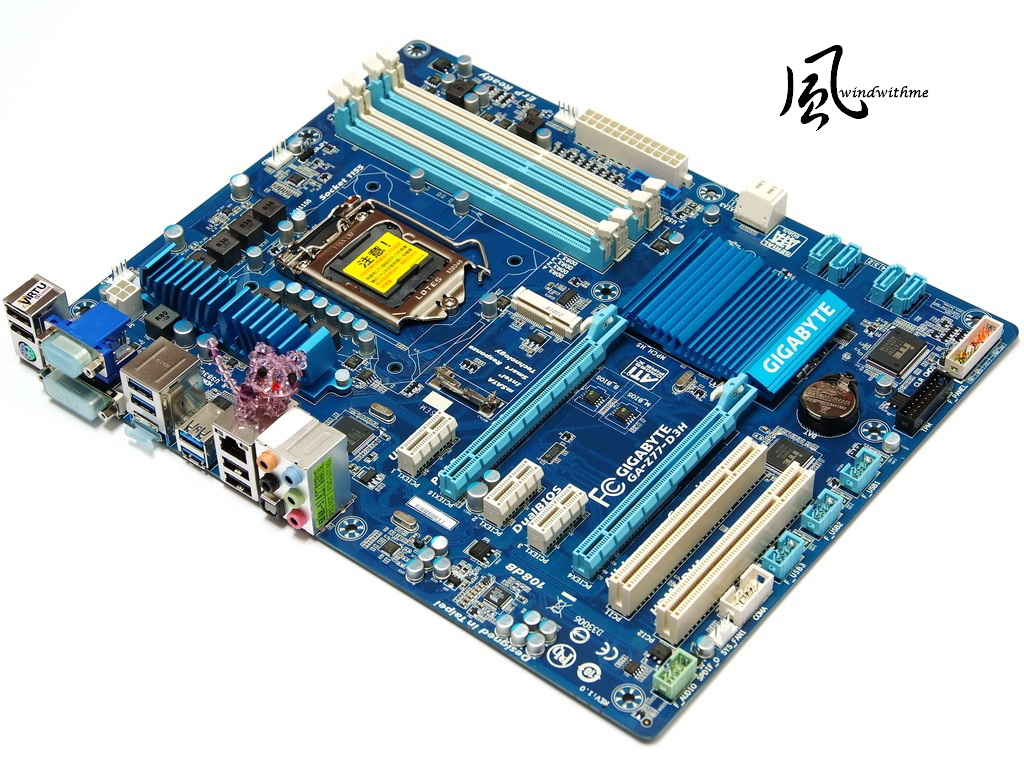
Most customers are more prefer parity MB. At late stage of Z68, you can see some 100USD boards.
In April, latest Ivy Bridge launched, Z77 boards are more parity.
Z77 just launched, many MB makers all released ~100USD Z77 MB.
These couple years, NoteBook, Pad and SmartPhone share the internet devices market.
It pushes DeskTop very hard. The market competition and price are going lower.
Z77 board price back to parity 865 dynasty which is good for users.
CPU is Intel Core i5-3570K
Clock is 3.4GHz, supports Turbo Boost 2.0 and max clock is 3.8GHz.
Latest 22nm plus 3Dtransistors technology, physical 4 Cores, 4C4T.
TDP 77W, L3 Cache is 6MB. It’s one of two Ivy Bridge K sku CPU.
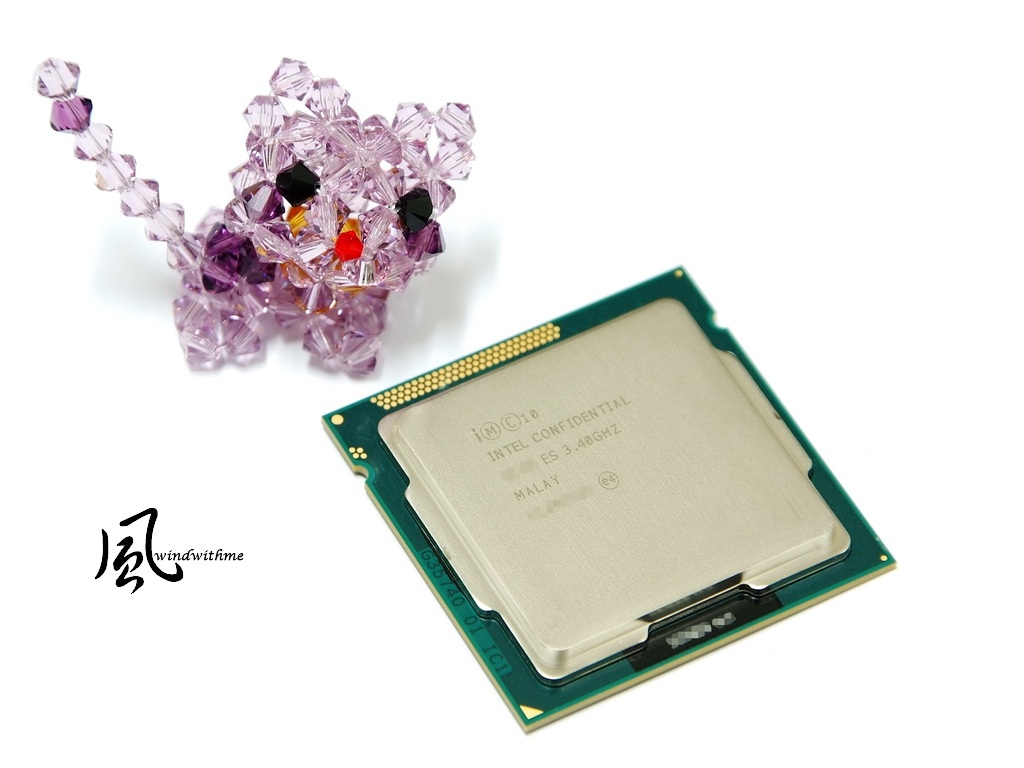
3570K Backside
i5-3570K price is mid-end Ivy Bridge CPU. If you don’t OC, you can choose cheaper i5-3450.
This review is entry Z77. CPU using K series can improve the performance.

MB is GIGABYTE Z77-D3H. The price is around 135USD.
PCB is standard ATX, 30.5 X 24.4cm which is quite rare design in this price segment.
Of course, there are some cheaper Z77 boards. However, they may cut some display ports or shrink the PCB.
Does lower spec Z77 meet your requirement or budget? I suggest you better to study more before buying.

Z77-D3H is blue PCB and white slots. Blue is my favorite colors. Overall, it’s good looking.
If you prefer the black PCB board, there is Z77X-D3H for you which is 20USD more expensive.

Lower-Left Corner
2 X PCI-E X16 supports 2-Way AMD CrossFireX
When using Ivy Bridge CPU, the bandwidth is Gen3 X16 + X4
3 X PCI-E X1
2 X PCI
LAN chip is Atheros GbE LAN
Audio is VIA VT2021 supports 7.1 channels and High Definition Audio technology.
Design in Taipei

Lower-Right Corner
2 X White SATA by Z77 supports SATA3
4 X Blue SATA by Z77 supports SATA2
It supports hybrid RAID 0, RAID 1, RAID 5 and RAID 10. The max performance depends on installed SATA devices.
2 X 64 Mbit flash, Dual BIOS, TPM(Trusted Platform Module) connector

Upper-Right Corner
4 X DIMM DDR3 support 1066/1333/1600/2400(OC). DDR3 max capacity is 32GB.
It supports Extreme Memory Profile technology. Beneath is 24-PIN power connector and front USB 3.0

The PWM has 7 phases, 4-phase for CPU, 1 phase for VTT and 2-phase for GPU.
As 22nm Ivy Bridge CPU TDP, 4-phase design is enough for air-cooling OC.
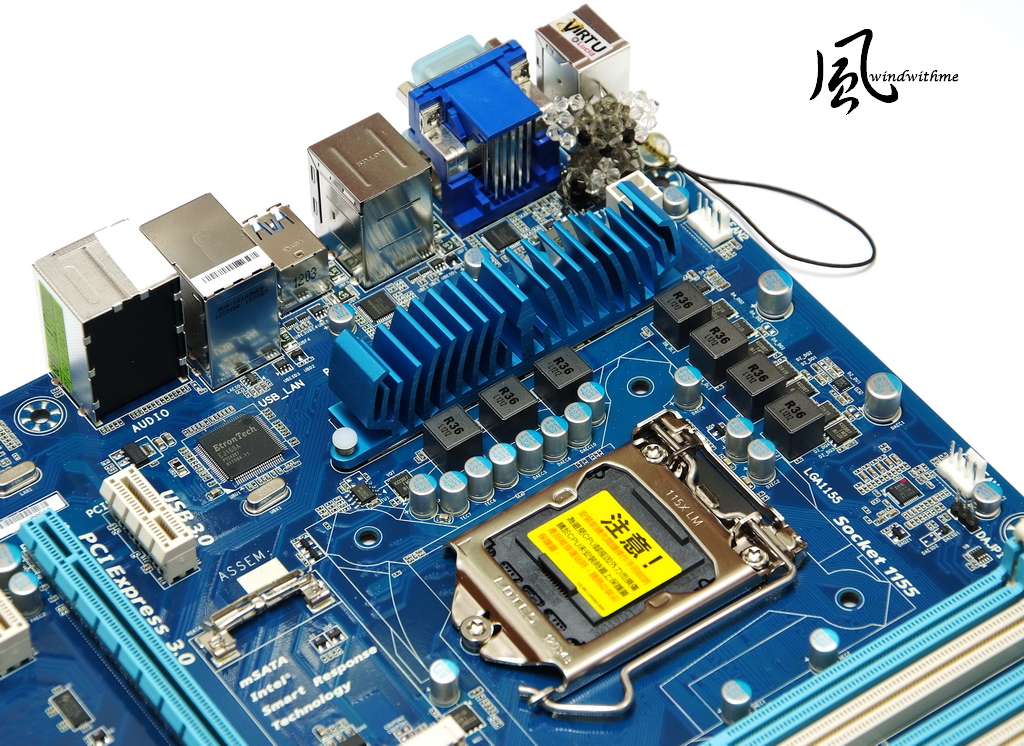
IO
1 X PS2 KB/Mouse
1 X D-Sub / DVI-D / HDMI
4 X USB 2.0(Black)
4 X USB 3.0/2.0(Blue)
1 X RJ-45 LAN
1 X S/PDIF Optical output
5 X Audio Jacks
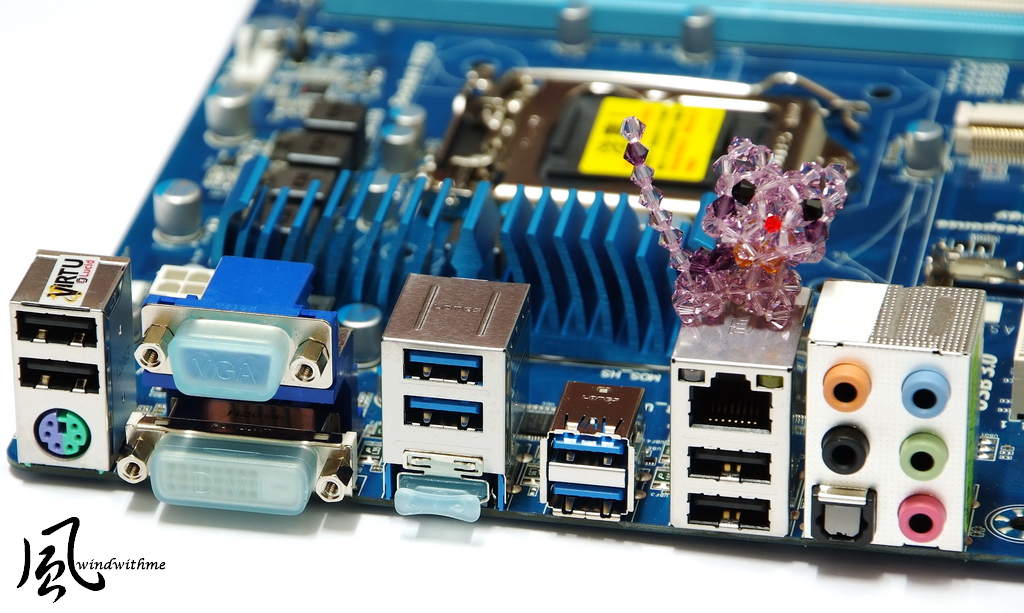
-
X79

Show Girl







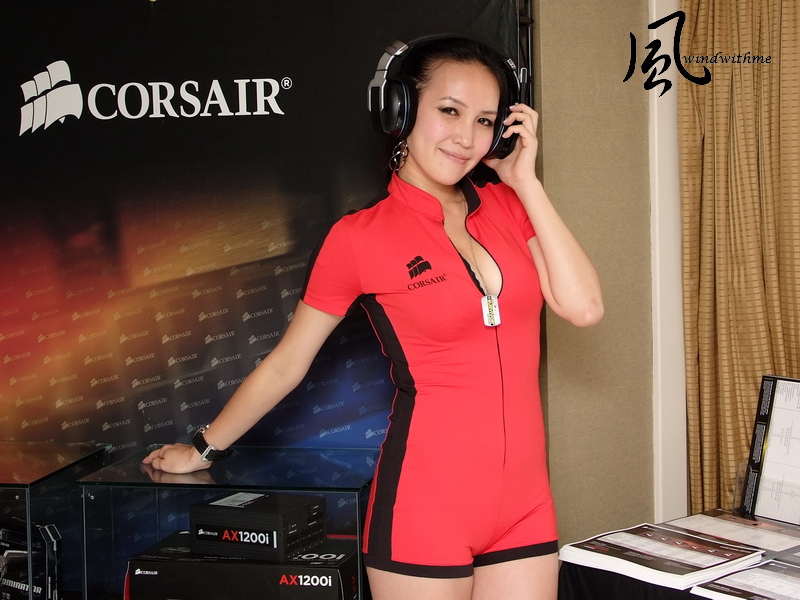
Thanks

-
msi
GT70
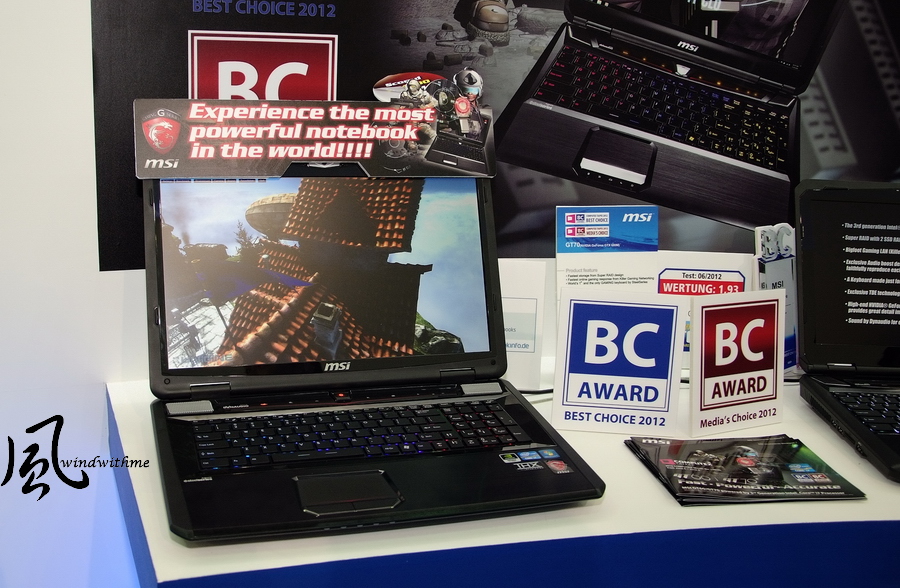
GT60

Slider S20
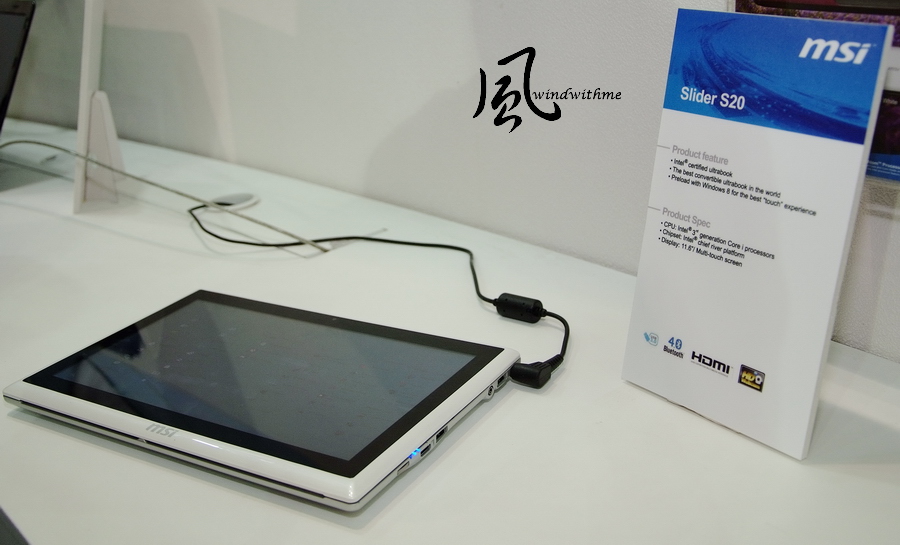

Z77 MPower
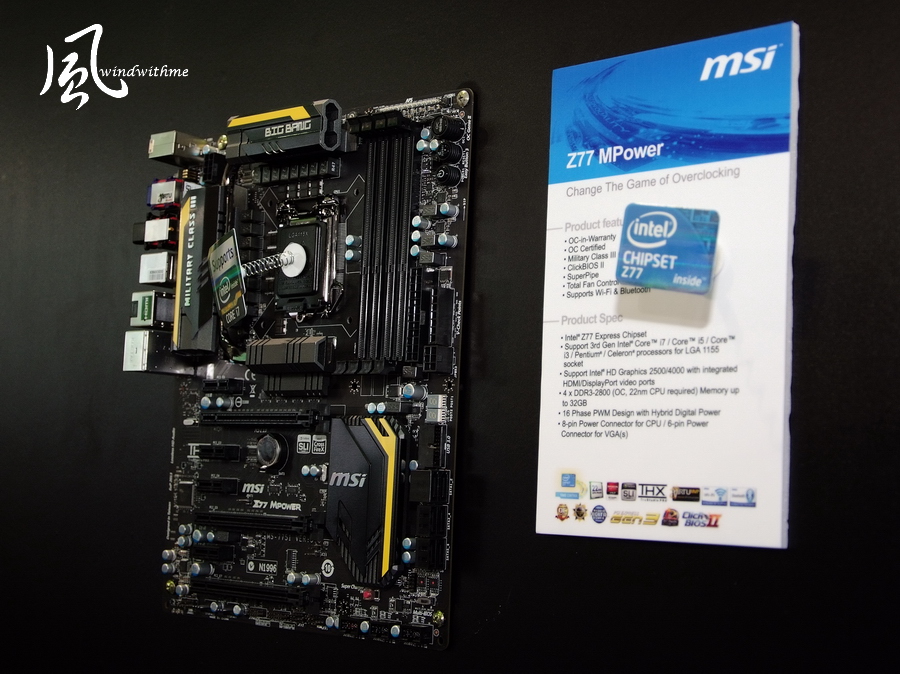
FOXCONN
Intel Z77、Z75、H77、B75 MB
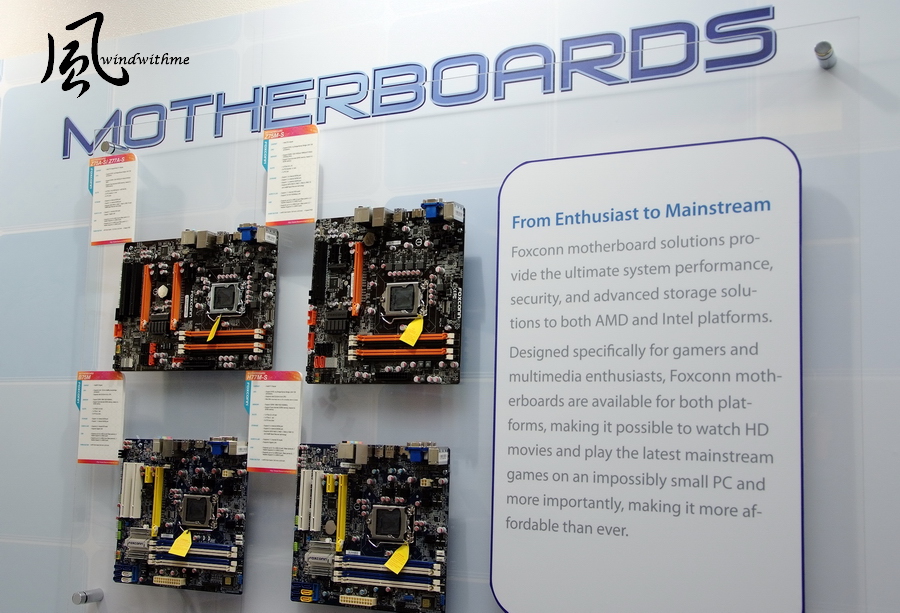
AMD MB

NANO PC
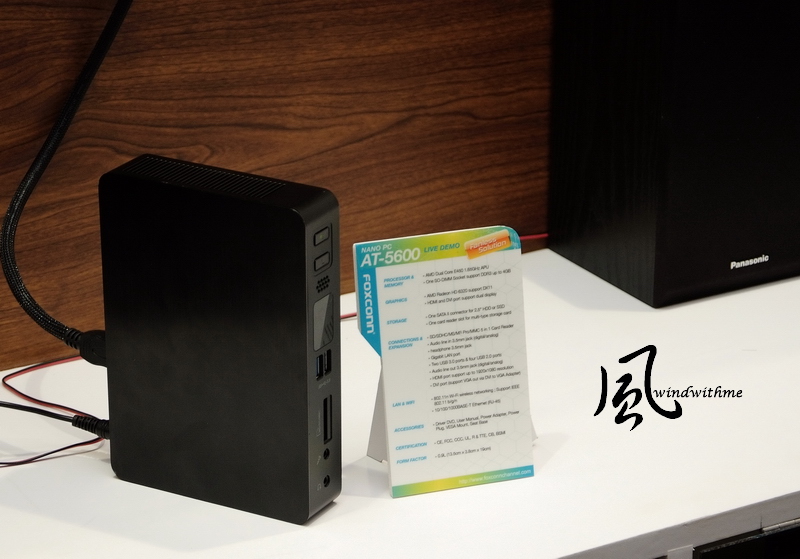
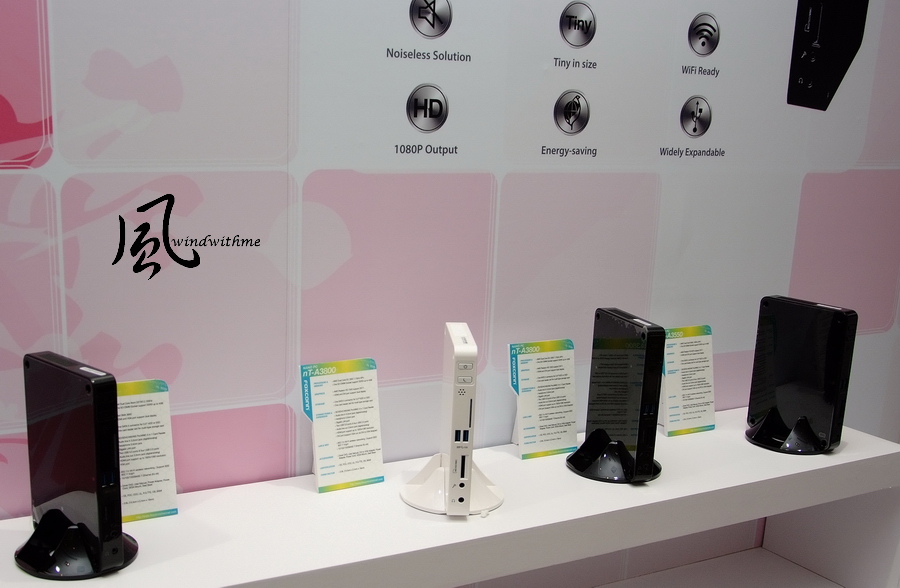
ASUS
ThunderboltEX

-
ECS
Golden Board Z77H2-A2X
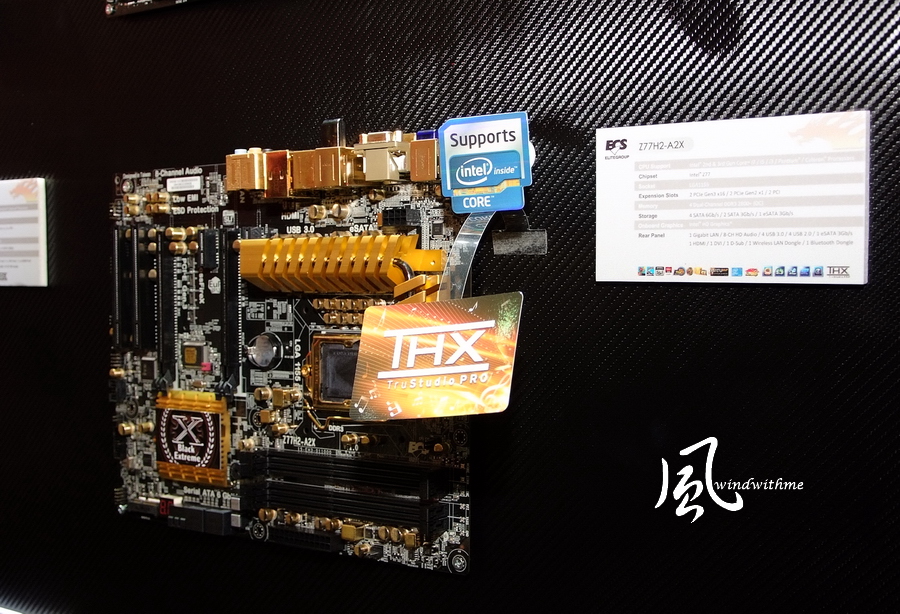
ECS L070T5

G24 Cupid
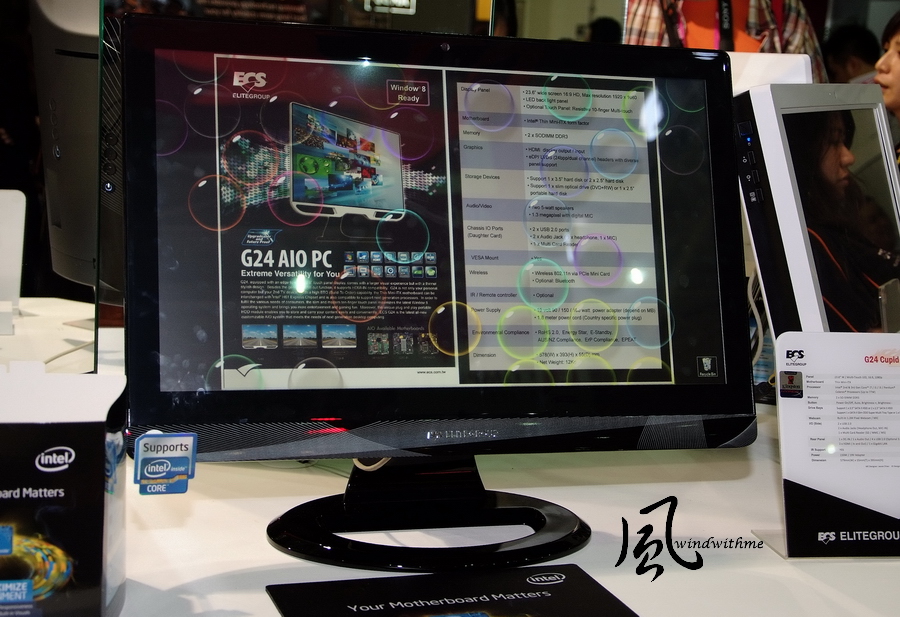
ECS Live Demo

CORSAIR
DOMINATOR PLATINUM / AX1200i

DOMINATOR PLATINUM
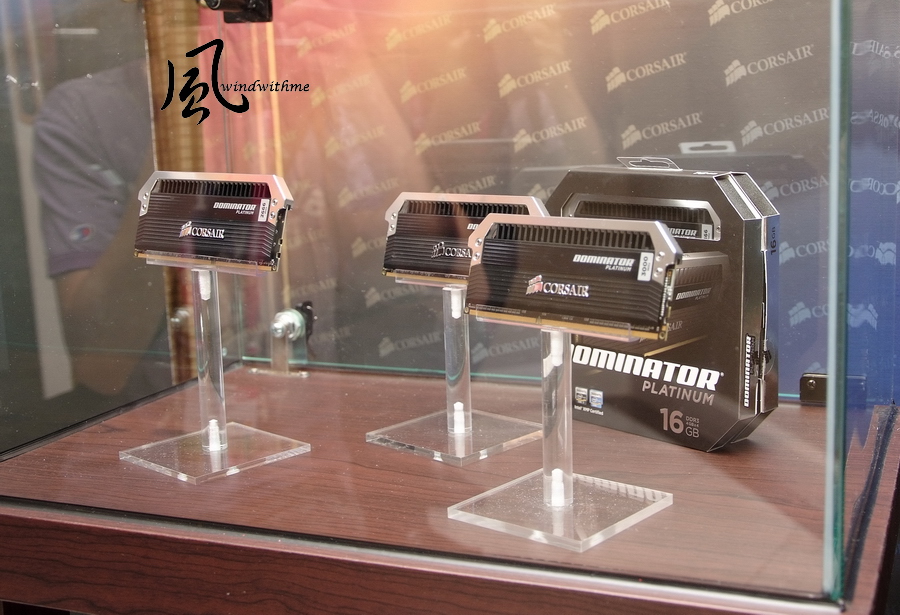
Live Demo

DDR3 3001.8 CL12 14-14-35 2T
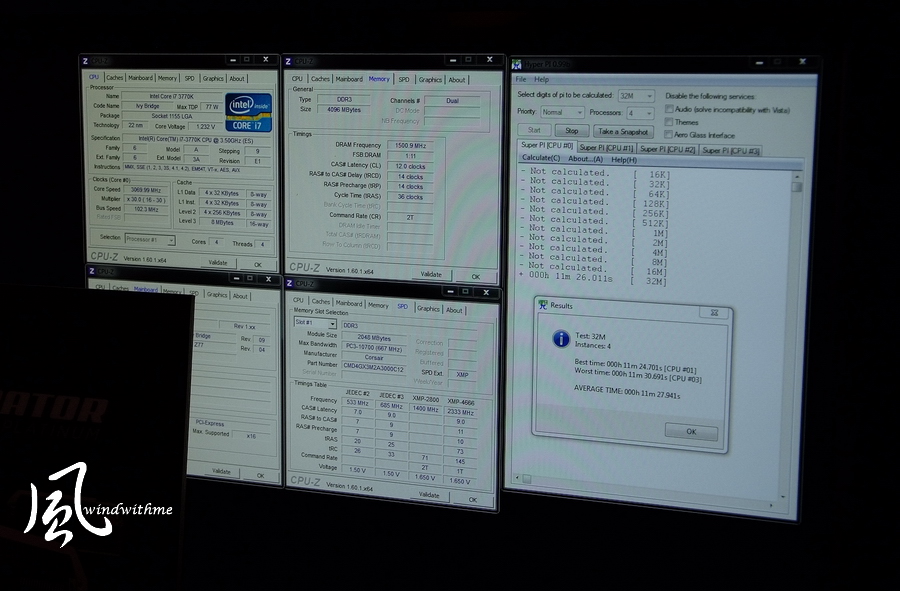
AX1200i / CORSAIR LINK2 Demo
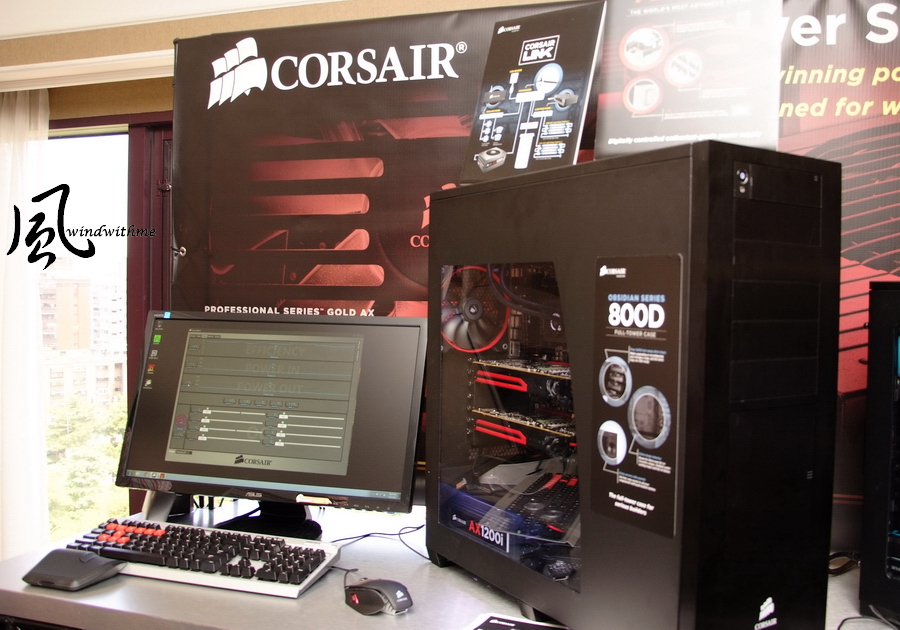
CORSAIR SSD
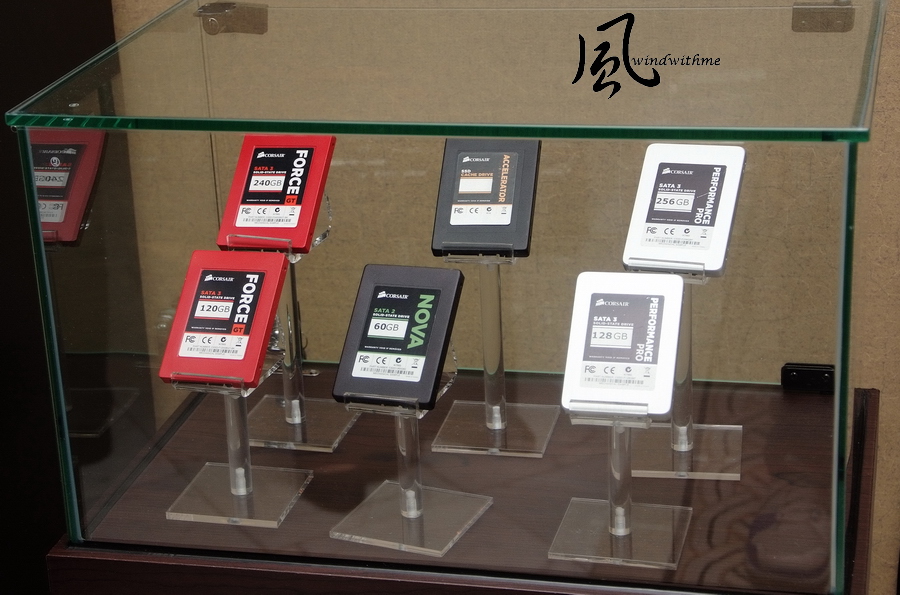
-

GIGABYTE
GA-X79S-UP5 WIFI

GA-Z77X-UP5 Thunderbolt
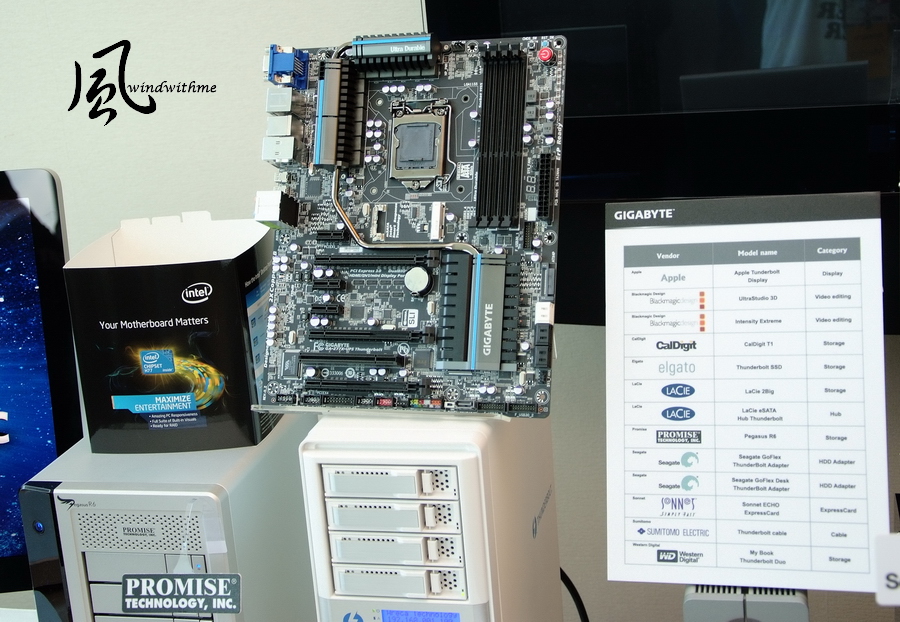
GIGABYTE H61 ITX MB
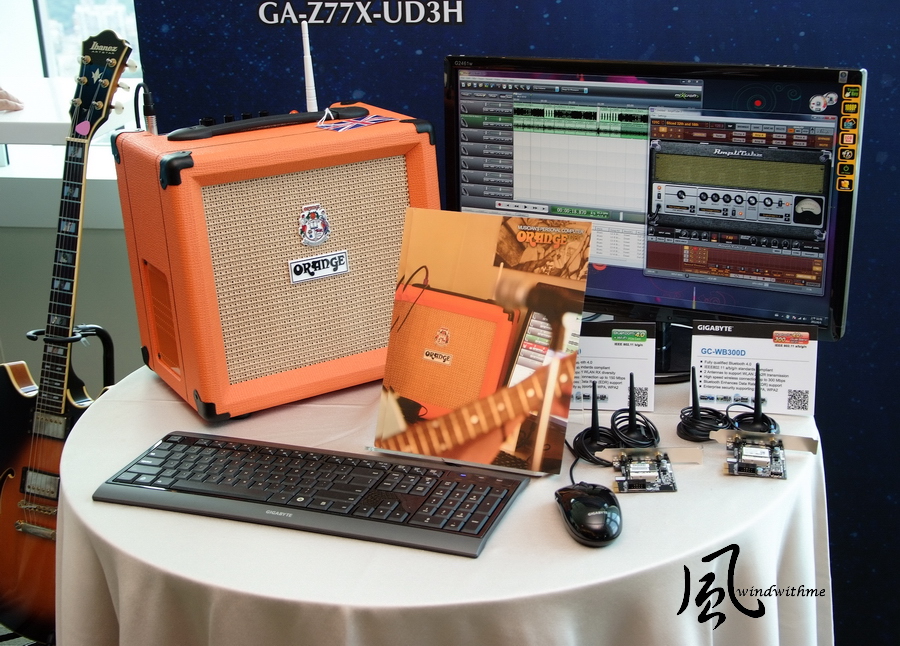
IR3550 PowlRstage


BIOSTAR
Intel MB
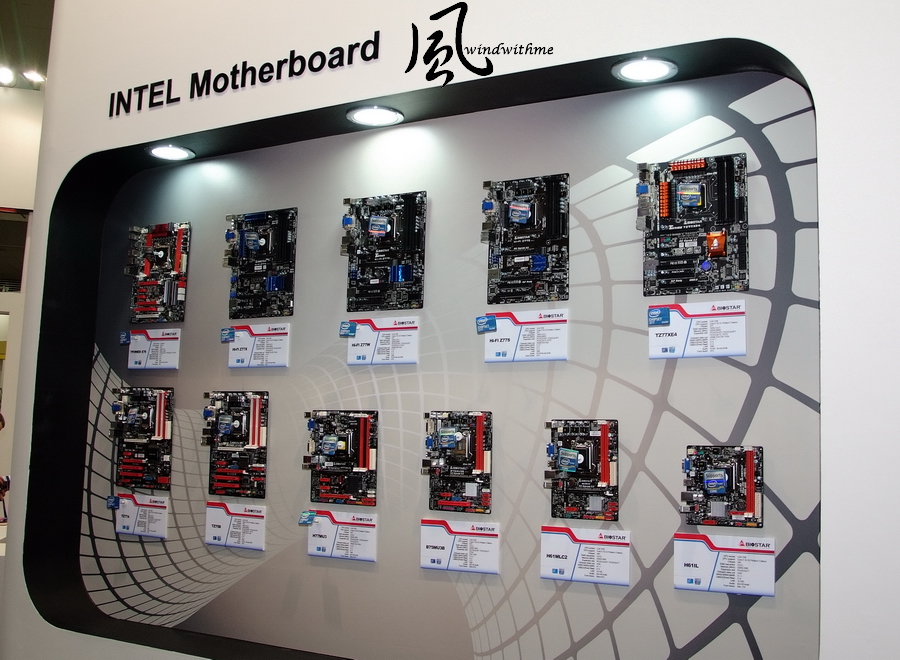
AMD MB

Z77 MB
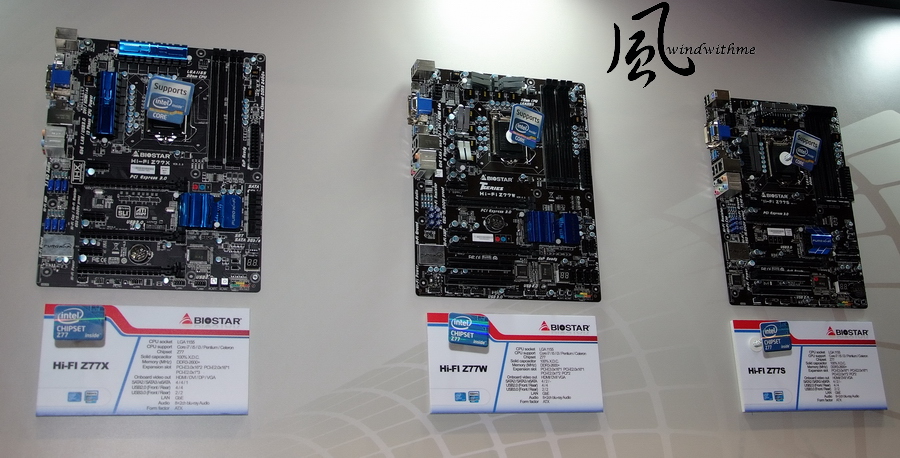
Hi-Fi AMP
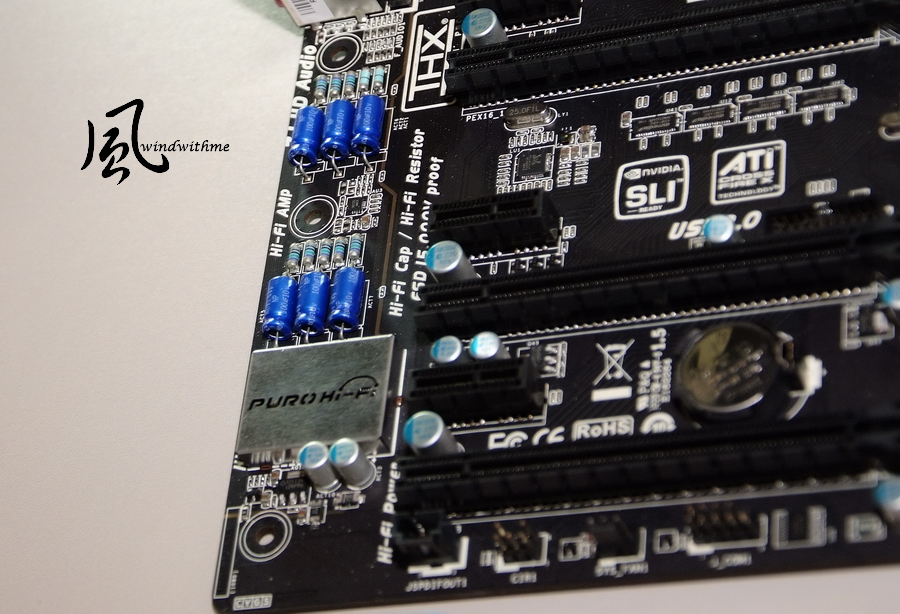
-
3 minutes - 100% Write / 100% Random 4KB
Total I/Os per Second 85981.10
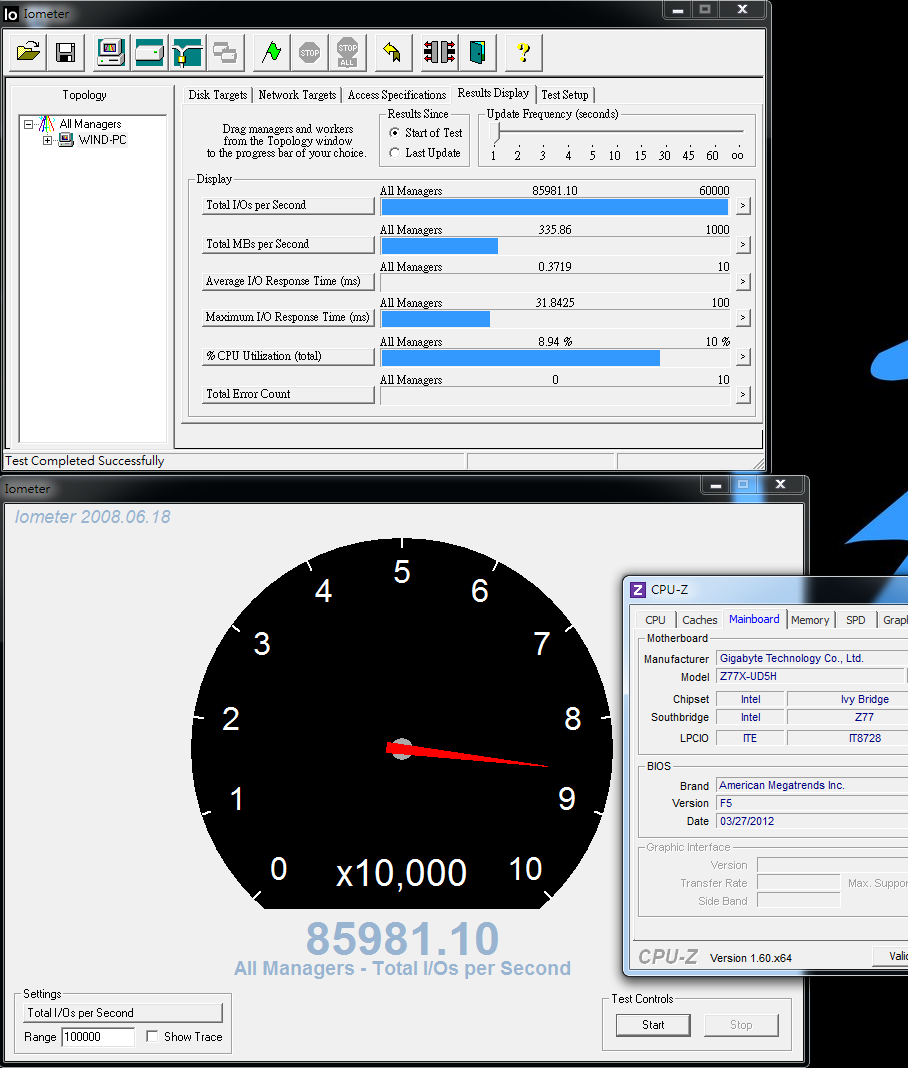
IOMETER 2008 test, you can see the first minute I/Os is extremely high. If the test keeps for 3 minutes, the I/Os becomes lower.
However, it’s still higher than official sepc, max Random Read/Write 39K / 83K IOPS.
Above-mentioned, SandForce controller has special algorithm for Sequential Write.
It leads to the performance speeding. Internet said it designs for reducing writing numbers to increase SSD life.
Anyway, only sequential write can achieve 500 MB/s. For random test, Write is only 180~280 MB/s.
Besides this, Read or 4K is good performance level.
SanDisk uses NAND Flash synchronize IC, the performance is not lower than Intel or Micron IC.
SandForce controller has been in the market for a while. SanDisk SSD can have more competitive price.
Second part is NoteBook test. I still use acer TimelineX 3830TG for performance test.
I have been using this NB for several SSD reviews. The performance won’t be impact by SATA performance.
If I get Ivy Bridge NoteBook in the future, I will move to latest Intel chipset one.

3830TG color is very eye catching. The upper cover is aluminum also. The body is also slim.
Intel chipset is HM65. In NoteBook, it has better SATA3 transfer ability.

SanDisk Extreme 240GB install at SATA3 as system drive.
OS is Windows7 Ultimate 64bit, all drivers and Intel Smart Response Technology.
HD Tune Pro 5.00
Black Size is special function of this software. Left side is default 64K and right side is 1MB.
64K - Read - Average 257.6 MB/s Access Time 0.177ms
1MB - Read - Average 492.4 MB/s Access Time 0.182ms
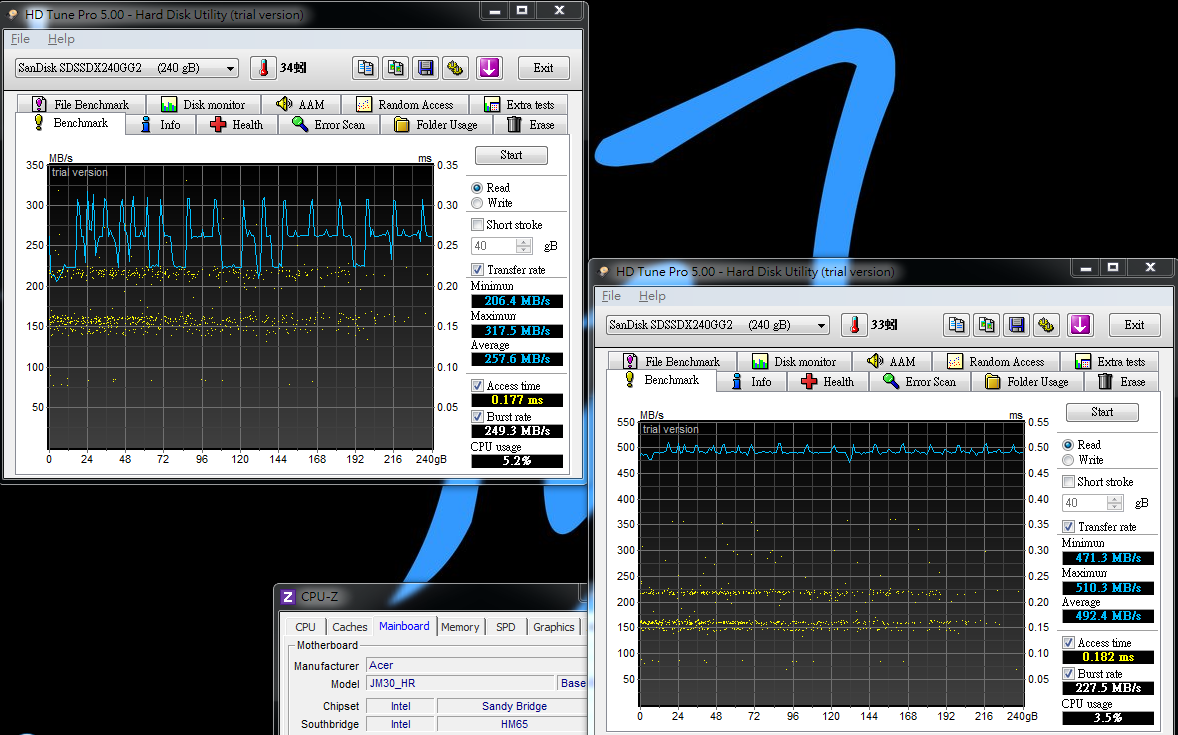
File Benchmark
Sequential Read - 51068 IOPS / Write - 78802 IOPS
ATTO DISK Benchmark over 1024k test, max Read is 556.6 Mb/s and Write is 527.6 MB/s.
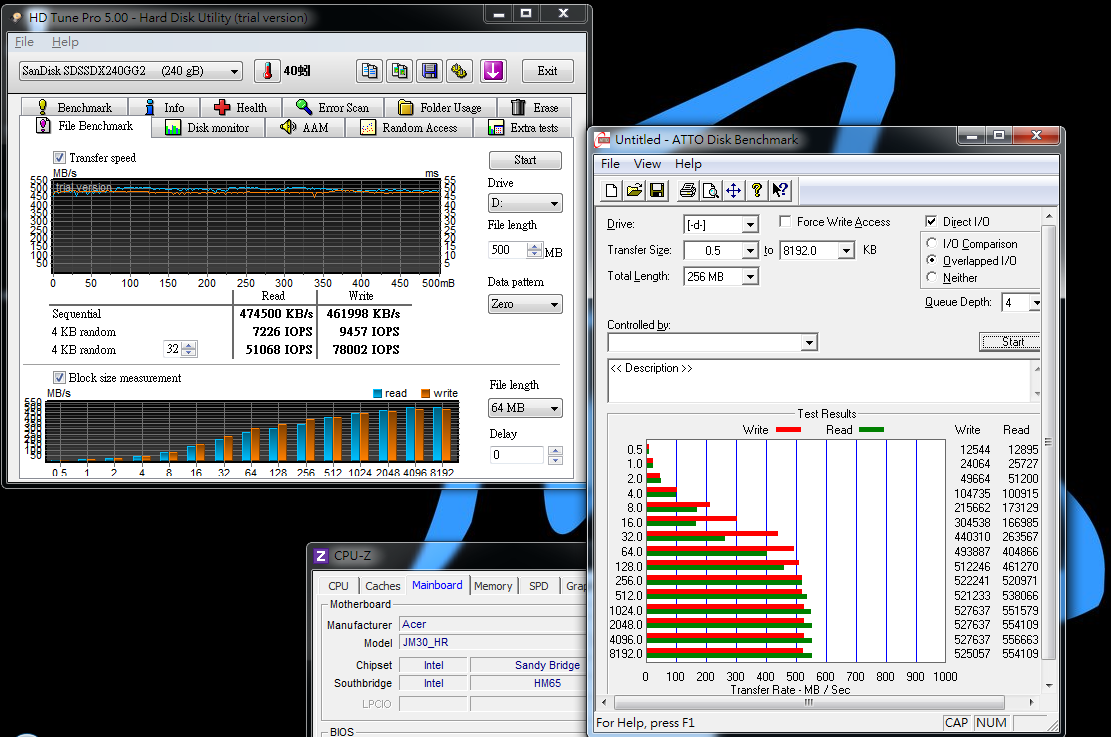
CrystalDiskMark
Seq Read - 435.0 MB/s Write - 233.1 MB/s
<All 0xFF, 1Fill> Read - 466.0 MB/s Write - 472.5 MB/s
<All 0x00, 0Fill> Read - 474.7 MB/s Write - 472.0 MB/s
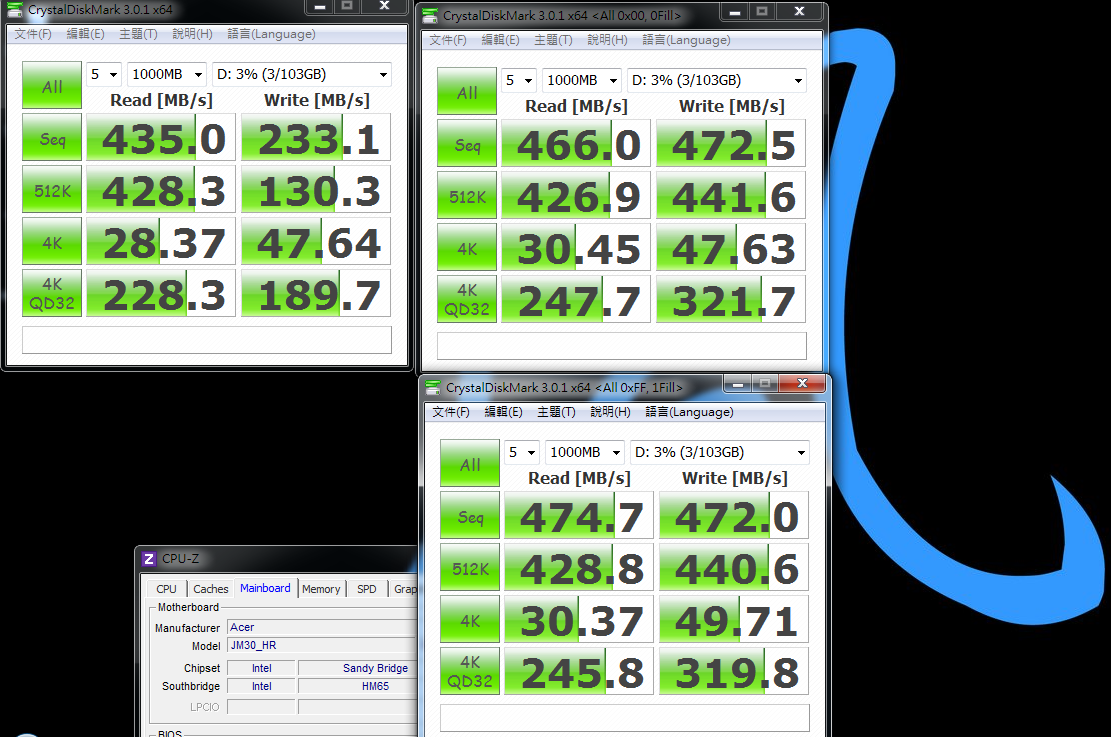
AS SSD Benchmark - 660
Seq Read - 492.39 MB/s Write - 229.45 MB/s
4K - 64Thrd Read - 214.37 MB/s Write - 179.59 MB/s
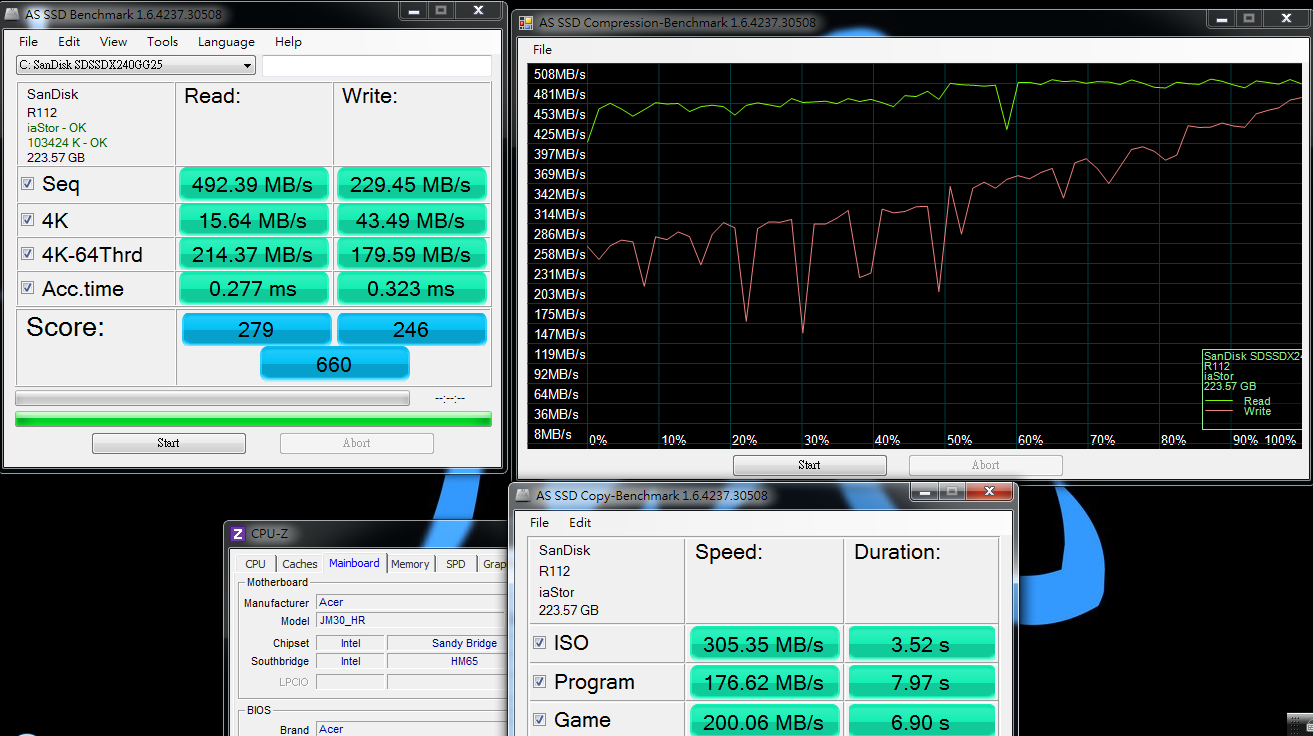
NoteBook SATA transfer rate is around 10% lower than DeskTop, especially 4K Write.
3830TG SATA3 transfer rate is lower than PC, but it’s still acceptable.
BootRacer
Time to Logon 5~6 seconds
Time to Desktop 14~15 seconds
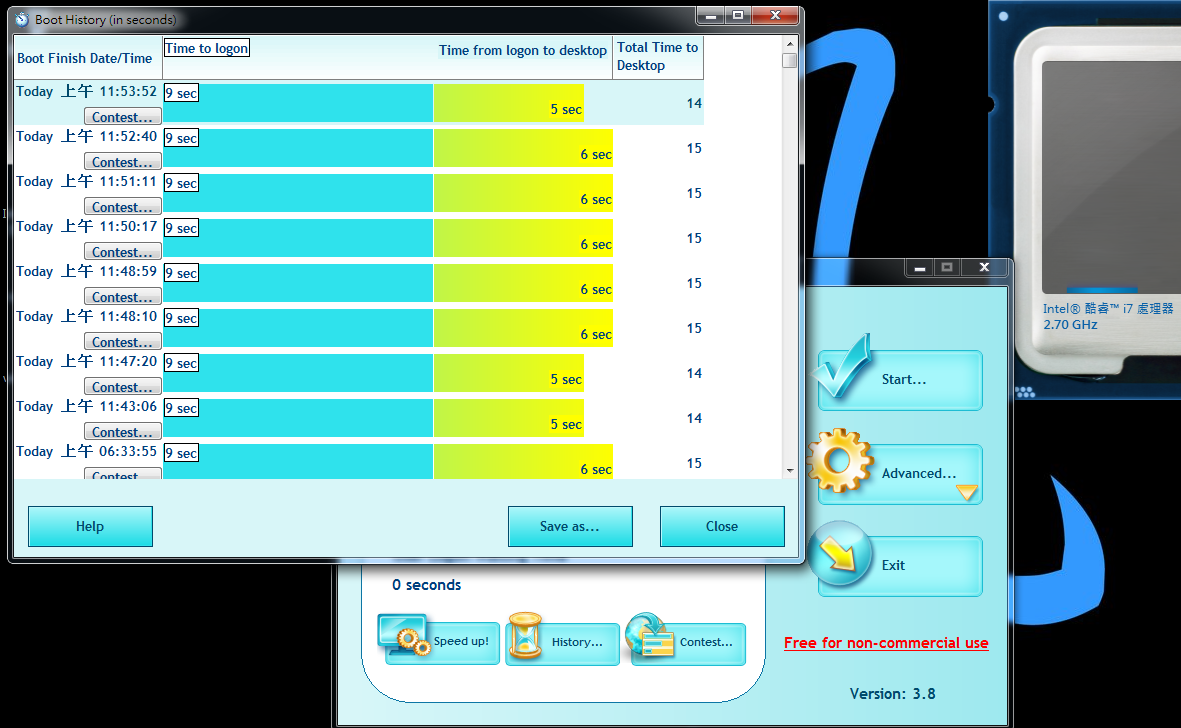
Previously, I use TOSHIBA MK6461GSY 640GB 7200, Time to Desktop was 42 seconds.
SanDisk Extreme 240GB in Time to Desktop is 15 seconds.
I use same NoteBook for both drives and install same drivers and software.
SSD really can speed up NoteBook. SSD booting speed is 2.8 times faster than HDD.
Of course, starting software is also much faster, especially you can feel for bigger files.
These three years, SSD all drop price annually. It can encourage users and market to move to SSD.
In 2010, 32GB was 120USD and 64GB was 220USD. Last year, 64GB was 120USD and 128GB was 220USD.
This year, the market is starting to wriggle. Recently, 120/128GB and 240/256GB are starting to drop price in some regions.
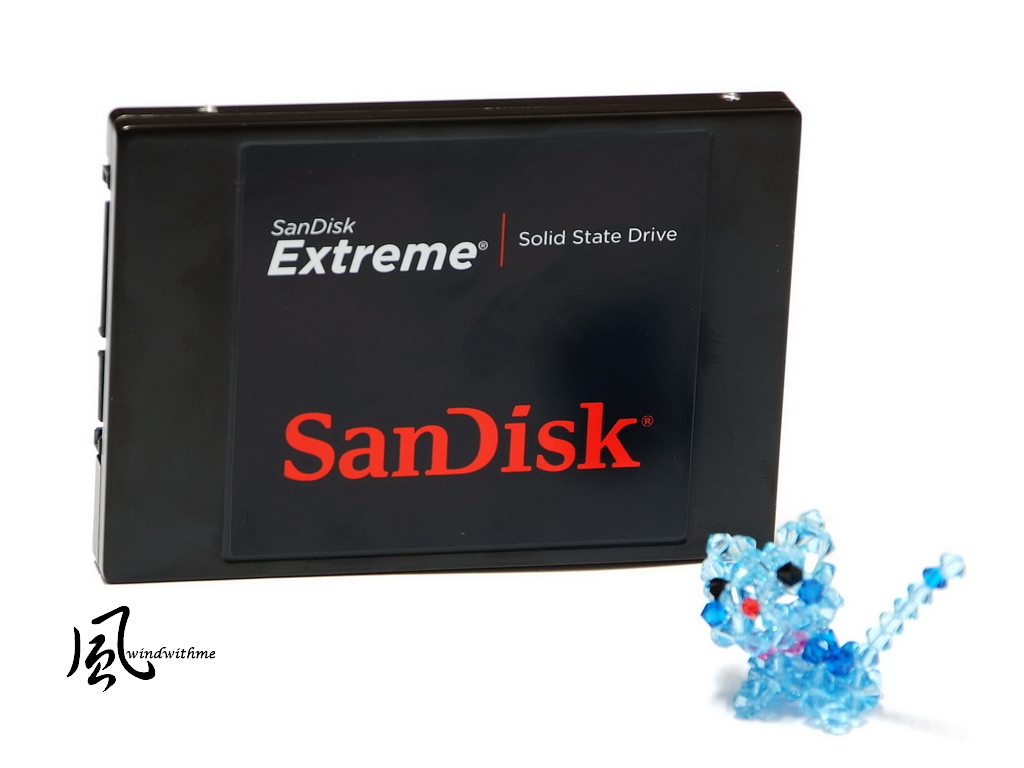
SanDisk Extreme 240GB price in Taiwan is 7800NTD, around 266USD.
Using SandForce SF-2281 high speed controller and synchronize NAND Flash IC to own high performance.
This cost performance can be the lowest price in same market position.
SanDisk just comes into SSD market and go straight to low price and high performance product line.
If they also provide good warranty and firmware upgrade, SanDisk can be a new brand with high C/P.

This review is also in my blog WIND3C, Any comments are welcome.
-
HD Tune Pro 5.00 set Black Size as 1MB can have the best performance.
64K - Write - Average 282.9 MB/s Access Time 0.099ms
1MB - Write - Average 335.2 MB/s Access Time 0.177ms
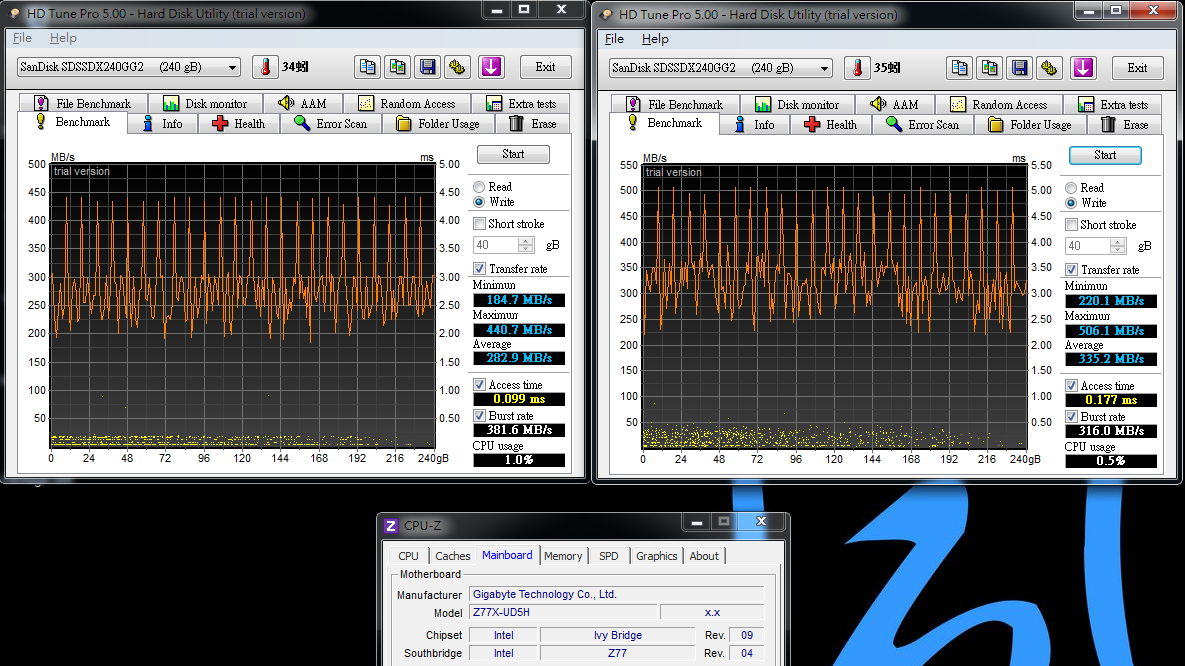
Read - Random Access & Extra tests
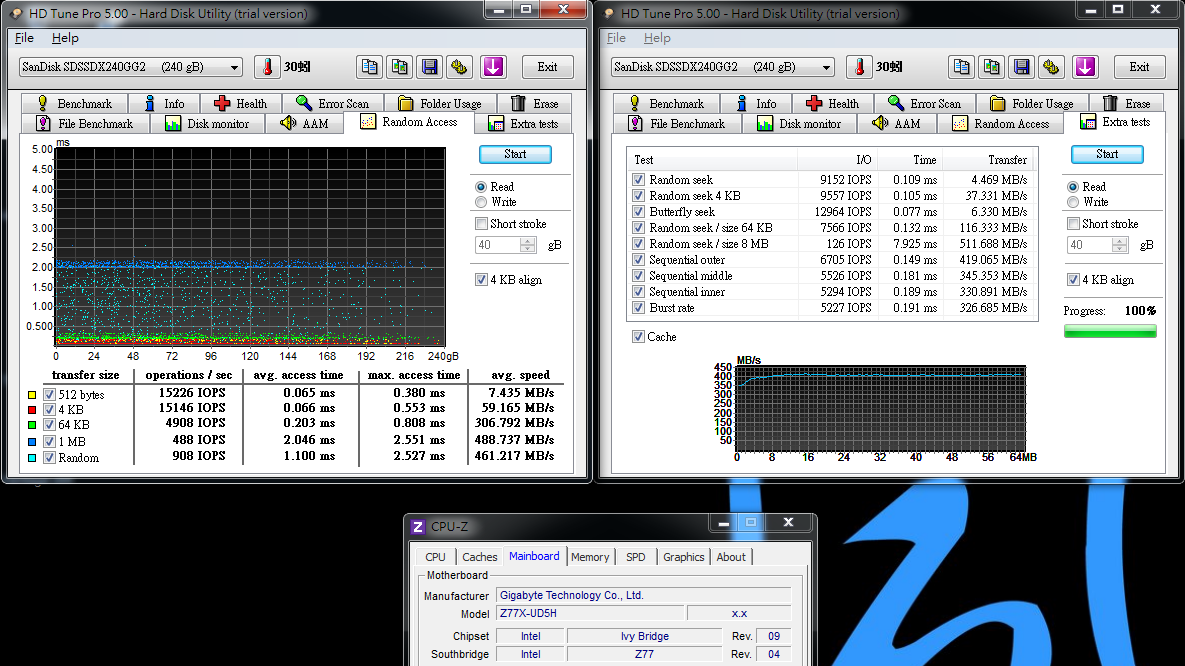
Write - Random Access & Extra tests
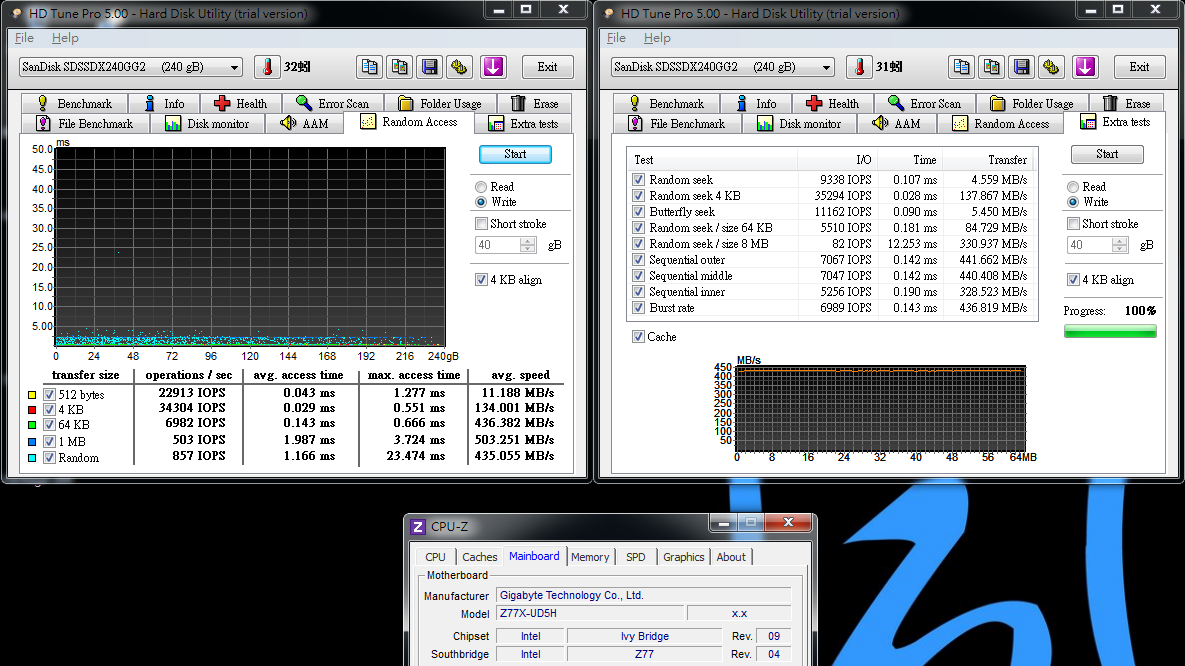
File Benchmark
Sequential Read - 60431 IOPS / Write - 911977 IOPS
ATTO DISK Benchmark over 512k test, max Read is 559.2 Mb/s and Write is 535.6 MB/s
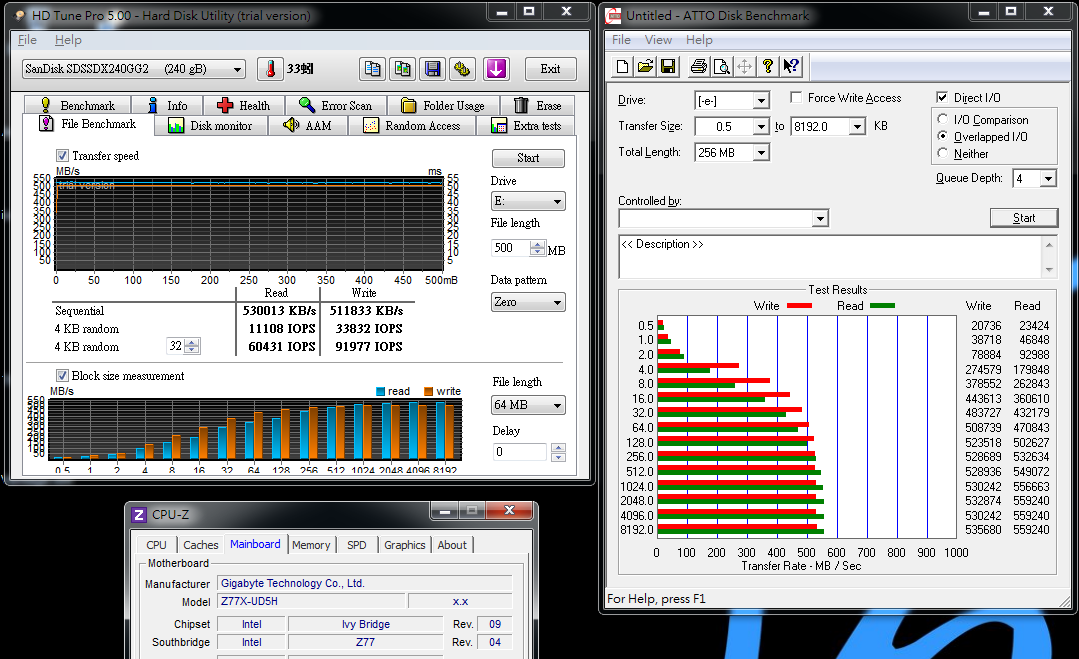
HD Tune Pro 5.00 revises File Benchmark to be more detail. There are more paramaters for reference.
ATTO DISK Benchmark test result is over official Read 550 and Write 520 MB/s.
CrystalDiskMark
Seq Read - 524.6 MB/s Write - 298.3 MB/s
<All 0xFF, 0Fill> Read - 530.0 MB/s Write - 525.7 MB/s
<All 0x00, 1Fill> Read - 529.6 MB/s Write - 525.7 MB/s
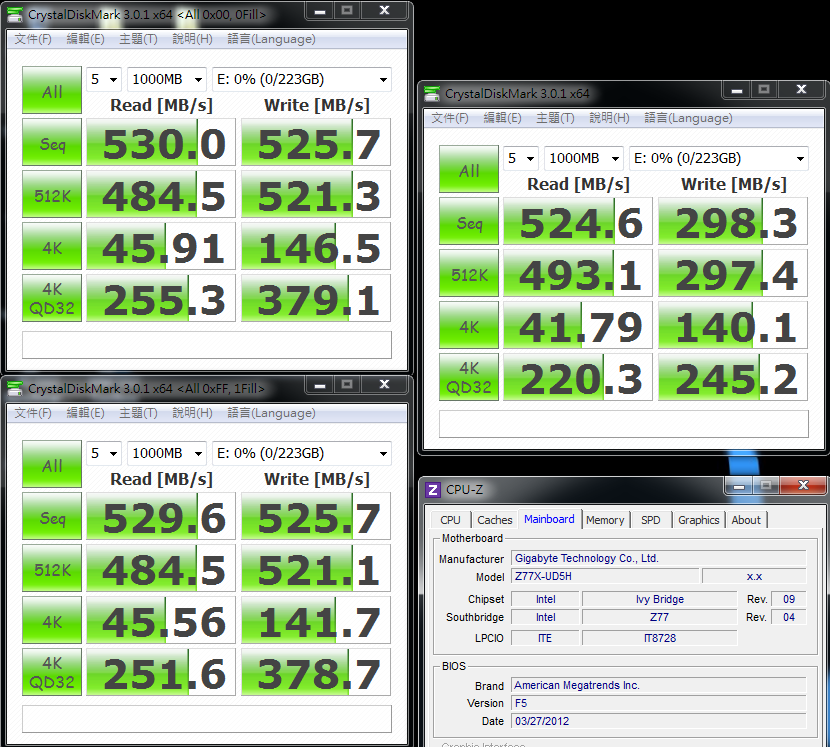
CrystalDiskMark default test is random, As right-hand picture, the Write performance is lower.
This part is caused by SandForce controller structure. The performance will be lower as algorithm.
Left side CrystalDiskMark test changes to two pure sequential mode. The Write is close to official spec.
SandForce has special algorithm in Sequential Write. The speed starts from 280MB/s and ramp to 500 MB/s slowly.
This is also a weakness of SandForce controller.
AS SSD Benchmark - 824
Seq Read - 519.10 MB/s Write - 280.41 MB/s
4K - 64Thrd Read - 227.01 MB/s Write - 222.52 MB/s
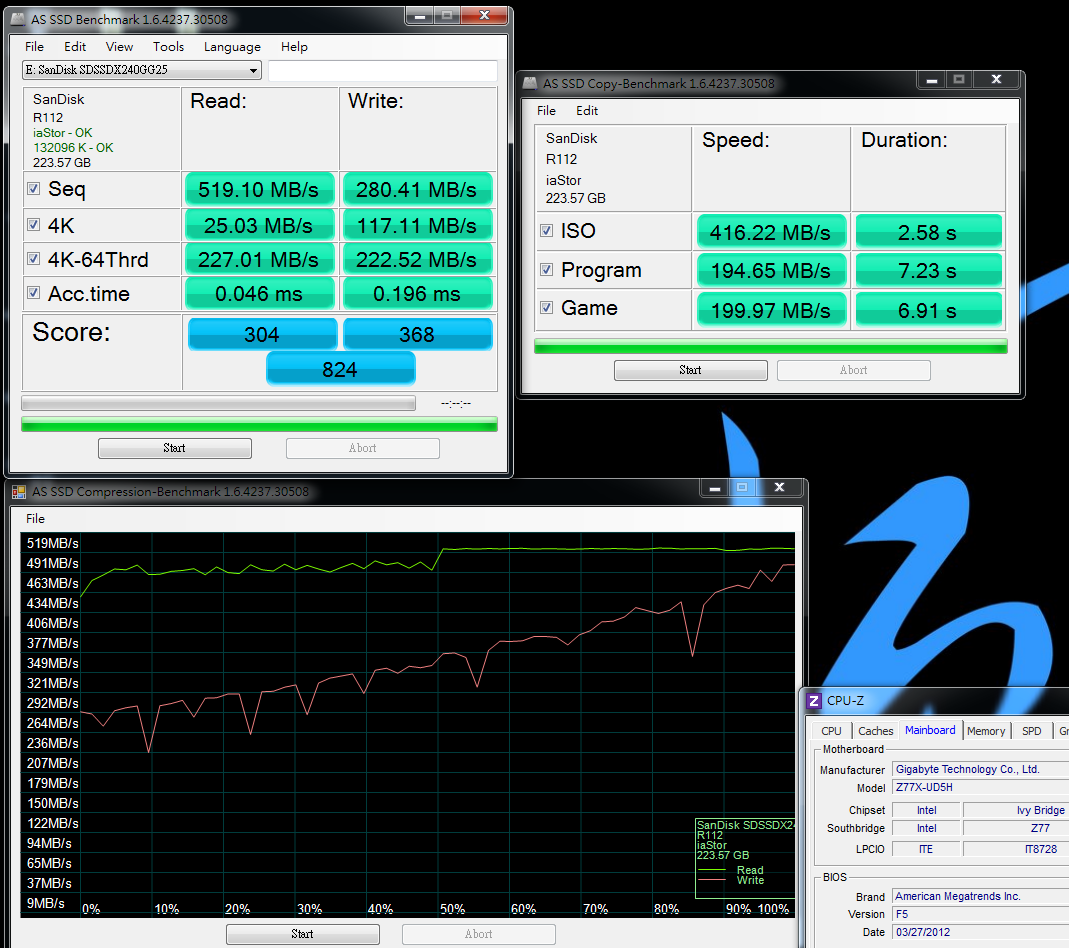
SandForce structure will be changed by SSD capacity.
AS SSD Benchmark with 120GB is only 500, but it improves to 700~800 with 240GB.
You can see 240GB Write Seq/4K-64Thrd is much better than 120GB.
AS SSD Benchmark in personal experience, the ratio is more on 4K and 4K-64Thrd.
In these 2 items, if the transfer rate is higher, the total will be higher as well.
PCMark Vantage - HDD Score : 85720
CrystalMark Sequential Read 505.88 MB/s Sequential Write 501.55 MB/s
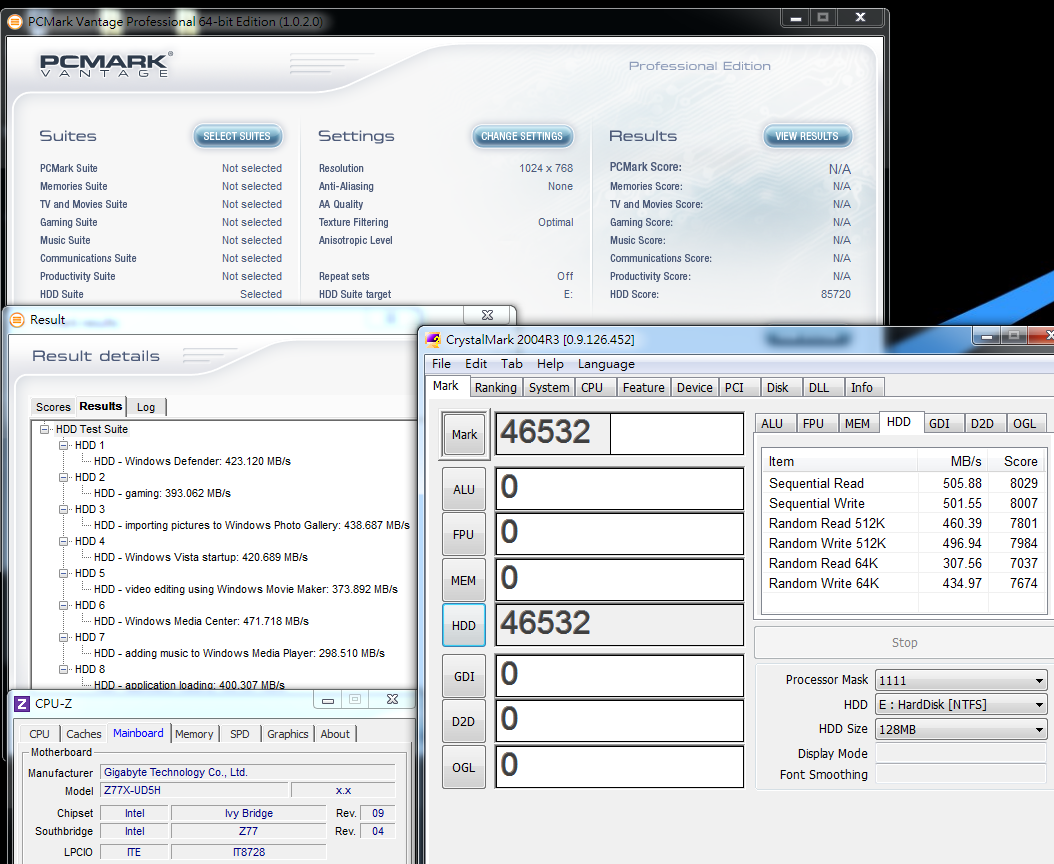
IOMETER 2008
1 minute - 100% Read / 100% Random 4KB
Total I/Os per Second 57420.61
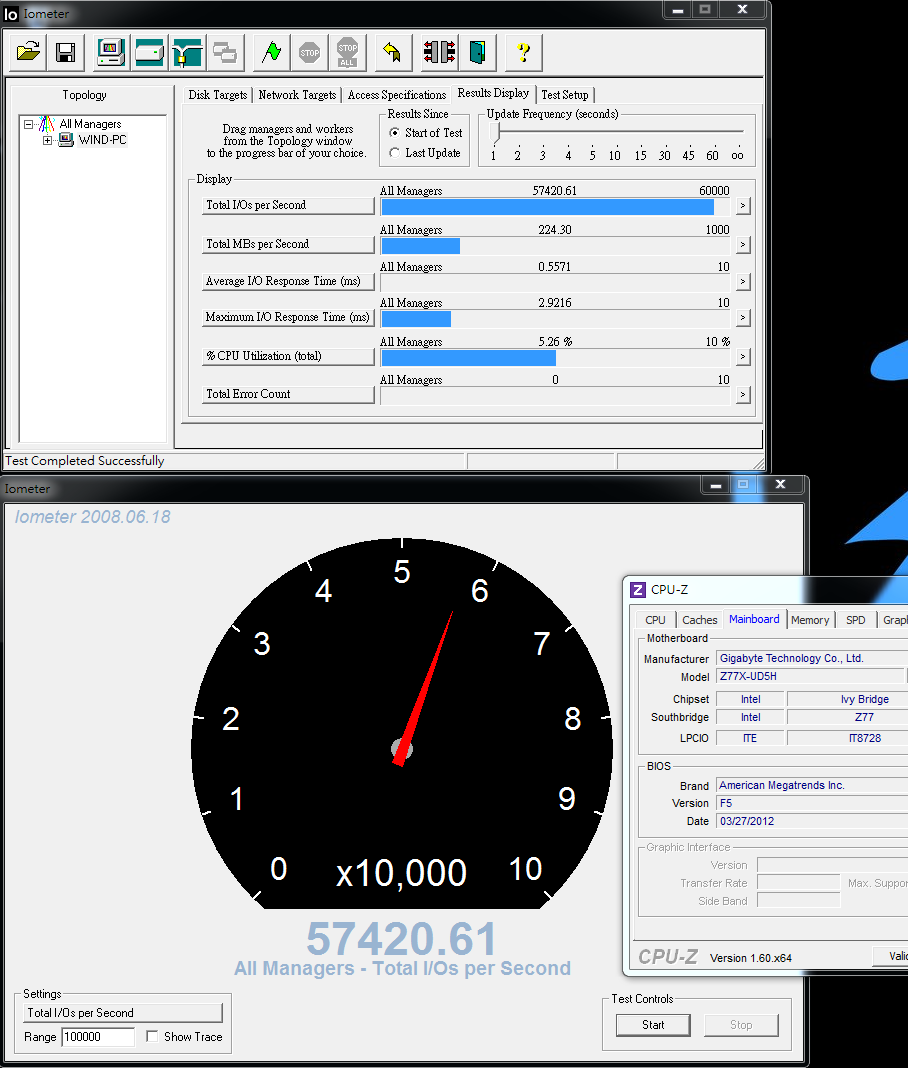
3 minutes - 100% Read / 100% Random 4KB
Total I/Os per Second 56000.22
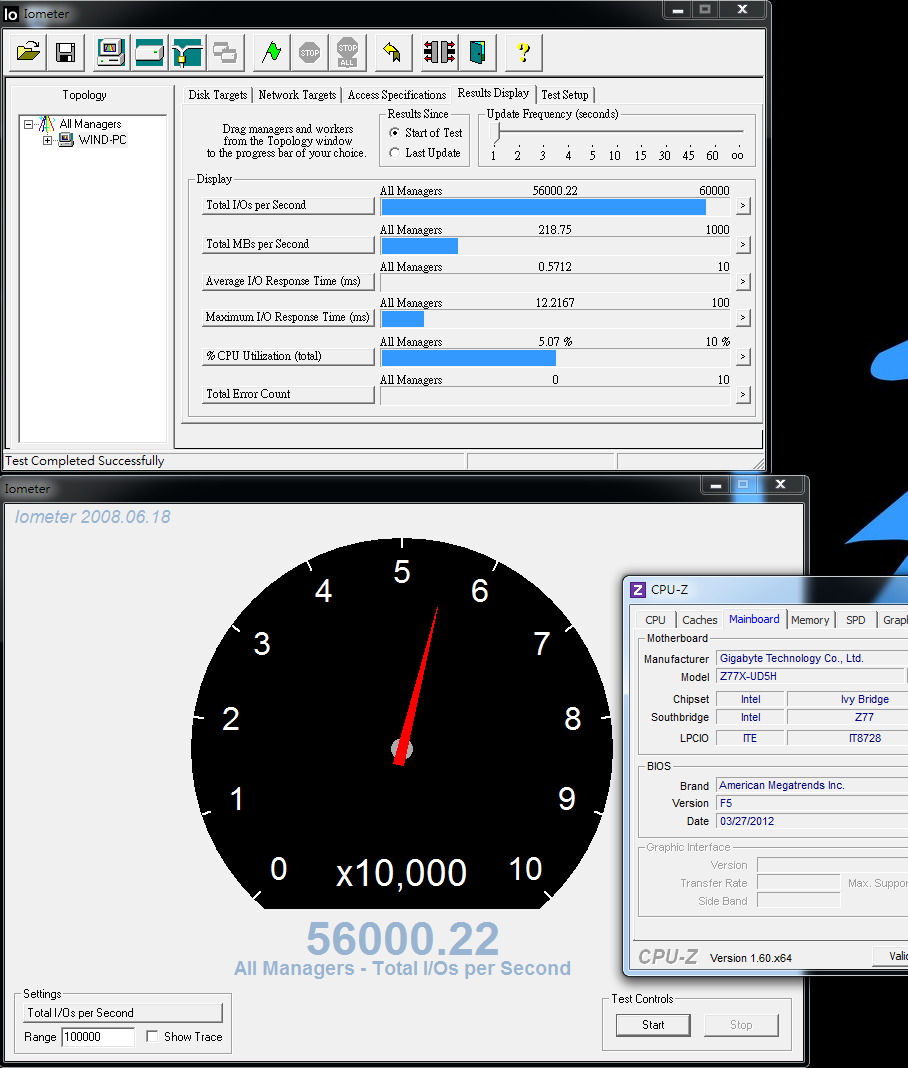
1 minute - 100% Write / 100% Random 4KB
Total I/Os per Second 91930.96

-
In my impression, SanDisk is well known brand in Taiwan for years.
My first SanDisk product was CF card for digital SLR camera.
After another, I also used or researched other brands CF and SD card. I think memory card is key field of SanDisk.
SanDisk has wide range product lines of high spec. memory card. It’s also one of few brands to have SLC products.
Previously, I saw some SanDisk SSD products from internet were SATA2 and mSATA.
I felt they more focus on NoteBook and didn’t see any SATA3 high bandwidth product yet.
However, in March, I started to see more news about SanDisk SATA3 SSD in internet and market.
For current competitive SSD market, launching SSD this stage needs to own real strength and right position.
First of all, let’s look at SanDisk Extreme SSD packing.
It’s same design style with his memory card. The simple design uses black as main color to combine with red lines or characters.
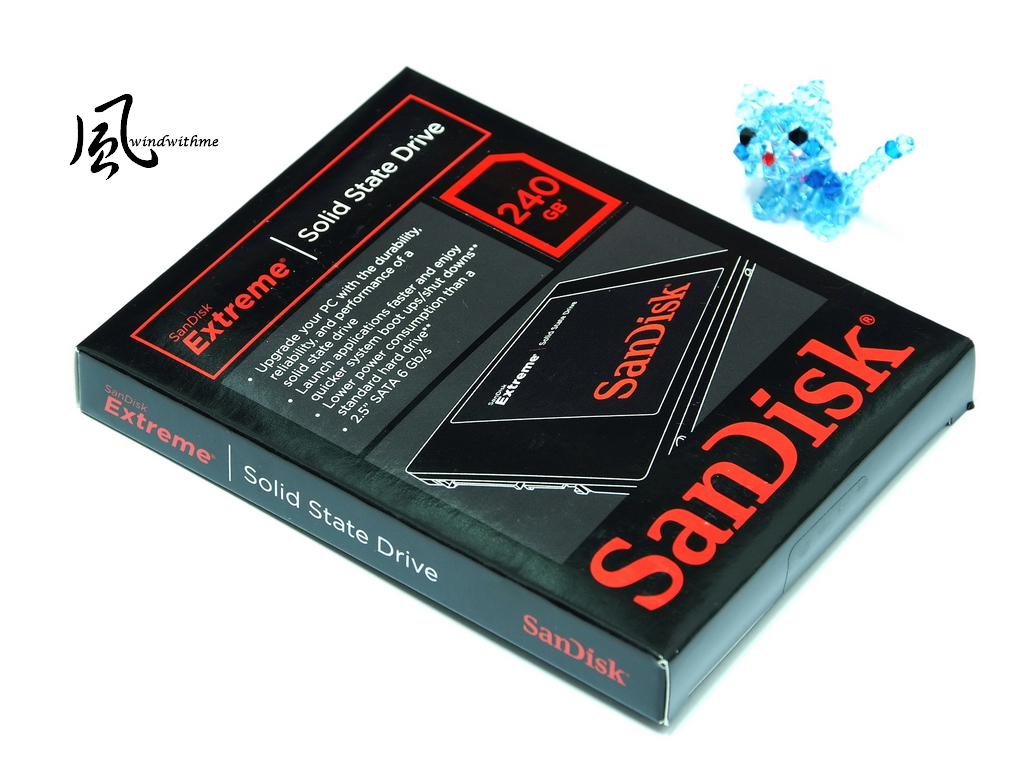
Contents
Left side is SanDisk Extreme 240GB and sticker. Right side is multi-languages products manual.
If they can bundle 2.5” to 3.5” adapter, that would be better.
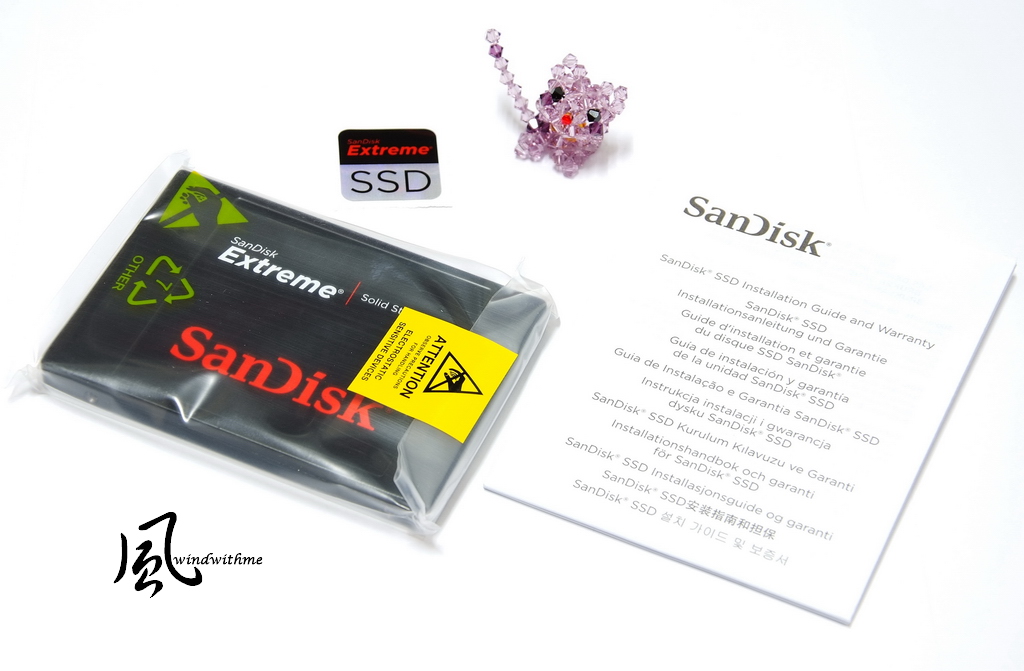
It’s 2.5” and the capacity is 240GB. In official spec, max Sequential Read/Write is 550/520 MB/s.
Max random Read/ Write is 39K/83K IOPS. It’s the SATA3 SSD highest spec in the market so far.
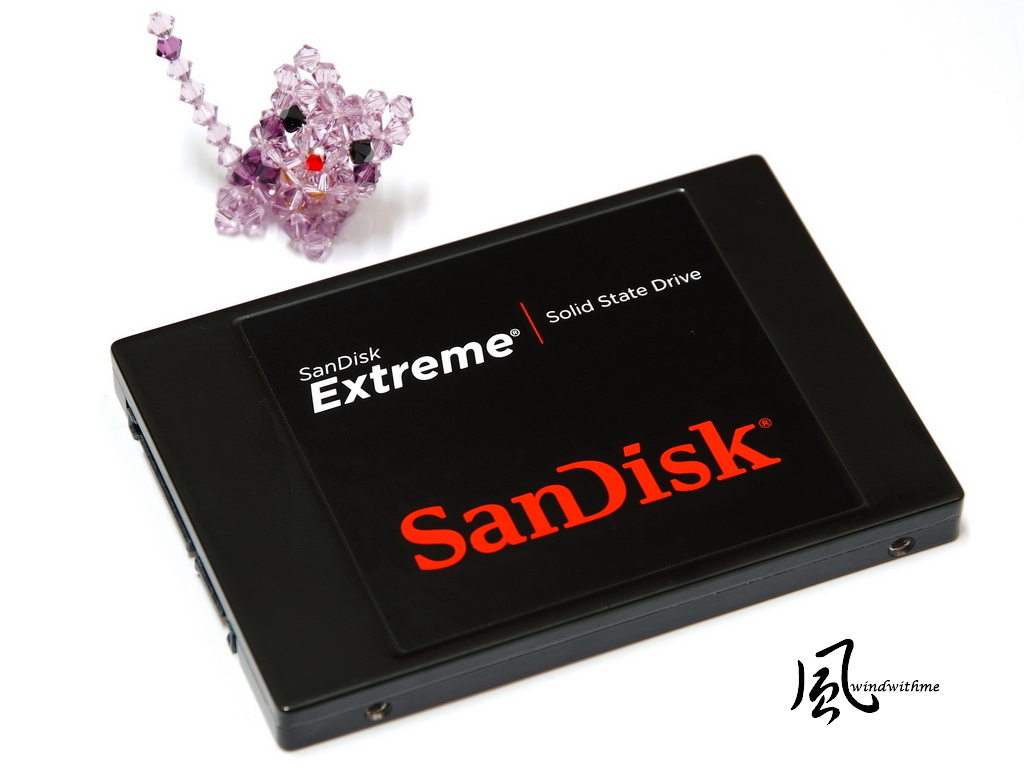
The model name is SDSSDX-240G-G25. This series has 120, 240 and 480GB.
It’s glossy black metal shell. The texture of outlook is elegant.
Controller chip is SandForce SF-2281. This chip has launched almost one year. Many major brands SSD are also using SF-2281.
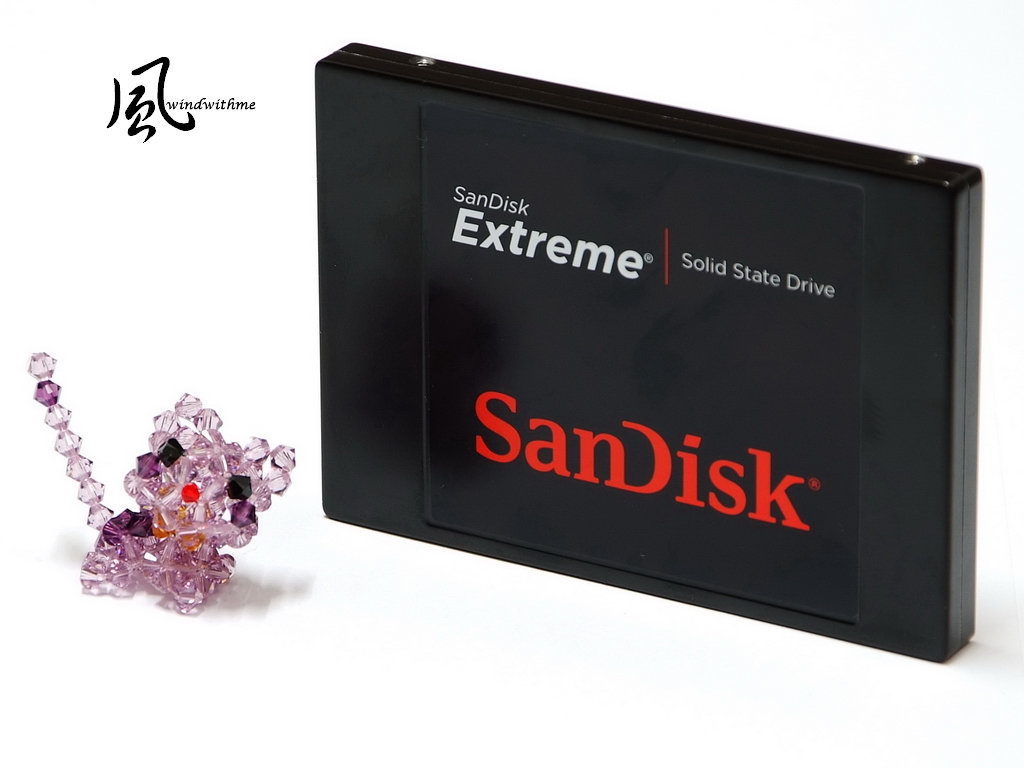
Backside sticker shows all safety certificate and information.
The screws are under sticker which is different with general design.
If you want to see controller and NAND Flash inside, you can search the pictures from internet.
As warranty and hardware safety, I recommend you to keep it as original.
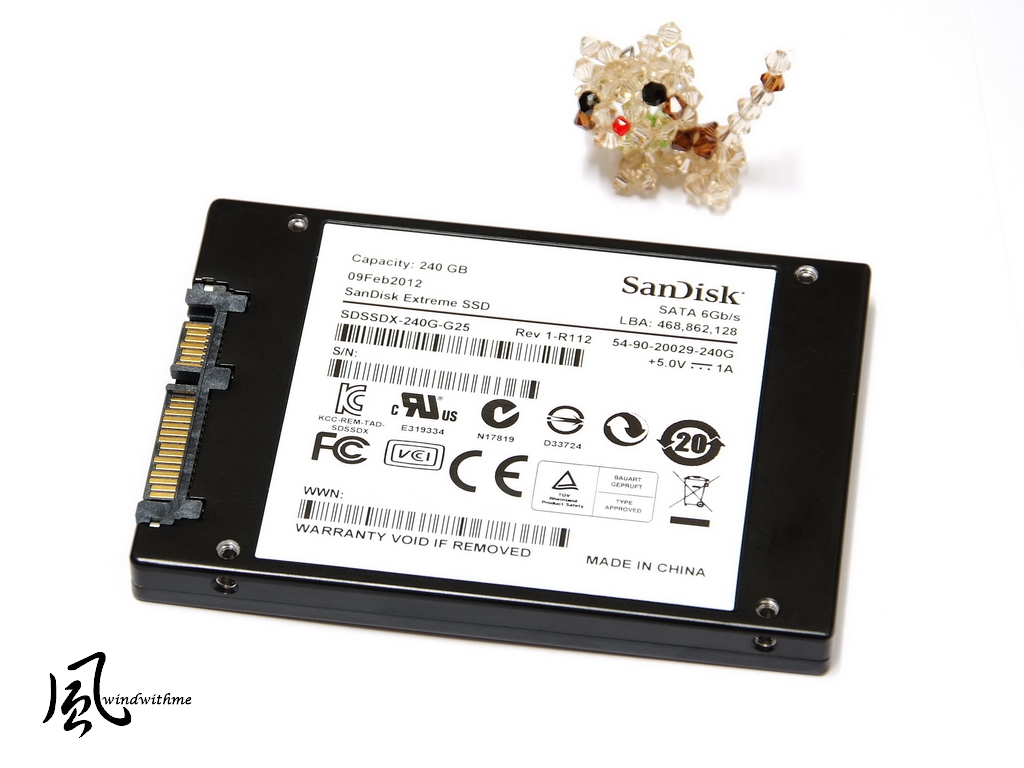
Lower right is SATA3 and power connector. It’s same as SATA1 or SATA2.
You need to check the packing or product spec to know if it’s SATA3 SSD.

Screw holes are 2.5” standard. It supports NoteBook.
Now, many PC Case also support 2.5” rack. 2.5” to 3.5” adaptor is not really necessary for PC users.
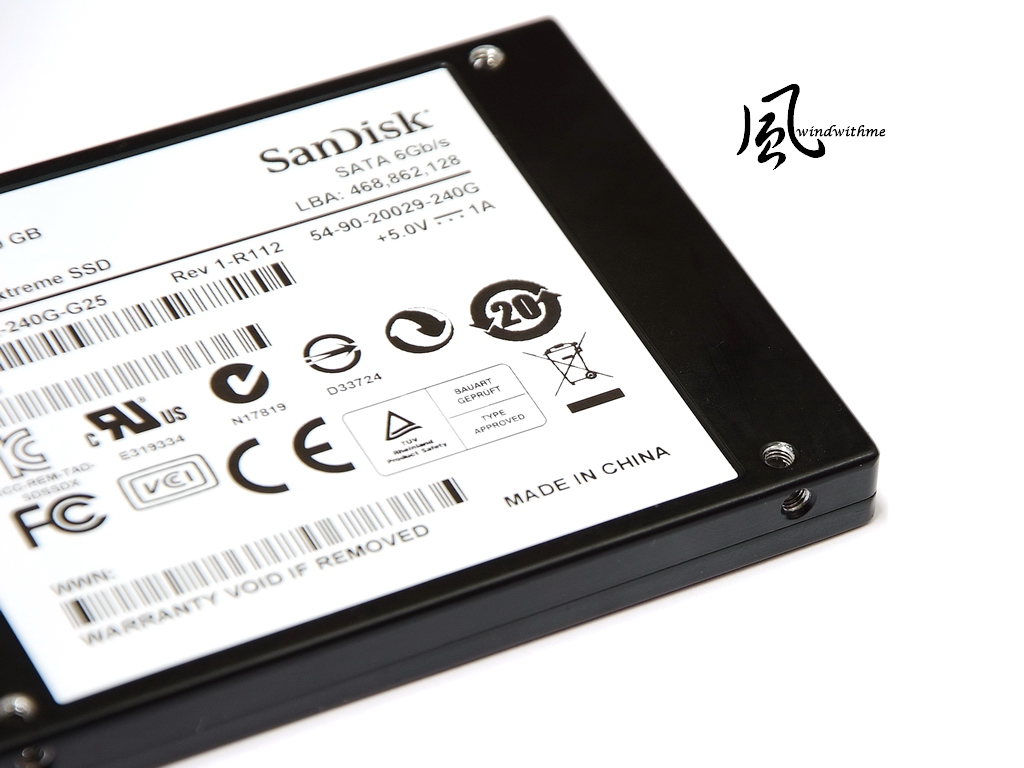
SanDisk Extreme uses SandForce SF-2281 controller. It’s very popular SATA3 SSD controller.
It uses anDisk 24nm Synchronize NAND Flash. The individual IC is 32GB.
NAND Flash IC is very special. Normally, SandForce SF-2281 bundles with Intel or Micron IC.
For the performance, let’s follow on the test result below.
First, I use Intel DeskTop platform. It’s GIGABYTE latest Z77X-UD5H-WB WIFI.
It supprts 3 PCI-E X16, 3 PCI-E X1 and 1 PCI. It’s good extensibility in ATX size.
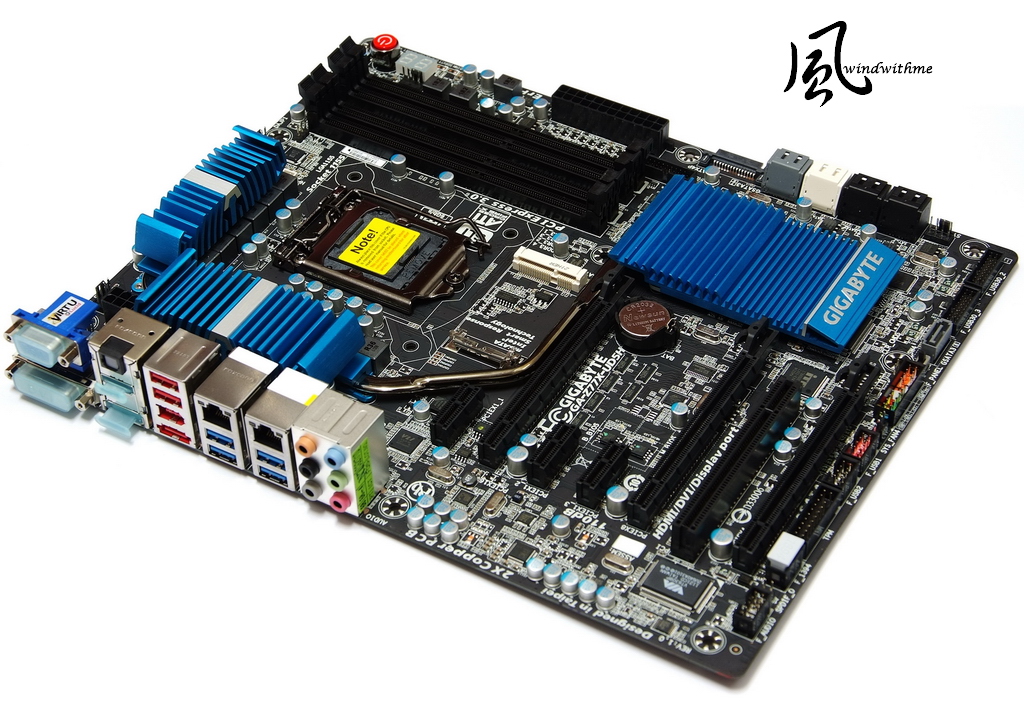
Z77 built-in GPU supports simultaneously three outputs. It’s also first time native support USB 3.0.
Exclusive BT4.0 and Wi-Fi PCI-E card enhance connection between PC and mobile devices indoor.
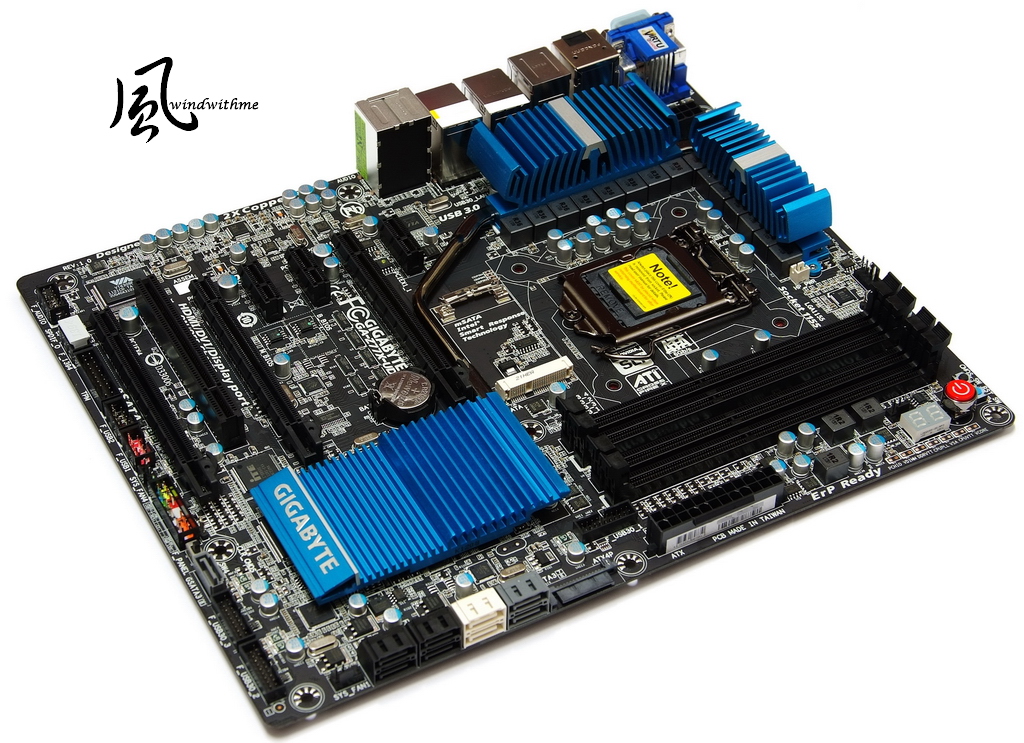
Intel Z77 is latest mid to high end chipset. It’s getting popular.
Intel chipset always gets better I/O transfer rate. SATA3 SSD can have better performance on it.
Test Configuration
CPU: Intel Core i7-3770K
MB: Z77X-UD5H-WB WIFI
DRAM: CORSAIR DOMINATOR-GT CMT16GX3M4X2133C9
VGA: Intel HD Graphics 4000
HD: SanDisk Extreme 240GB / TOSHIBA 750GB
POWER: CORSAIR AX650W
Cooler: Intel Original Cooler
OS: Windows7 Ultimate 64bit
Single SanDisk Extreme 240GB install at white SATA3.
I set it as non-OS drive without any data to test performance on Intel Z77 platform.
HD Tune Pro 5.00
Black Size is special function of this software. Left side is default 64K and right side is 1MB.
64K - Read - Average 339.5 MB/s Access Time 0.134ms
1MB - Read - Average 516.0 MB/s Access Time 0.135ms
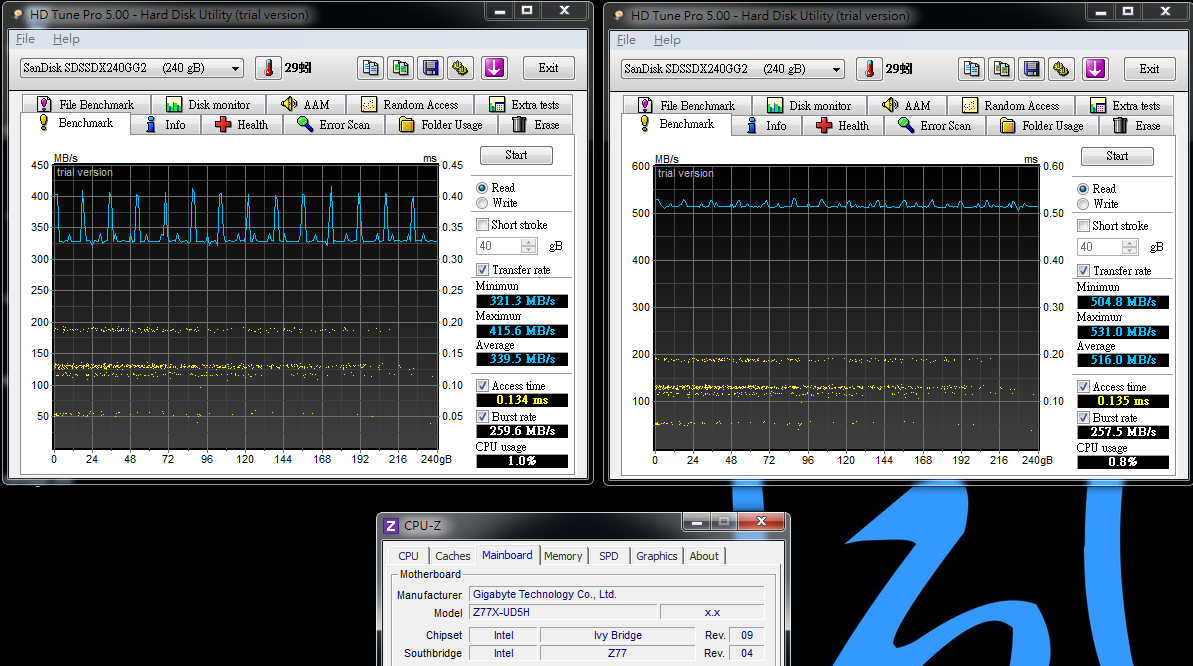
-
FINAL FANTASY XIV
1280 X 720 => 1756
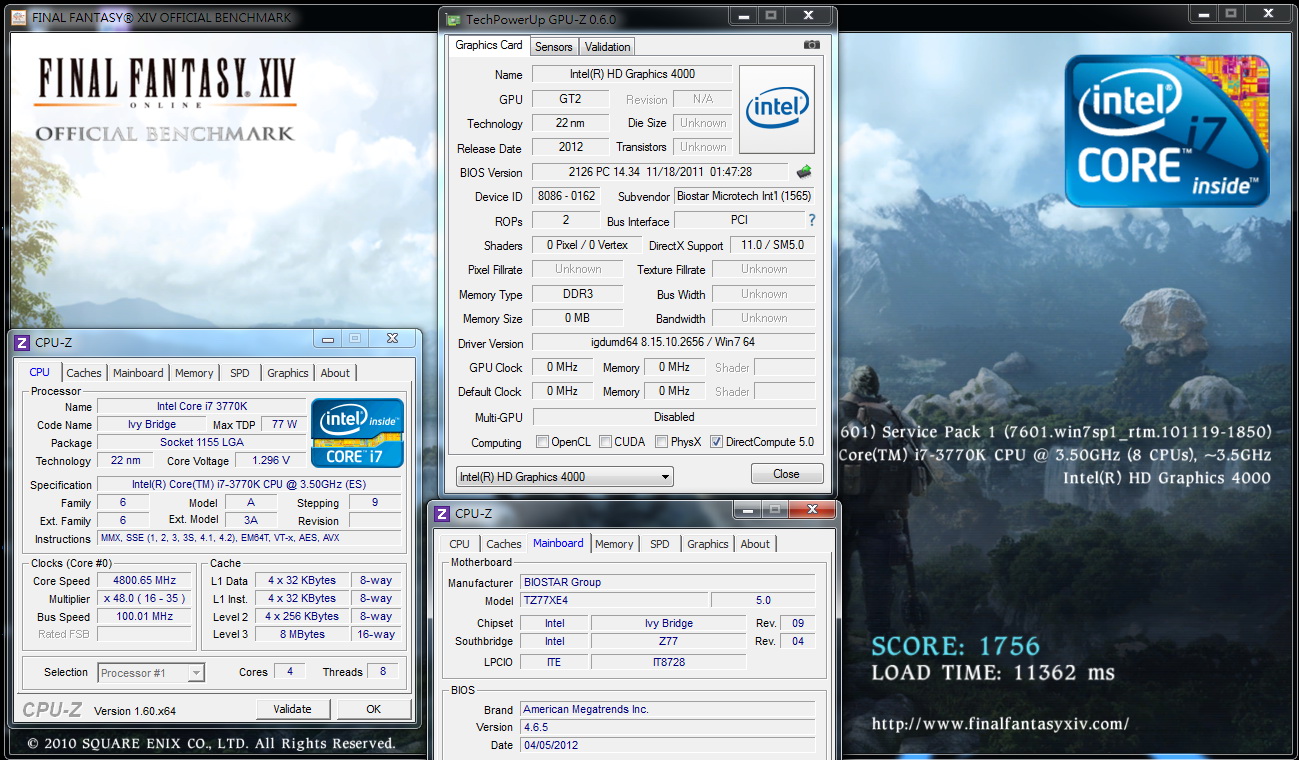
The overclocking performance of Intel HD Graphics 4000 is increased by 4~21%, which is determined by the characteristics of 3D software.
Compared with the last-generation HD Graphics 3000, the 3D performance is increased by over 60%, which is rather better.
Moreover, it catches up with the CPU of the highest 3D display performance currently, namely Radeon HD6550D of AMD A8-3850
Given that it started to improve the built-in GPU technology of CPU last year, and provided competitive 3D performance, sometimes it is even better than the basic-level VGA.
Certainly, the built-in GPU is difficult to work with middle and high-level 3D software, but the 3D performance keeps increase with each new generation platform.
In the future, the built-in CPU will be applied more widely, so it is a piece of good news to the consumers.
Temperature performance (Ambient temperature is 28 Celsius)
When system standby - 34~41

Running LinX, CPU at full speed - 74~84
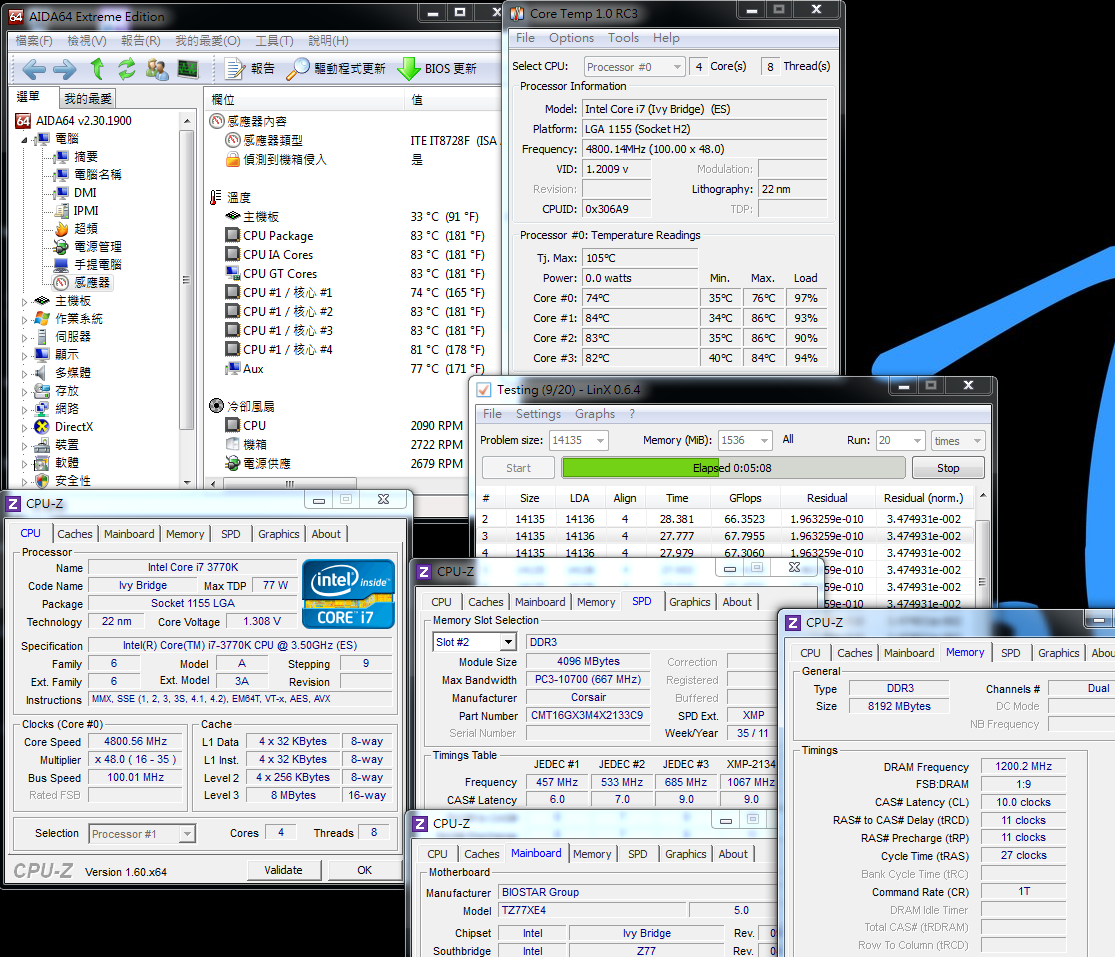
Given the same frequency, the temperature of Ivy Bridge is higher than that of Sandy Bridge, which is a defect for this new platform.
The temperature performance of 3770K in 4.8GHz is similar to that of 2700K overclocking to 5GHz,
and the performance of these two CPUs at this frequency is almost the same too.
As the temperature is higher than the old platform, the CPU radiator will be one of the important factors in Ivy Bridge overclocking.
Power consumption test
When system standby - 67W
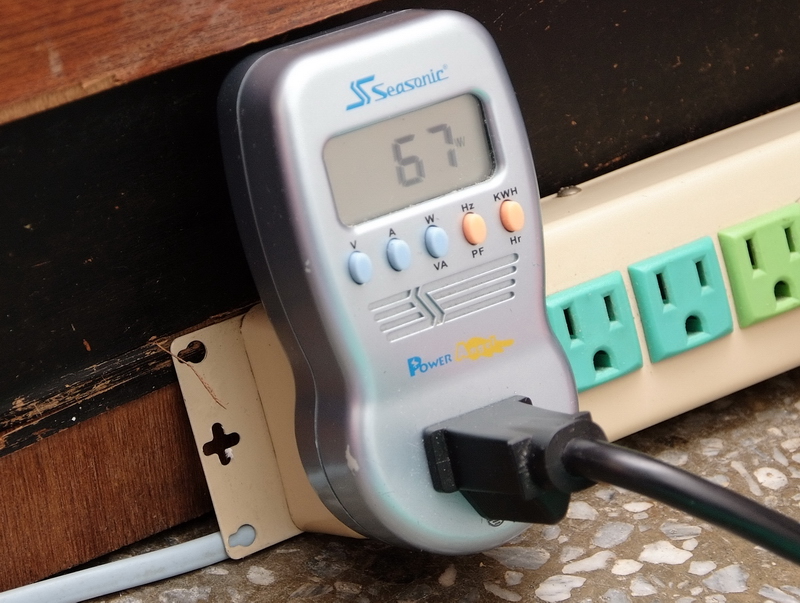
Running LinX, CPU at full speed - 175W
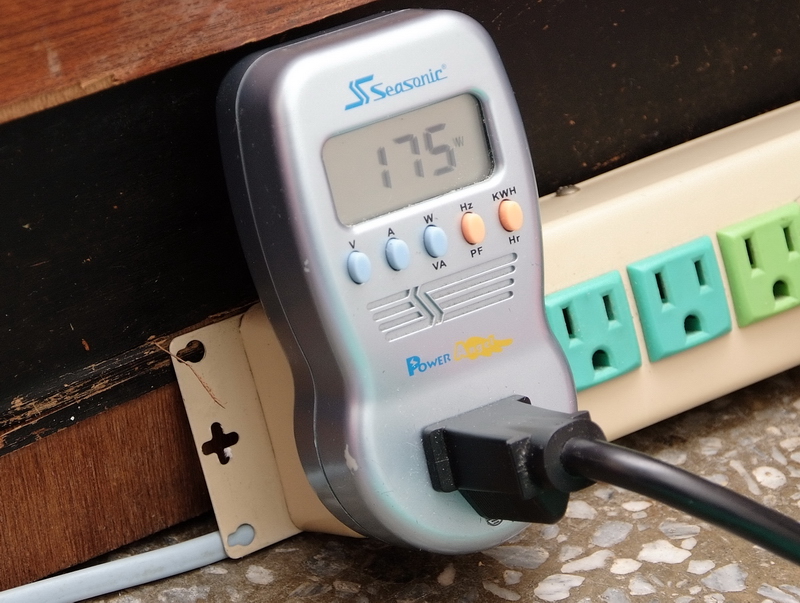
Compare the 103W / 239W of 2700K overclocking to 5GHz with 67W / 175W of 3770K overclocking to 4.8GHz.
With the C1E Power-Saving Function turned off, 3770K is 36W lower at system standby and 64W lower at full speed.
Intel adopts the latest 22nm processing in 3770K, it consumers less power than the last-generation Sandy Bridge when overclocking.
With the advanced radiator of CORSAIR Hydro Series H100, authenticate CPU-Z of5.1GHz / DDR3 2666 with voltage increased.
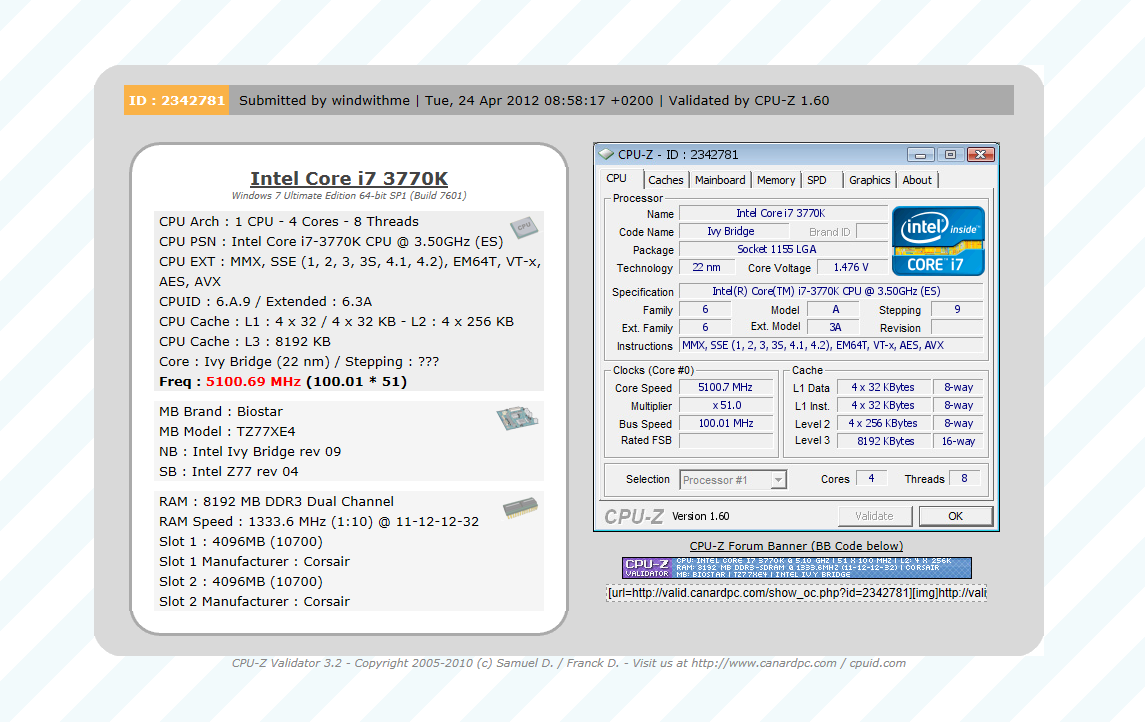
It can be seen currently that the Ivy Bridge with 4C8T running at full speed will get higher CPU temperature than before.
If using the top-level air cooler or water cooler together with the 3770K of good property, it is personally estimated that the frequency that can pass all software test is around 4.8~4.9GHz.
However, 3770K doesn’t have the limitation of 50 times for frequency multiplication like before, and the CPU can reach high frequency when it is not at full speed.
For the extreme-overclocking users, it is easier for 3770K to reach high frequency than 2700K.
For this part, it has both advantages and weaknesses. For most platforms, the maximum stable frequency reached by common radiation environment is very important.
BIOSTAR TSERIES TZ77XE4
Advantages
1. The price is a little higher than the basic-level Z77, but the specification and material is similar to the middle-level Z77.
2. Japanese solid capacitor, built-in POWER/RESET buttons and simple debug LED.
3. Use UEFI interface with fast startup speed, rich options and large range of voltage, as well as excellent overclocking ability.
4. Provide two conventional PCIs, which is quite useful to the users with the related demands.
5. Built-in GPU has four types of export interfaces, MB power supply has 13 phases in total.
Weaknesses
1. BIOSTAR has no distribution channel in Taiwan currently.
2. It is suggested using the advanced network card of Atheros or Intel.
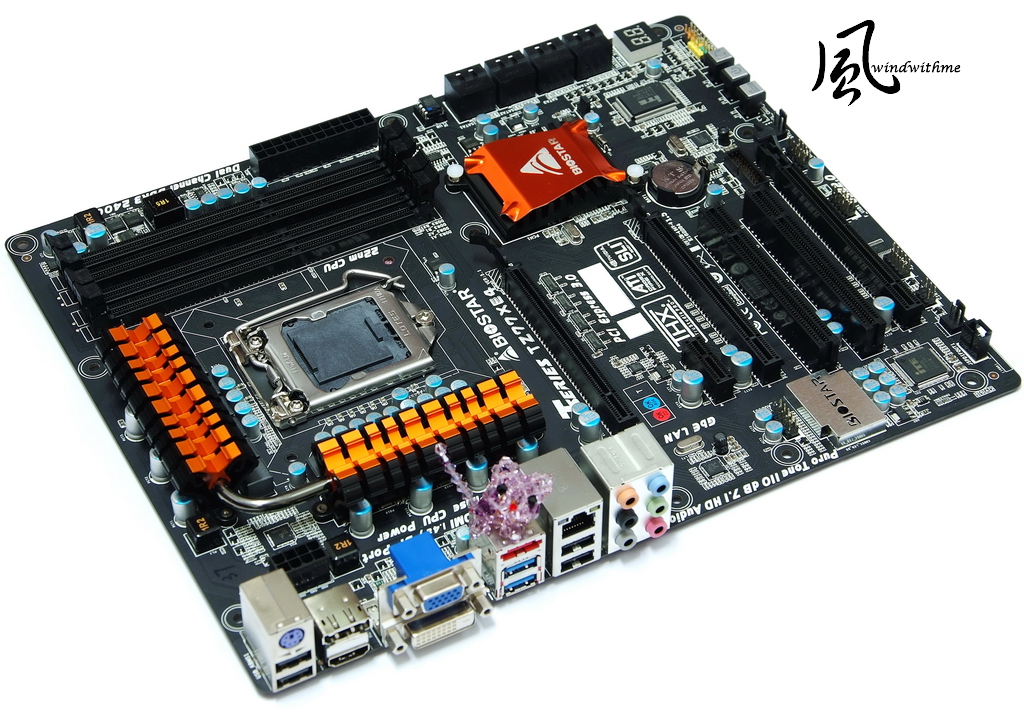
Performance ratio ★★★★★★★★★☆ 86/100
Material ratio ★★★★★★★★☆☆ 82/100
Specification ratio ★★★★★★★★☆☆ 82/100
Appearance ratio ★★★★★★★★☆☆ 77/100
Cost/Performance ratio ★★★★★★★★★☆ 86/100
Ivy Bridge’s structure firstly adopts the 3D transistor technology, so the temperature performance is not as good as that of the last generation.
Moreover, the CPU, 3D performance of built-in GPU, maximum frequency of DDR3 and power consumption all show improved performance to some extent.
Support native USB 3.0.Virtu Universal MVP, Intel Smart Connect / Rapid Start and other new technology specification.
The price of Z77 under many MS manufacturers is not much higher than the base price of the last-generation Z68, lending a more competitive price.
BIOSTAR TSERIES TZ77XE4 is sold at US$150(NT$4380) in U.S. market.
It is just US$ 10~20 higher than the basic-level Z177 of the common ATX size.
TZ77XE4, with its material, design and overclocking performance, gains quite good C/T performance.
TZ77XE3 is sold at US$120 in U.S. market. In spite of the price of the basic-level Z77, its material and specification are the middle-level Z77.
Besides pursuing overclocking performance, BIOSTAR often gets favorable balance in C/P value.
If there will be the more advanced Z77 version that enhances the network card or audio card, it should be the better Z77 option for the users

Windwithme will share the performance of Intel Core i5-3450 or 3570K later.
The newest iPad hasn’t been sold in Taiwan till now, so the author asked a friend in Singapore to buy one for me.
The author will share about the comparison between iPad 1 and iPad 3 in the future


This review is also in my blog WIND3C, Any comments are welcome.
-
Intel Core i7-3770K overclocking performance
CPU 100 X 48 => 4800MHz 1.290V
DDR3 2400 CL10 11-11-27 1T 1.608V
GPU HD 4000 1150MHz
Hyper PI 32M X8 => 12m 02.920s
CPUMARK 99 => 756
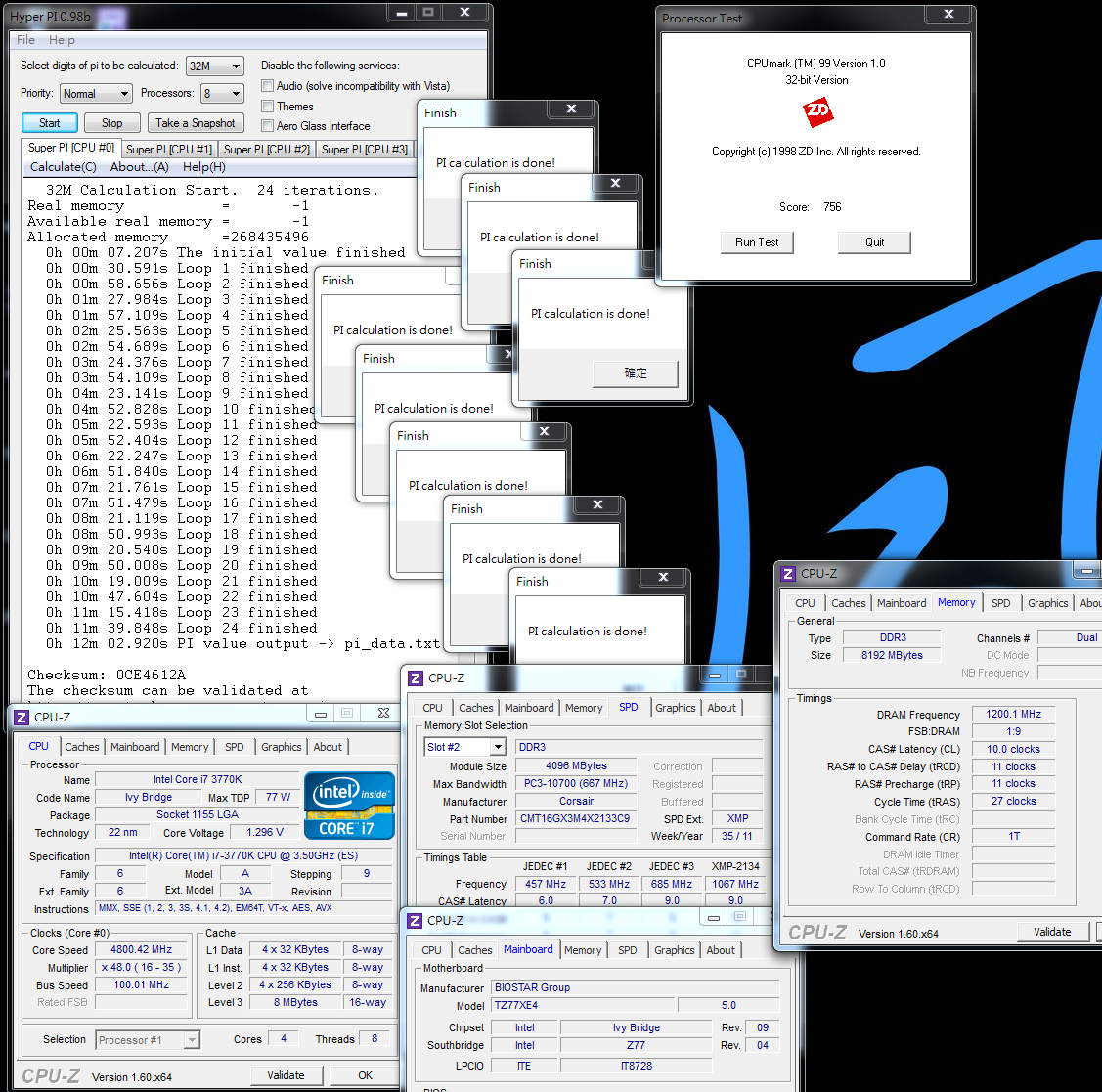
The performance scores of 3770KOC 4.8GHz in Hyper PI and CPUMARK 99 are almost equal to the performance around 2700K OC 4.9GHz after comparison
Nuclearus Multi Core => 33339
Fritz Chess Benchmark => 37.82 /18153
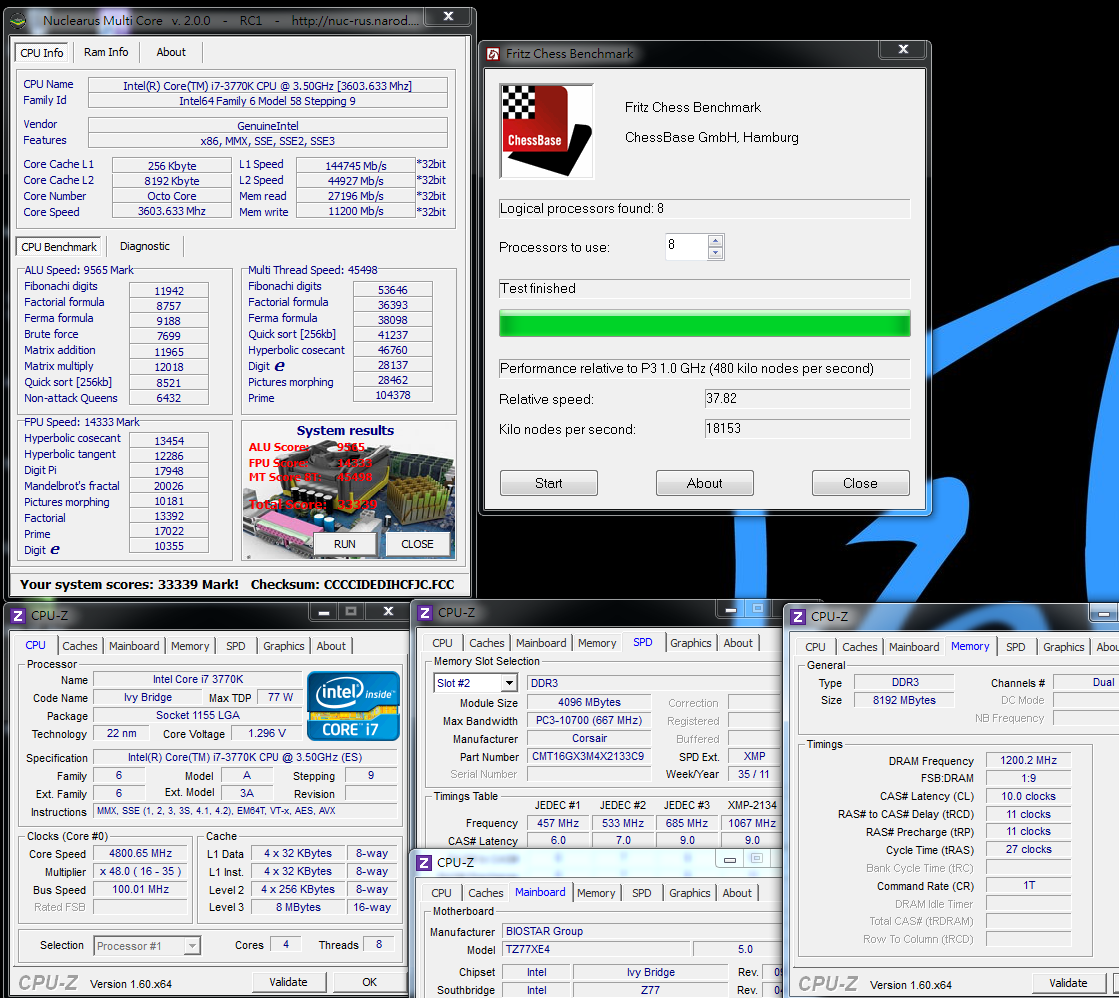
The performance score obtained by Fritz Chess Benchmark falls in the level around 2700K 4.95GHz
CrystalMark 2004R3 => 372168
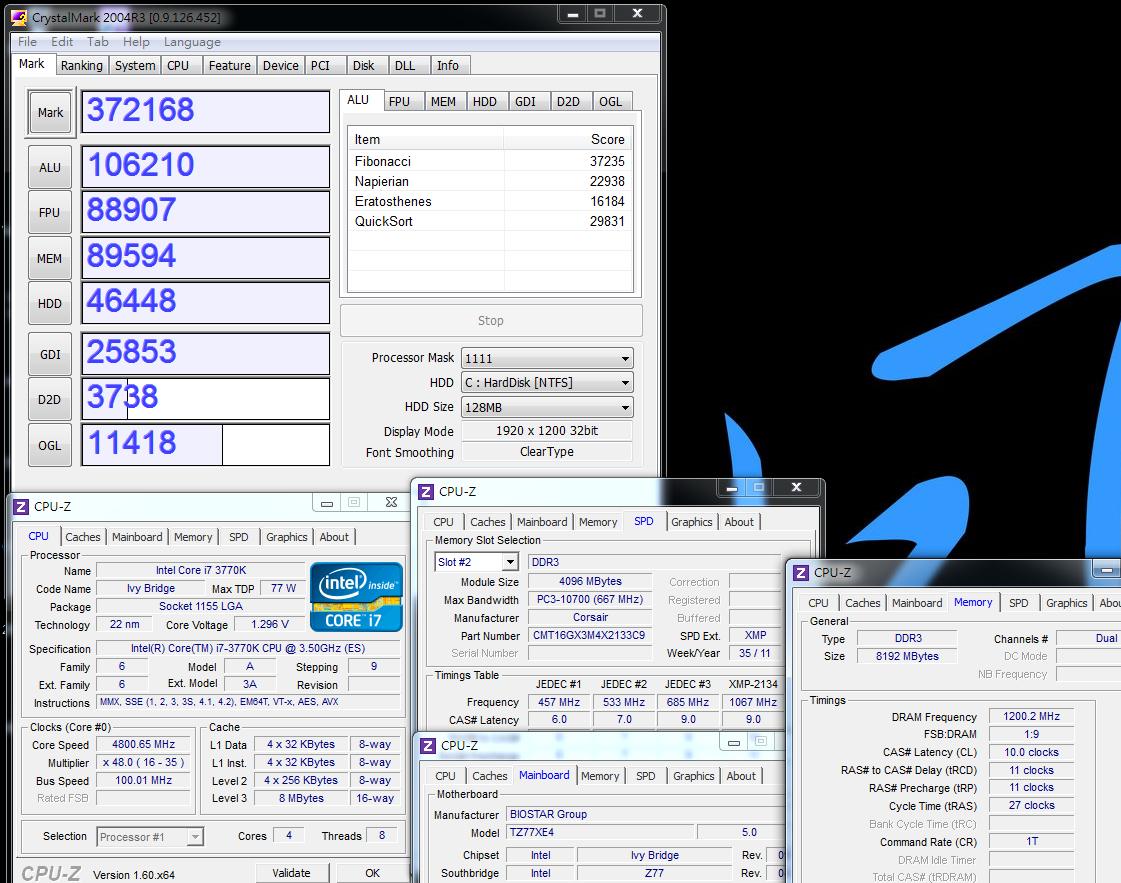
CINEBENCH R11.5
CPU => 9.80 pts
CPU(Single Core) => 2.04 pts

2700K OC 5GHz causes the CPU => 9.74 pts / CPU (Single Core) => 2.03 pts
Among the CPU test items of CINEBENCH R11.5, 3770K OC 4.8GHz gets better performance in single thread and 4C8T
FRYRENDER
Running Time => 3m 55s
x264 FHD Benchmark => 28.5

PCMark Vantage => 26118
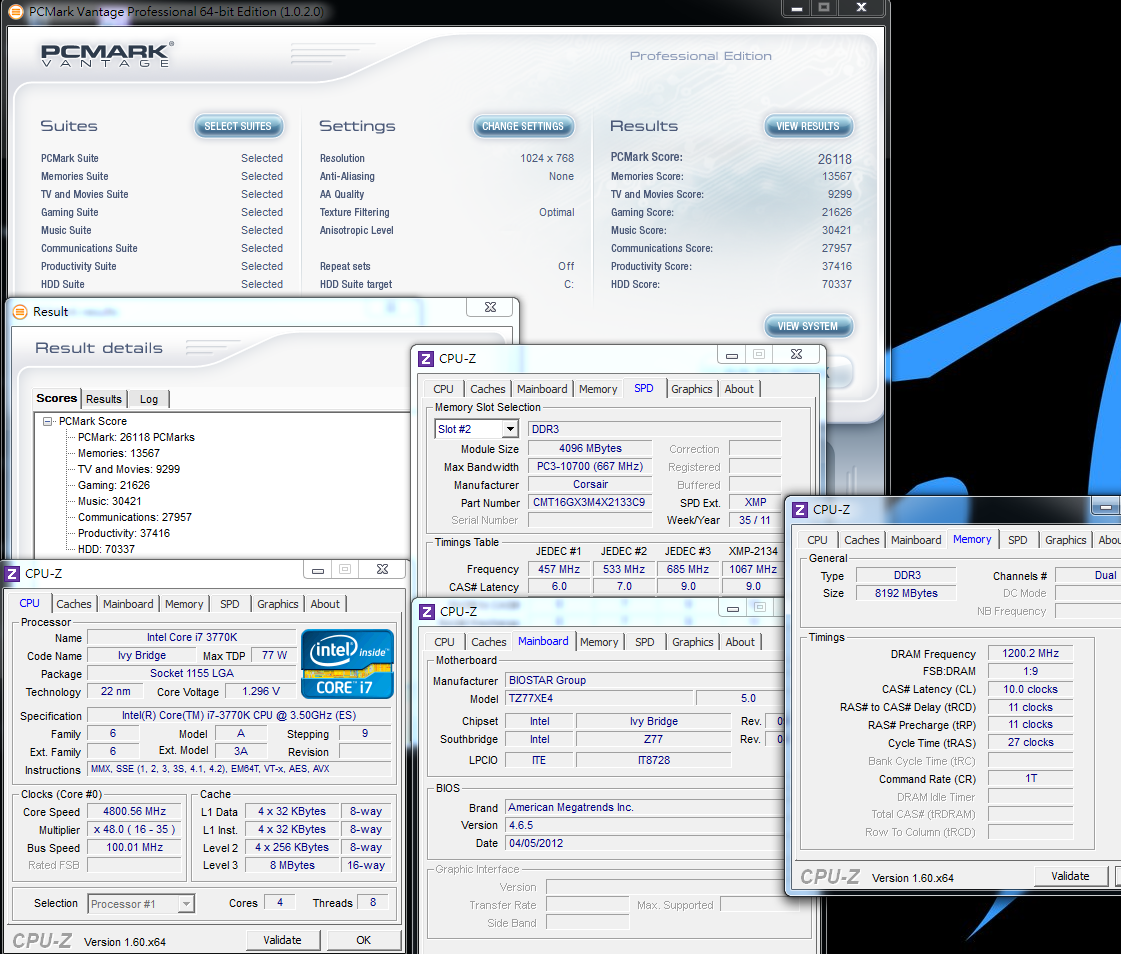
From above test, the performance of Core i7-3770K when overclocking to 4.8GHz almost equals to the performance of the last-generation Core i7-2700K when overclocking to 4.9~5GHz.
That is to say, given the same frequency and specification, the performance obtained by Ivy Bridge is 100~200MHz higher than that of Sandy Bridge.
So we can consider the Ivy Bridge of as the upgrade of Sandy Bridge.
The CPU processing is increased to 22nm, and the existent technologies are improved in the new version.
The built-in GPU support with 3-export and Virtu Universal MVP are all new useful features.
DRAM bandwidth test
DDR3 2400.4 CL10 11-11-27 1T
ADIA64 Memory Read - 24893 MB/s
Sandra Memory Bandwidth - 28733 MB/s
MaXXMEM Memory-Copy - 27807 MB/s

DDR3 2600.4 CL11 12-12-27 2T
ADIA64 Memory Read - 25433 MB/s
Sandra Memory Bandwidth - 30558 MB/s
MaXXMEM Memory-Copy - 28481 MB/s

The structure of Sandy Bridge can adjust DDR3 2133 at maximum when the external frequency of CPU is the default value of 100MHz.
If adopted with the external frequency of overclocking CPU, Sandy Bridge may reach around DDR 2300.
It is the greatest advantage of Ivy Bridge’s structure, and the Memory Controller is much better than that of last generation.
Given 3770K and 100MHz of CPU’s default external frequency, it can reach around DDR3 2400~2666.
With powerful MB and DDR3, it will possibly reach DDR3 2800.
The above two test figures are the bandwidth performance of DDR3 2400 1T and 2600 2T, showing that the DDR3 frequency is greatly improved.
Intel HD Graphics 4000 performance test
GPU frequency is 23 by default. When overclocking to 30(equal to 1500MHz), 3DMark Vantage => P5755

StreetFighter IV Benchmark
1280 X 720 => 116.13 FPS

-
The upper side of the audio chip has a metal cover with BIOSTAR Logo printed, which shines red when powered on.
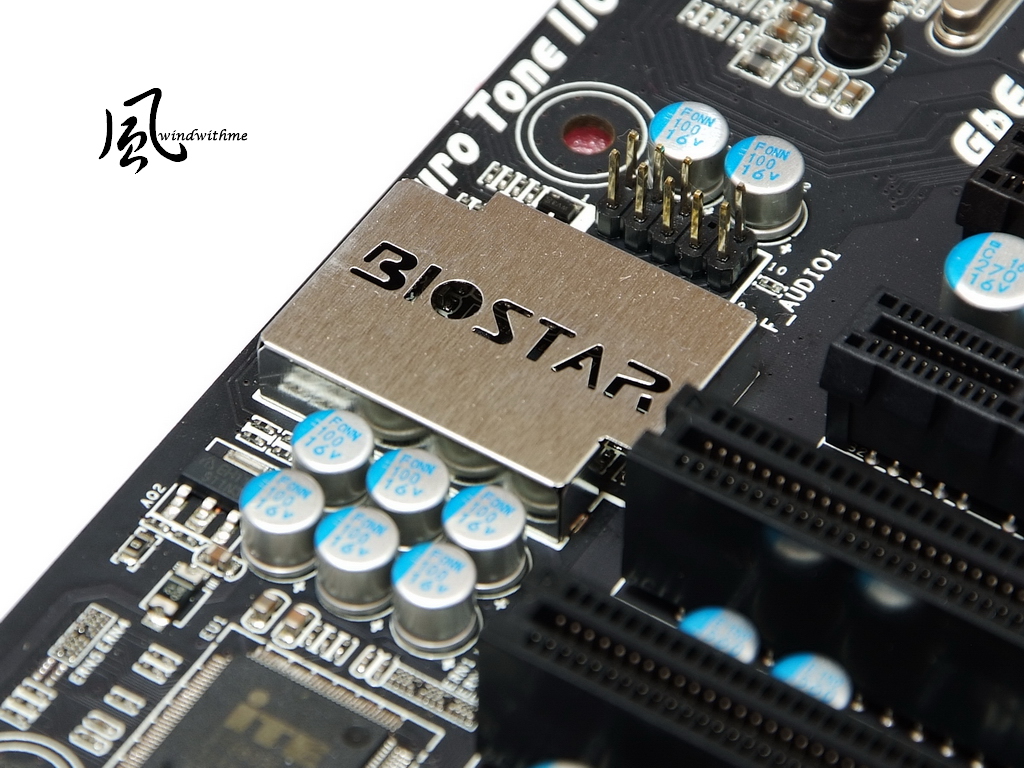
With the BIOSTAR radiation module shell and cutting design, the radiation module on the upper side is orange,
which is the common color shown on the motorcycles in KYMCO Mega G5, Racing or SUZUKI NEX 8 Hours Champion.
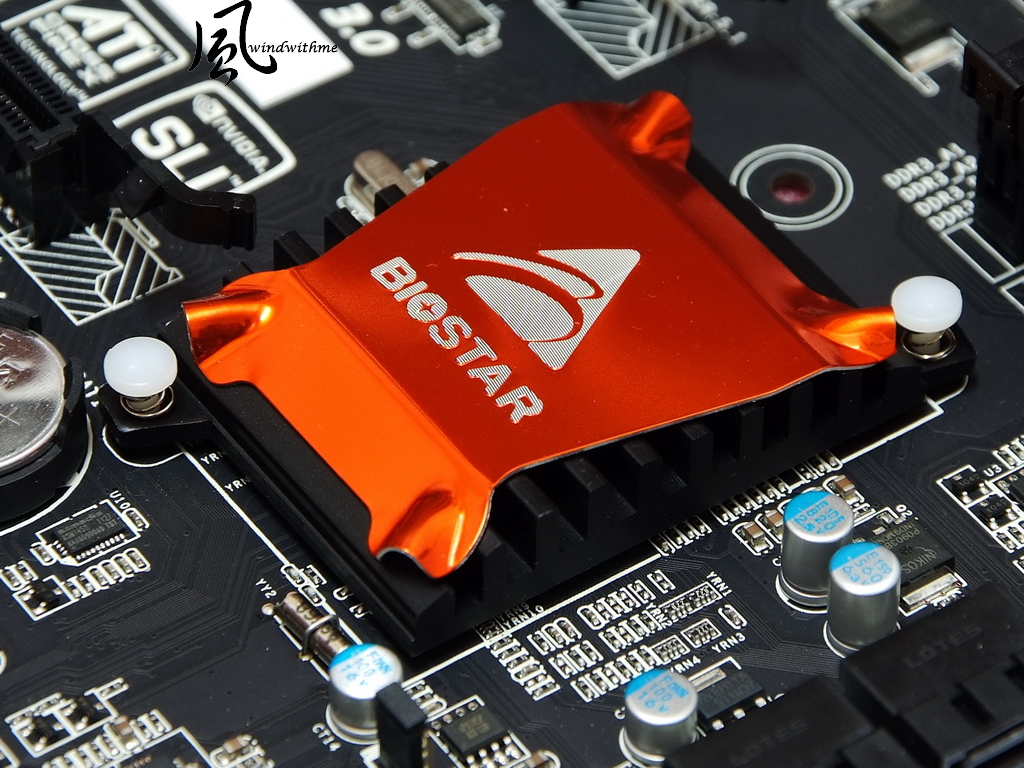
Below are the instructions for using Intel Core i7-3770K on BIOSTAR UEFI interface
CPU information and the related technology page
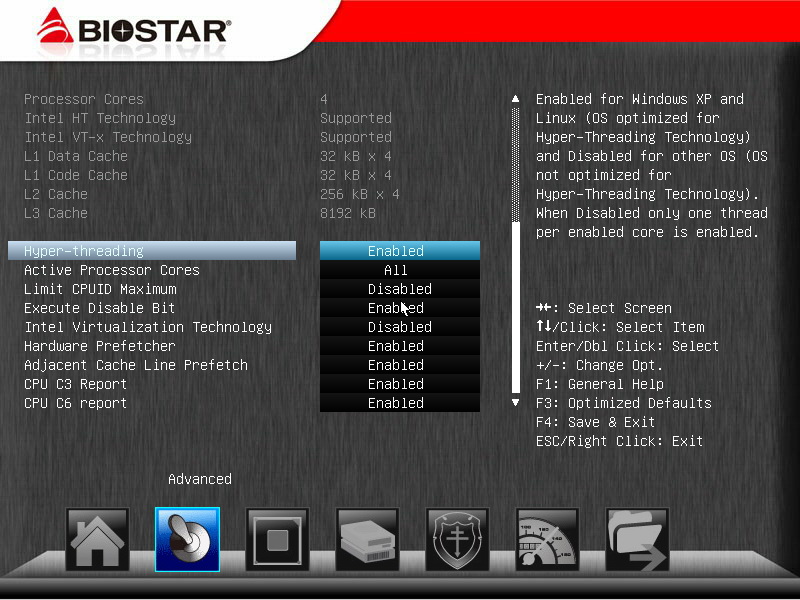
O.N.E calibration page
The frequency multiplication of the CPU Ratio is 48, i.e. 3770K will be operated by 4800MHz
To lock the external frequency of CPU as 100MHz, the following two options should be done
Turn off Clock Spread Spectrum and start up Internal PLL Override
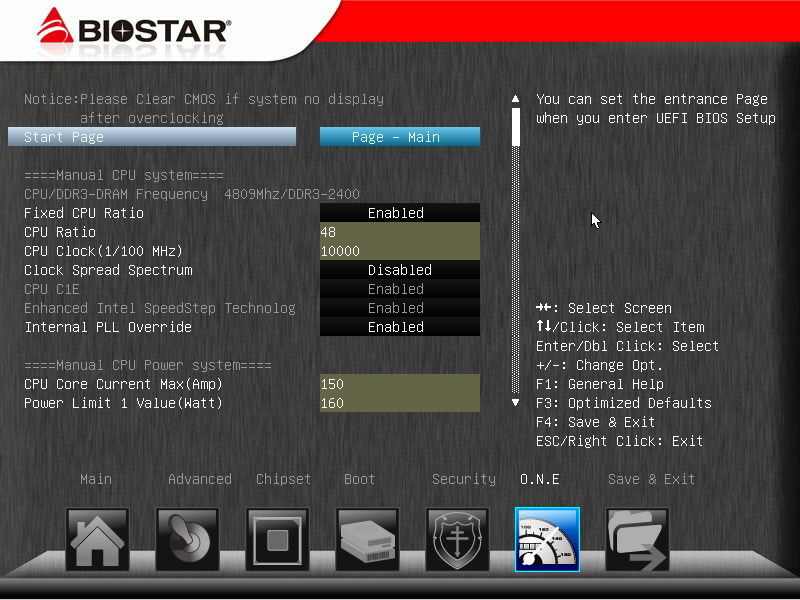
Graphics Core Ratio Limit is the frequency of the built-in GPU in CPU
The algorithm of 23 is 23 X 50 => 1150MHz. In the sample figure below, it adopts the default frequency of built-in HD 4000 for 3770K

For DRAM frequency and parameter settings, generally, smaller value will obtain higher performance.
Set it as DDR3 2400 CL10 11-11-27 1T, and adjust other detailed options to optimal setting values.
The user can increase the frequency and adjust the parameters based on the DDR3 property, so as to achieve the effect of increasing DDR3 bandwidth.
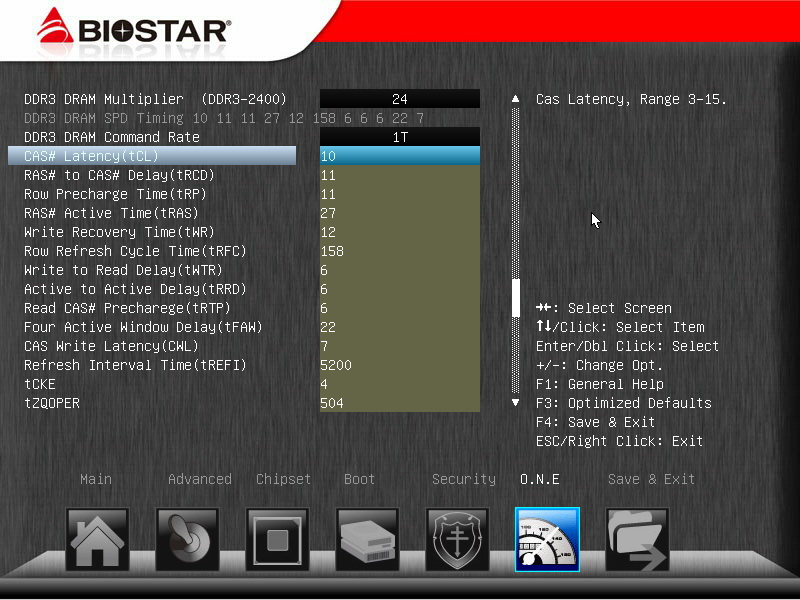
Voltage page
There are four types of CPU VCore Mode, SPEC Volgate/Auto/Offset Mode/Fixed Mode
CPU VCore Offset -0.200~+0.520V
CPU VCore Fixed 1.000~1.790V
For the purpose of overclocking, the major change here is the CPU voltage.
In the sample figure, the CPU Vcore is fixed as 1.290V.
Making slight adjustment based on the radiation ability and CPU property are the two major foundations for overclocking CPU.

DRAM Voltage 1.300~2.112V
Vcc S Voltage 0.900~1.605V
When DDR3 is overclocked to 2400~2666, generally, it needs to increase the voltage to 1.6~1.65V or higher.
The major function of Vcc S Voltage is to increase Stability when DDR3 overclocking is of high frequency.

UEFI interface provide 5 sets of functions for file access.
The users can store or read the data based on the default settings, which can save setting time.
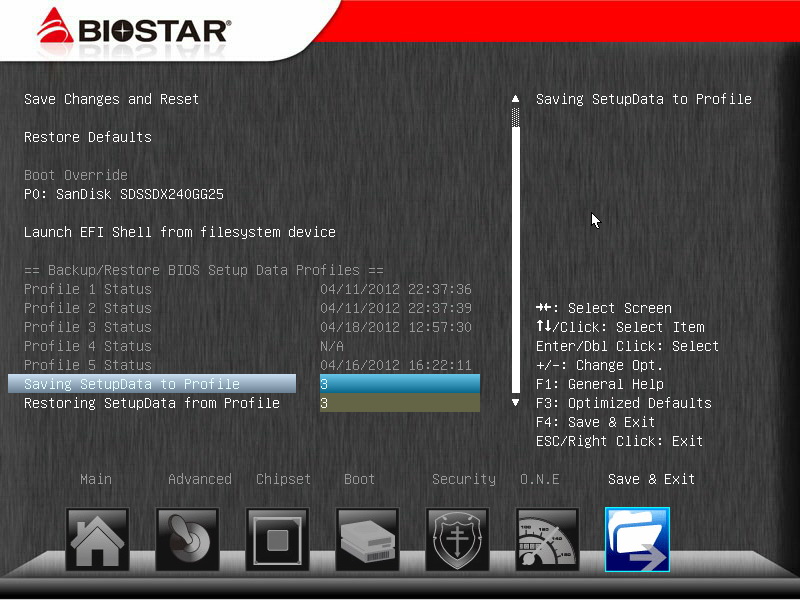
BIOSTAR doesn’t provide gorgeous screens for the UEFI interface but in plain color instead.
The advantage is the fast startup speed, which is as fast as its own BIOS. It just takes a blink to enter the Windows7 screen.
Some MB brands use too many programs or pictures in UEFI interface, causing slow startup speed.
Whether it is shortcoming or advantage depends on the user’s preference.
Regarding the enhancement of BIOSTAR’s UEFI, windwithme thinks it will be better if the Multilanguage is supported.
Test platform
CPU: Intel Core i7-3770K
MB: BIOSTAR TZ77XE4
DRAM: CORSAIR DOMINATOR-GT CMT16GX3M4X2133C9
VGA: Intel HD Graphics 4000
HD: Intel 520 Series 120GB
POWER: CORSAIR AX650W
Cooler: CORSAIR Hydro Series H100
OS: Windows7 Ultimate 64bit

-
Intel released the latest DeskTop platform in April, also known as Ivy Bridge
The CPU of last-generation Sandy Bridge is named with 2 series, while the chipset named with 6 series
The CPU of Ivy Bridge is named with 3 series, and the chipset named with 7 series, both of which are leveled up.
However, the structure of these two CPUs adopts the LGA 1155 slot, which gains better scalability than the product line before.
Same to the previous market positioning of Intel, the Ivy Bridge platform mainly focuses on the middle and high level product line at the very beginning.
Intel Core i5 and Core i7 CPUs are the first modules released.
For the affordable Ivy Bridge CPU for Core i3, you must wait until June at least.
The chipsets commonly sold on the market are the Z77 and H77, and the B75 is adopted by some basic-level MB in a few occasions.
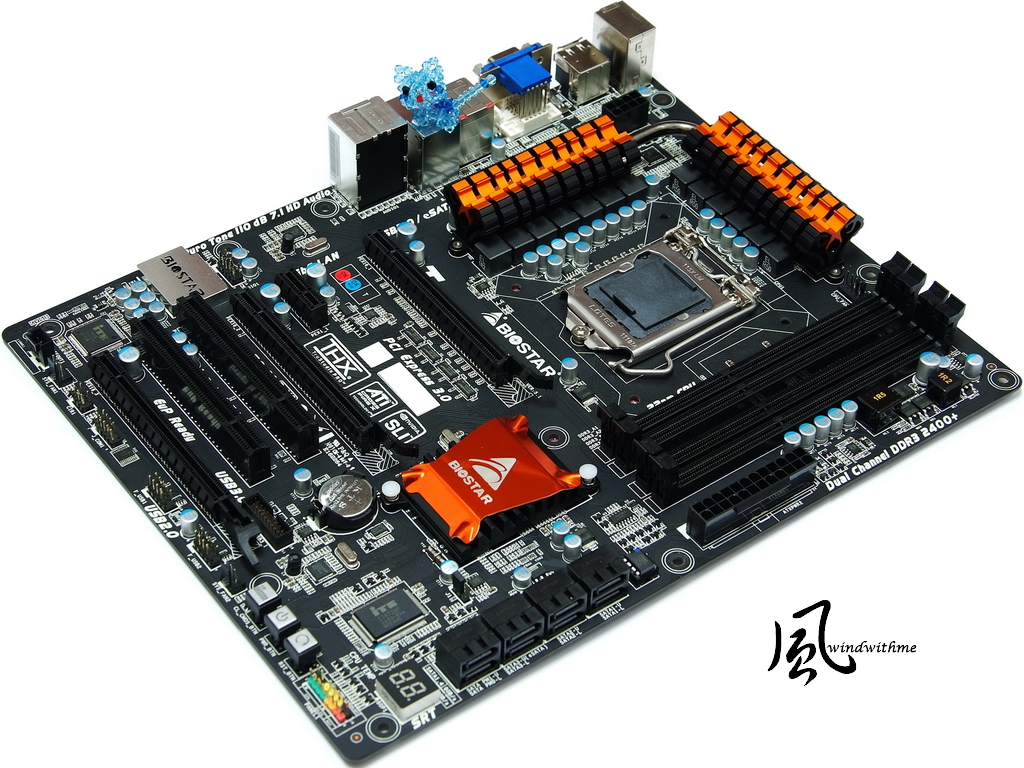
The most advanced chipset supported by Ivy Bridge is Z77, for which BIOSTAR also releases the brand new series, namely, TZ77XE4 and TZ77XE3.
The design material for the new series is different from BIOSTAR’s other product lines.
First is the external package of the product, in which the pattern design is different from the previous pure color series.

Accessories Included:
Product manual, IO board, SLI / CorssFire X bridge, SATA wires and driver

The body of BIOSTAR TZ77XE4, DRAM, PCI and PCB slots are all colored black
PCB is specially coated to increase the texture indirectly, which is also promoted by other manufacturers for some time.

TZ77XE3 also adopts the same appearance design, but the specification is lower than XE4.
Besides, BIOSTAR has other three Z77 products, which colors the black, red and white colors.

The lower left section of the motherboard
1 X PCI-E X16 3.0 supports AMD CrossFireX/nVIDIA SLI technology at most, and the bandwidth is X8 + X8
2 X PCI-E X1
2 X PCI
1 X PCI-E X16 2.0, and the bandwidth is X4
Network chip adopts Realtek RTL8111E
Audio chip Realtek ALC898 supports 8-channel Blu-ray Audio and THX TruStudio Pro technology at most

The lower right section of the motherboard
2 X black SATA, provided by chipset Z77, with SATA3 specification
4 X black SATA,provided by chipset Z77, with SATA2 specification
They can work together to build RAID 0, RAID 1, RAID 5 and RAID 10, and the highest performance depends on the SATA device installed.
2 X black SATA, provided by ASM1061 chipset, with SATA3 specification, supporting AHCI
Power / Reset / clr CMOS buttons and debug LED, and the black section on upper side is the front USB 3.0 slot

The upper right section of the motherboard
4 X DIMM DDR3, supporting 1066/1333/1600/1866(OC)/2133(OC)/2400(OC)/2600(OC)
The maximum capacity supported by DDR3 is 32GB, supporting Extreme Memory Profile technology. The lower side is the 24-PIN power input.

The power supply design has 13 phases in total, including 10 CPU VCORE phases + 1 VCC phase + 2 IGD phases
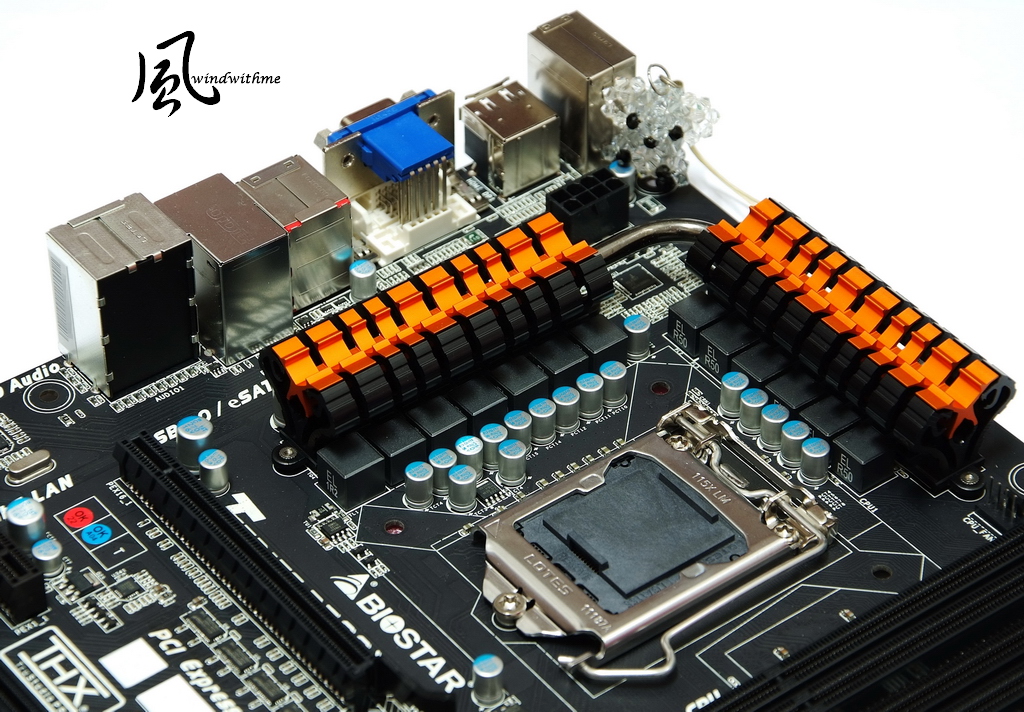
IO
1 X PS/2 keyboard
1 X D-Sub / DVI-D / HDMI / DisplayPort
4 X USB 2.0(black)
2 X USB 3.0(blue)
1 X eSATA2 (red)
1 X RJ-45 Network hole
6 X Audio hole

-
CPU Full Speed by running LinX - 145W
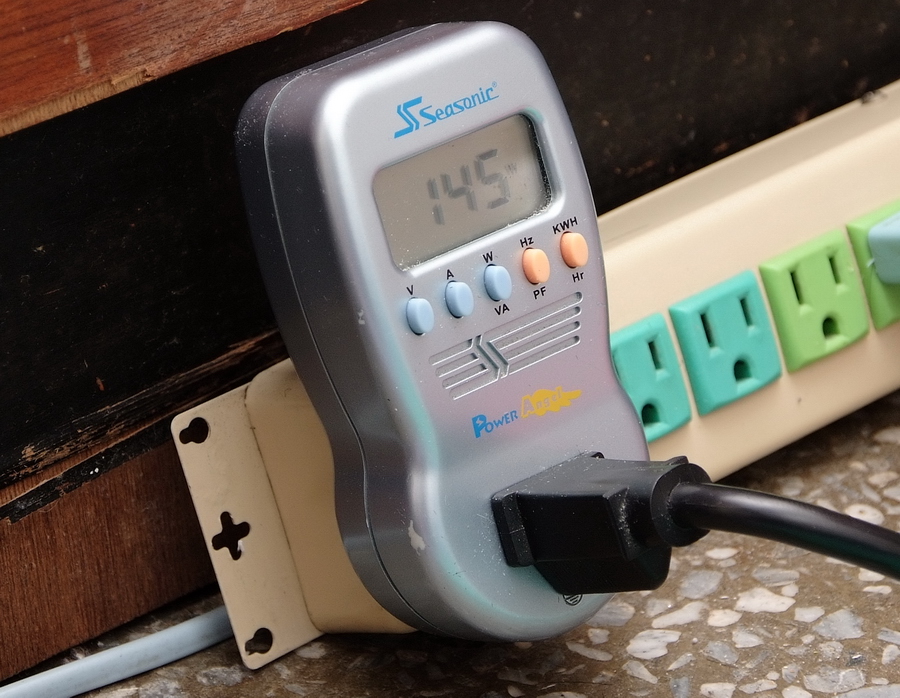
3770K has great advantage in power consumption. It should be 22nm manufacturing credit.
Entering to OS desktop is 15W lower than past high end platform. Full speed is 25~30W lower. This is one of Ivy Bridge advantages.
Intel HD Graphics 4000 Performance Test
GPU default in BIOS is 23, 1150MHz
3DMark Vantage => P4745
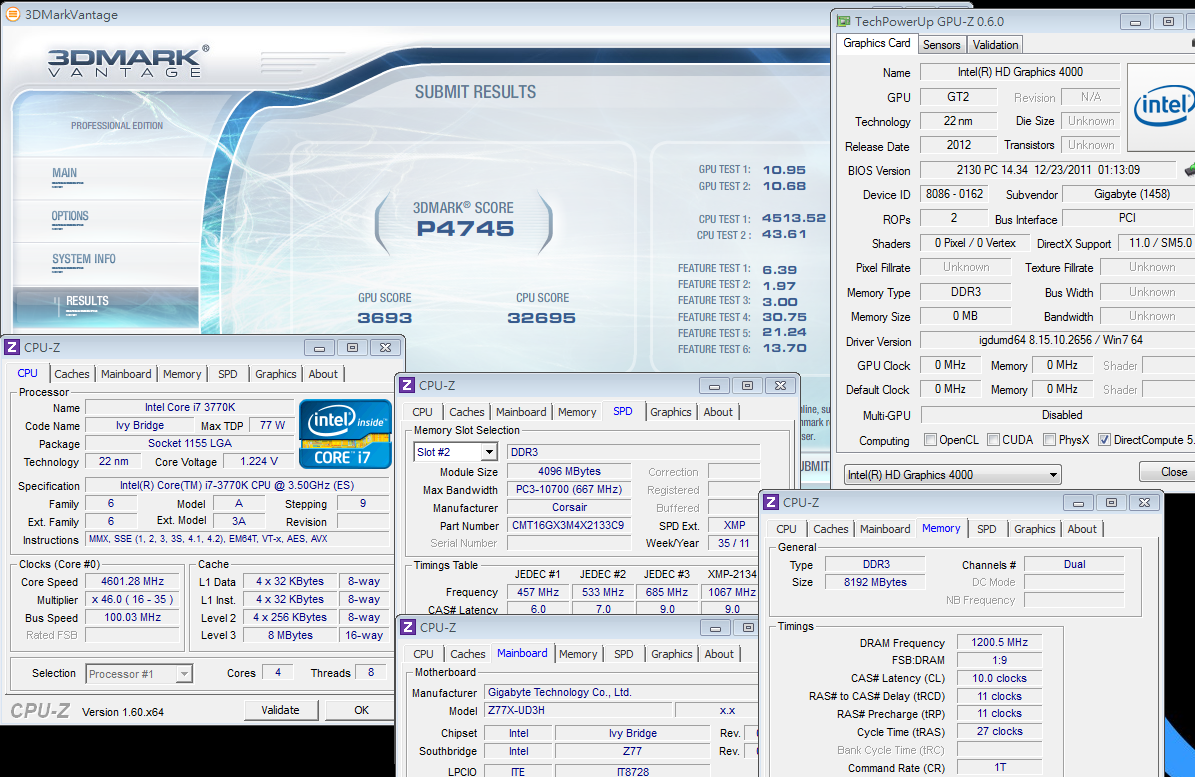
StreetFighter IV Benchmark
1280 X 720 => 98.93 FPS

FINAL FANTASY XIV
1280 X 720 => 1698

Intel GPU - HD 3000 and HD 4000 comparison. CPU and GPU are both in default frequency.
3770K 3DMark Vantage is 4100 and 2770K is 2500分.
StreetFighter IV Benchmark high resolution 1920 X 1080, 3770K is 50fps and 2700K is 31fps.
New generation HD Graphics 4000 3D performance is about 60% higher than HD Graphics 3000.
GIGABYTE Z77X-UD3H WiFi
Pros
1. Z77 white design and boot screen are better than the past.
2. UEFI BIOS provides two BIOS interfaces.
3. Exclusive BT4.0 /Atheros WiFi card can provide wide connectivity to all mobile devices.
4. Built-in debug LED, 3 buttons and unique mSATA SSD slot.
5. Back IO panel provides USB 3.0 and build in personal preferred Atheros LAN and VIA audio chip.
Cons
1. DDR3 2600 compatibility need to be improved.
2. UEFI GUI interface make booting speed is lower than traditional BIOS few seconds. Future Windows8 will fine tune UEFI.

Performance ★★★★★★★★☆☆ 82/100
Components ★★★★★★★★★☆ 88/100
Specification ★★★★★★★★★☆ 86/100
Appearance ★★★★★★★★☆☆ 82/100
C/P Value ★★★★★★★★★☆ 88/100
Let’s look back to Core i7-3770K CPU again.
Performance, temperature and power consumption performance are improved mostly, but the temperature is not as good as expectation.
22nm really lower the power consumption, and CPU performance is about 200MHz higher than SNB.
IGP HD 4000 3D performance is 60% improved. It makes integrated GPU can support mid to low 3D software.
This is the first time for CPU using 3D transistors technology. The temperature after OC is higher than 2700K.
Let’s move to Z77 chipset. It has several advantages comparing to Z68. All MB brands launched rich Z77 product lines.
Native USB 3.0, Intel Smart Connect / Quick Sync 2.0, Lucid Universal MVP and so on.
The most concern point is price. Z77 price is close to Z68. Even some Z77 boards price is lower than Z68.
Now, you can see the benefits of Z77 chipset.
GIGABYTE Z77X-UD3H WiFi is mid-range of Z77 market, but the spec and components are complete.
They implement many designs from X79 and Z68 to Z77X-UD3H. Especially, the BT4.0/WiFi card are distinguishing exclusive feature
The price is a little higher than Z68X-UD3H, but the spec is much better. It makes Z77X-UD3H be a good choice in mid-end market.

This review is also in my blog WIND3C, Any comments are welcome.
-
CPU 100.3 X 46 => 4601.24MHz(Disable Turbo Boost and C1E)
DDR3 2401.2 CL10 11-11-27 1T(Enable XMP mode)
Hyper PI 32M X8 => 12m 25.166s
CPUMARK 99 => 725
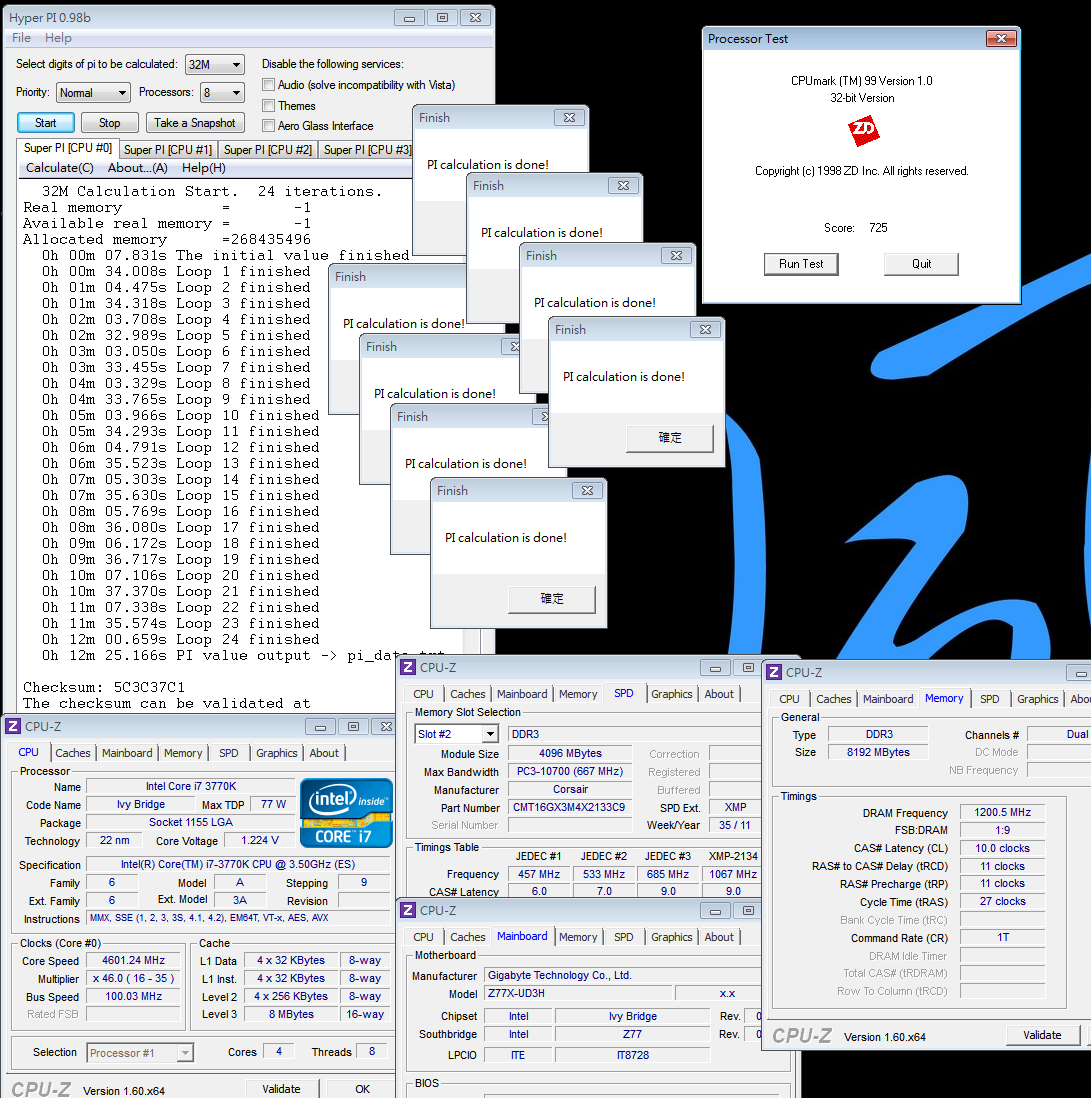
Nuclearus Multi Core => 32856
Fritz Chess Benchmark => 36.22/17384

CrystalMark 2004R3 => 365211

CINEBENCH R11.5
CPU => 9.35 pts
CPU(Single Core) => 1.96 pts

FRYRENDER
Running Time => 4m 01s
x264 FHD Benchmark => 27.3
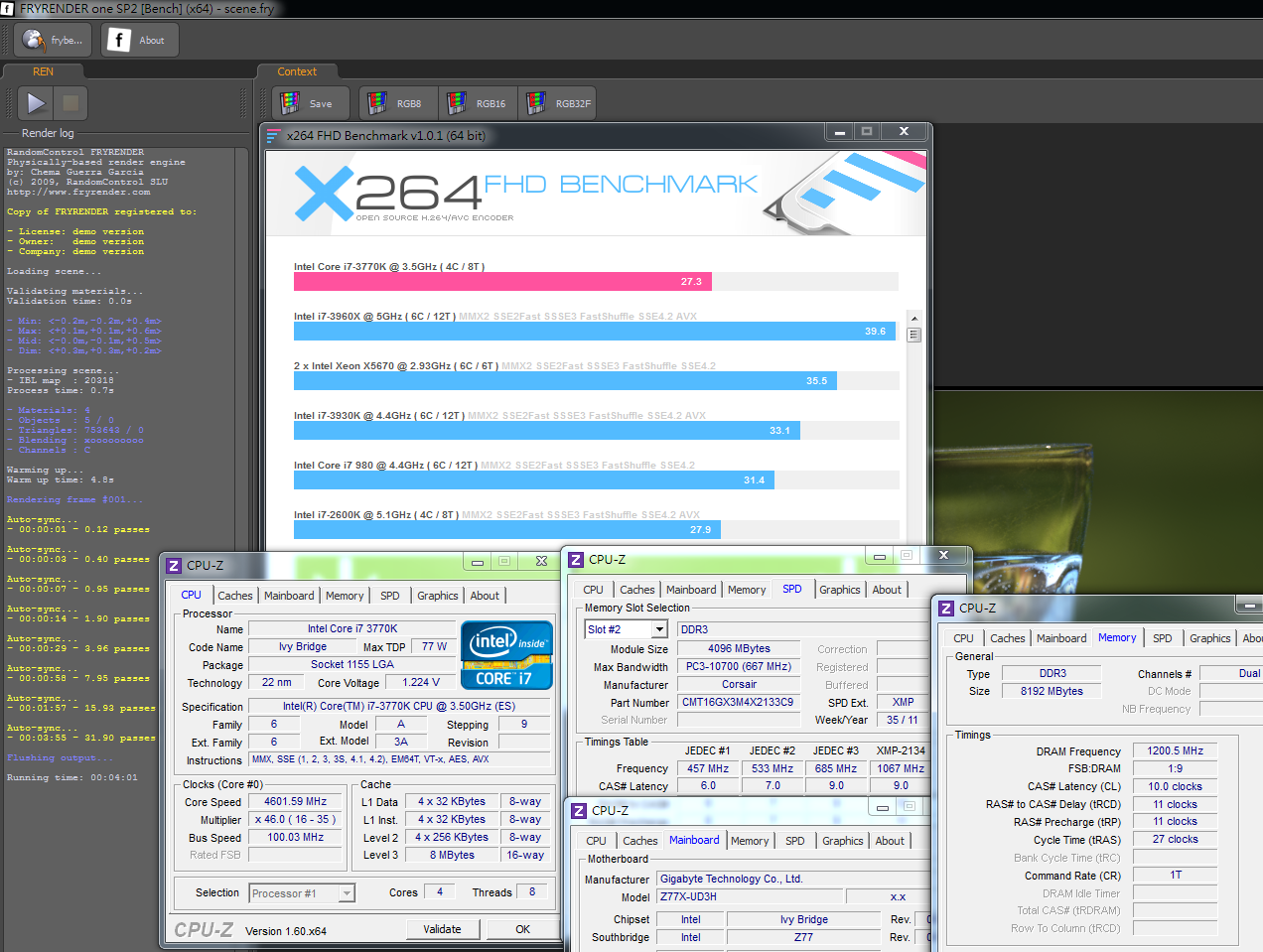
PCMark Vantage => 24906

After OC, 3770K single thread performance increases 17~18% and 4C8T full speed performance increases 17~19%.
If we compare 3770K to 2700K, 4.6GHz 3770K performance is close to 4.8GHz 2700K.
This is Ivy Bridge new structure strength.
DRAM Bandwidth Test
DDR3 2401.2 CL10 11-11-27 1T
ADIA64 Memory Read - 23337 MB/s
Sandra Memory Bandwidth - 27784 MB/s
MaXXMEM Memory-Copy - 27482 MB/s

As default CPU clock, LGA 1155 Sandy Bridge can achieve DDR3-2133
LGA 2011 Sandy Bridge-E can reach DDR3-2400.
You can see the different max DDR3 frequency in same Sandy Bridge memroy controller.
This time, LGA 1155 Ivy Bridge can achieve DDR3 2400~2666 up.
Ivy Bridge memory controller makes the best standard of high frequency high performance.
Temperature (Room Temp. is around 30˚C)
Enter to OS Desktop - 34~40

CPU Full Speed by running LinX - 77~83
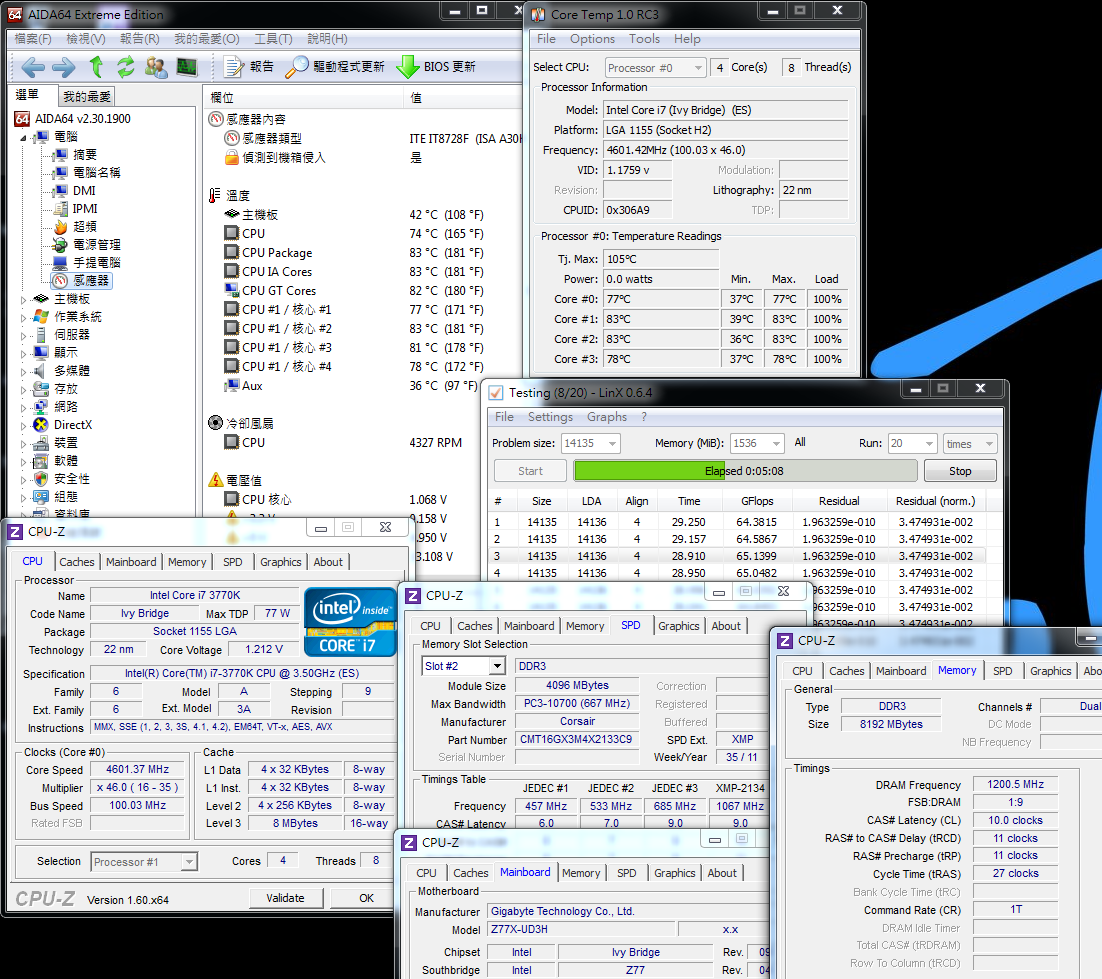
3770k temperature increases 6~12 when entering to OS desktop and 10~23 as full speed.
If comparing to default and OC 4.6GHz, the increased temperature is in acceptable range.
As 22nm manufacturing, the temperature is higher than SNB.
It may cause by Intel first using 3D transistors technology. This new technology makes 22nm temperature is not lower.
The temperature performance is a fly in the ointment.
Power Consumption
Enter to OS Desktop - 64W
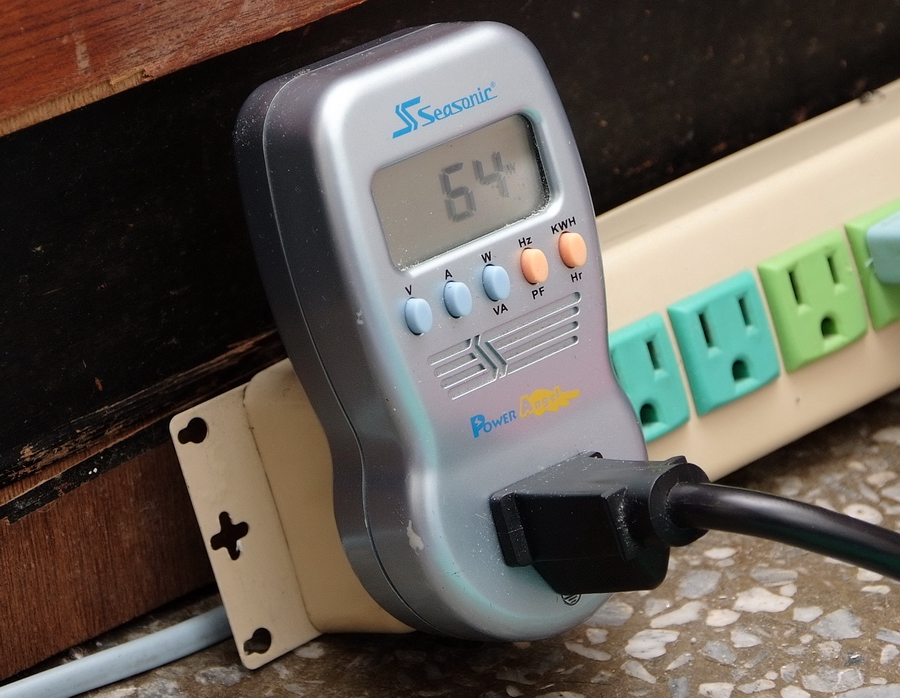


Overclocking Analysis of the Gold-ThemedECS Z77H2-A2X Motherboard
in Ivy Bridge (Z77) OC
Posted
The large gold heat-dissipation module shows an emphasis on providing better cooling capacity.
If gold had been used for the color of the heat pipe in middle, the overall appearance would be more consistent.
The heat sink for the Z77 chipset is not small and the spatial design is also good.
The special characteristic of the Black Extreme name printed on the high-end ECS series is that an orange pattern will be displayed as the temperature rises to a certain range.
The pins for the LGA 1155 CPU use a 15μ gold connecting material,
which is also used for the DDR3 DIMM to emphasize the provision of materials that on average have more than three times the oxidation resistance,
heat resistance and scratch resistance of ordinary materials.
The main view of the ECS UEFI shows four graphical interface functions.
In total, 10 different languages are supported including traditional Chinese and simplified Chinese.
Advanced Interface
M.I.B X
The main choices are for CPU and DRAM functions, clock speed, parameters or voltage settings.
Voltage Details
CPU Voltage +0.010 -- +0.630 V
AXG Voltage +0.010 -- +0.630 V
IMC Vlotage +0.011 -- +0.945 V
DIMM Voltage +0.010 -- +0.630 V
System Agent Voltage +0.010 -- +0.630 V
PCH Voltage +0.010 -- +0.630 V
CPU PLL Voltage +0.010 -- +0.630 V
The CPU multiplier default is 47, or in other words, 3770K for 4700MHz operation
The Graphics Core Ratio Limit is the clock speed of the CPU’s internal GPU
The 23 algorithm is 23 X 50 => 1150MHz, and the figure shows the default 3770K clock for the internal HD 4000
DDR3 Setting Page
Supporting XMP technology, the DDR3 clock default is 2400
The main parameters are CL10 11-11-28 1T
In the Z77H2-A2X, ECS has opened a lot more DDR3 parameters than in their own X79R-AX
Page with CPU information and related technology
You can choose to open a few CPU cores.
I personally am accustomed to turning off the power saving C3/C6 and C1E in low-bandwidth overclocking mode to find the best settings.